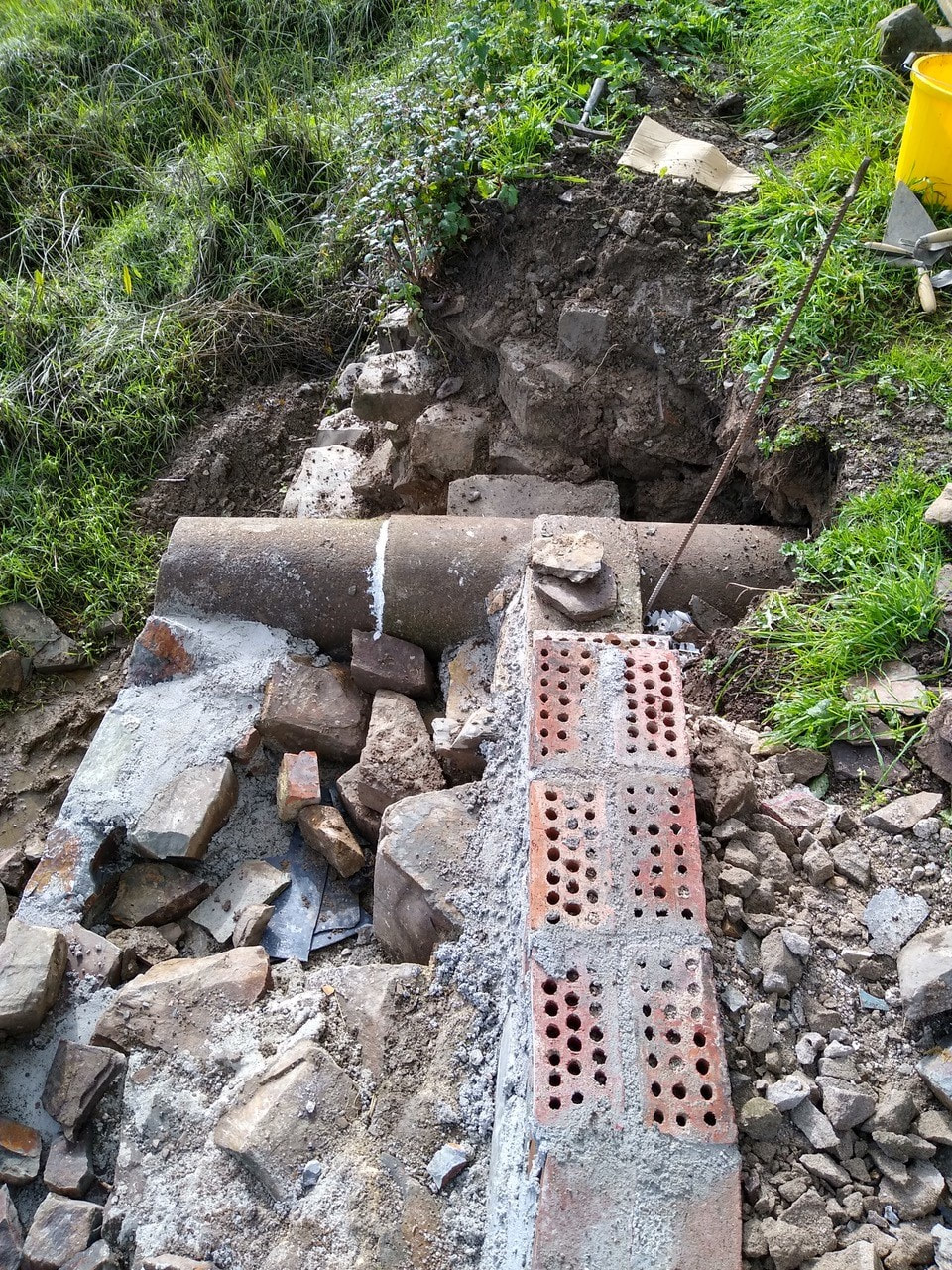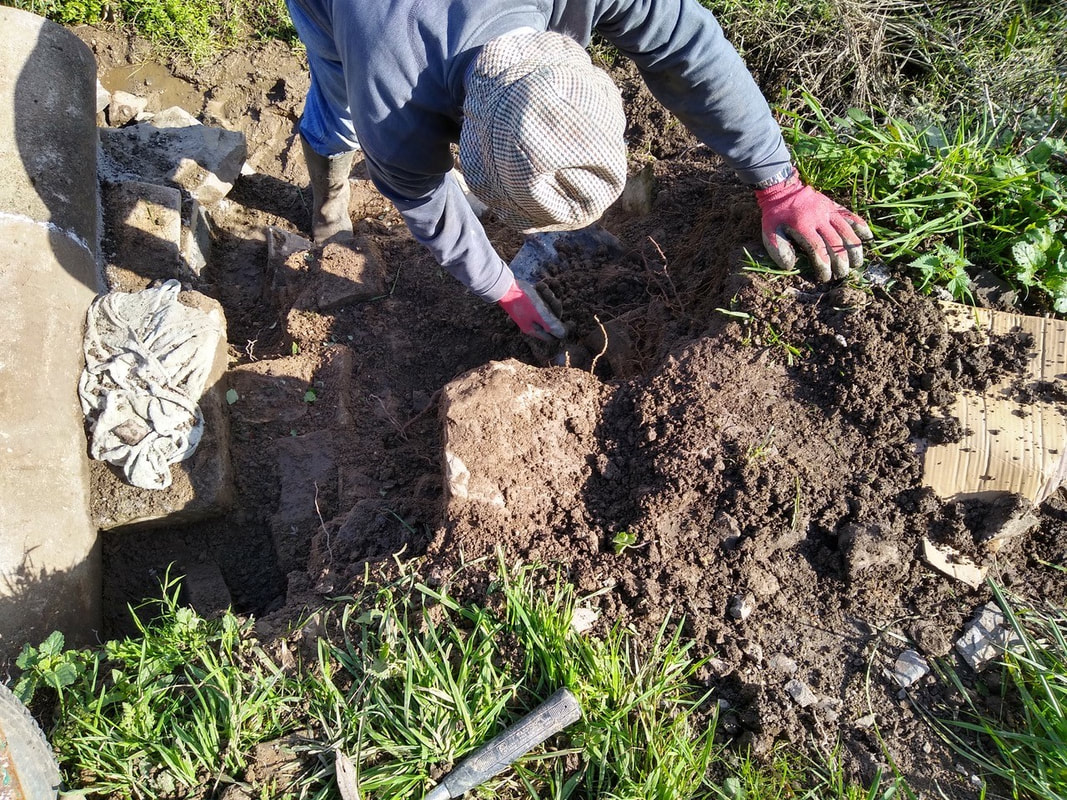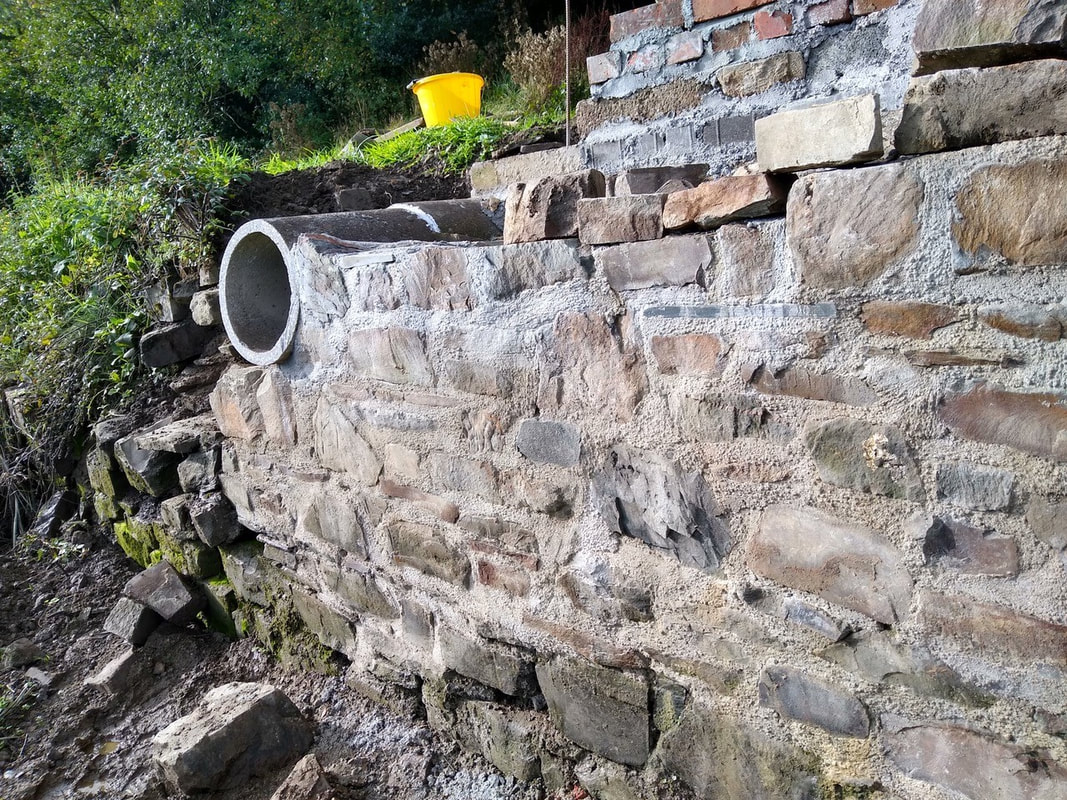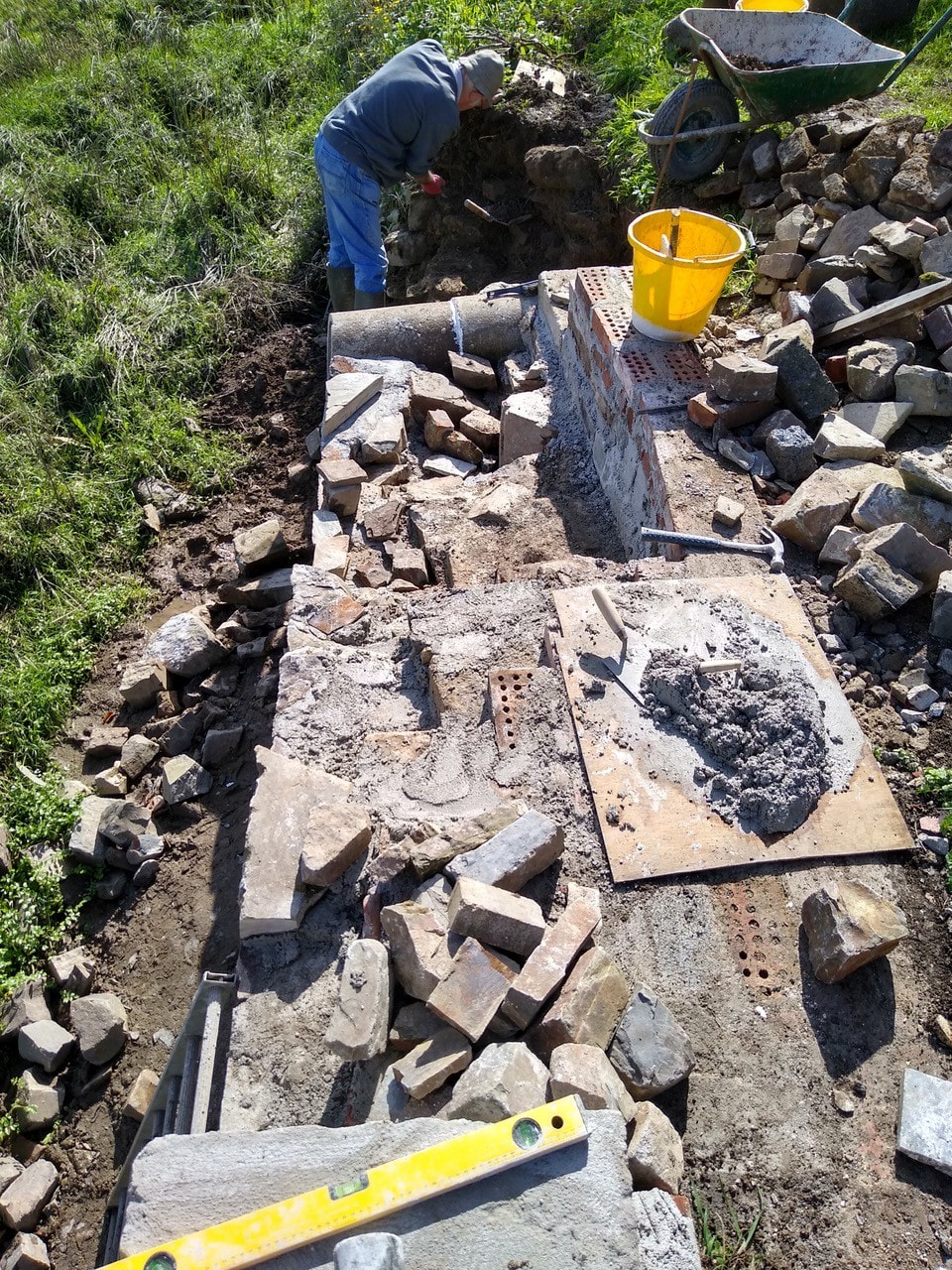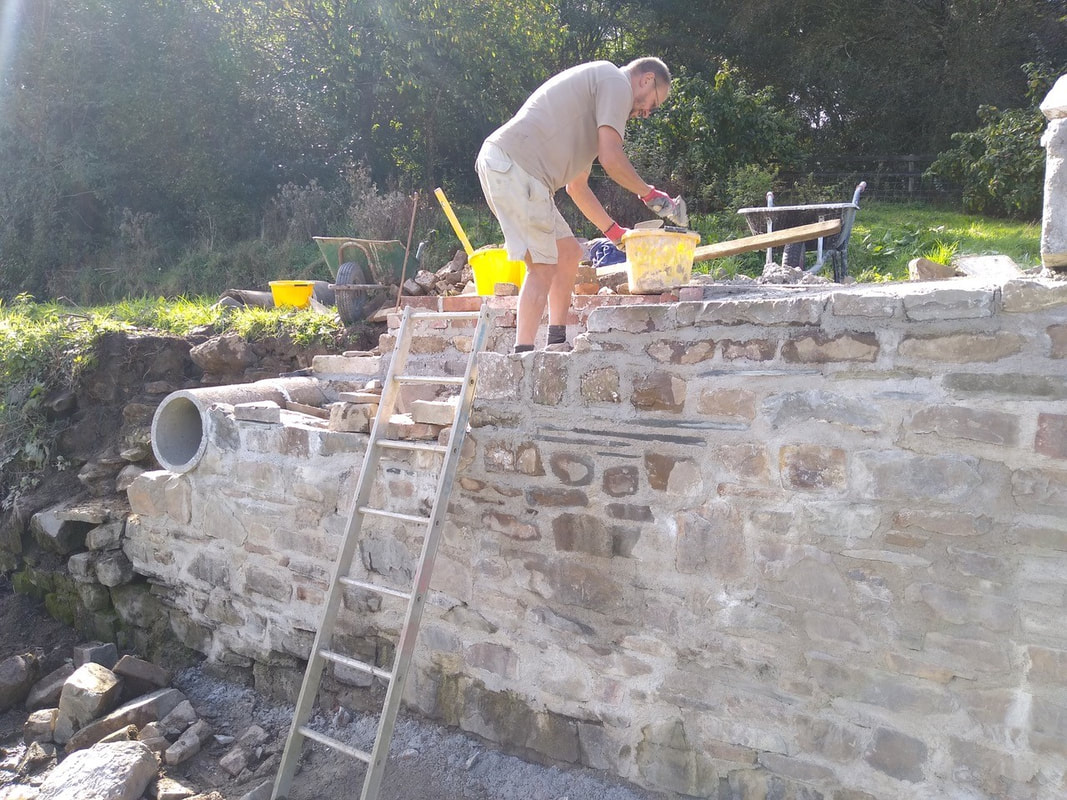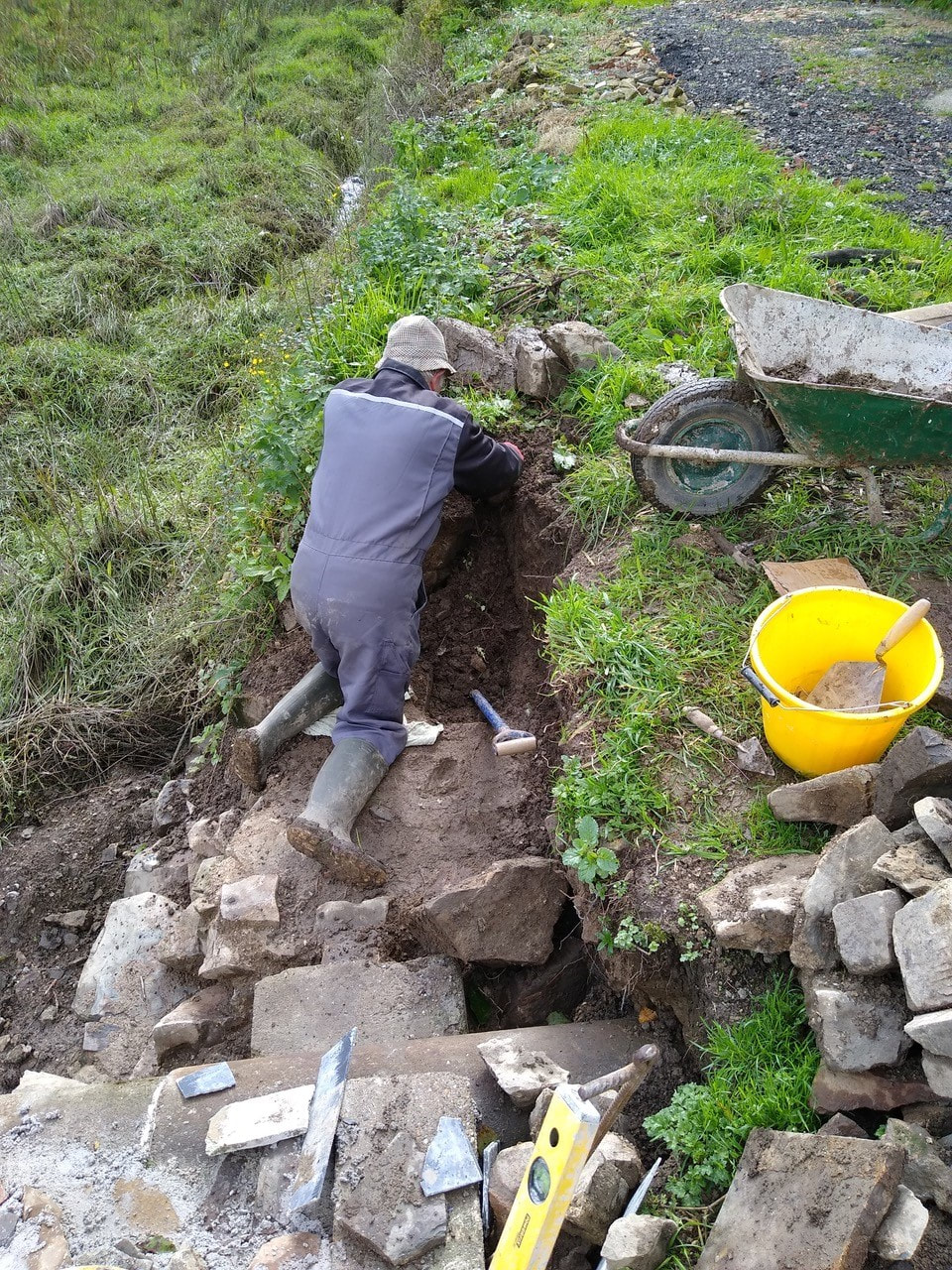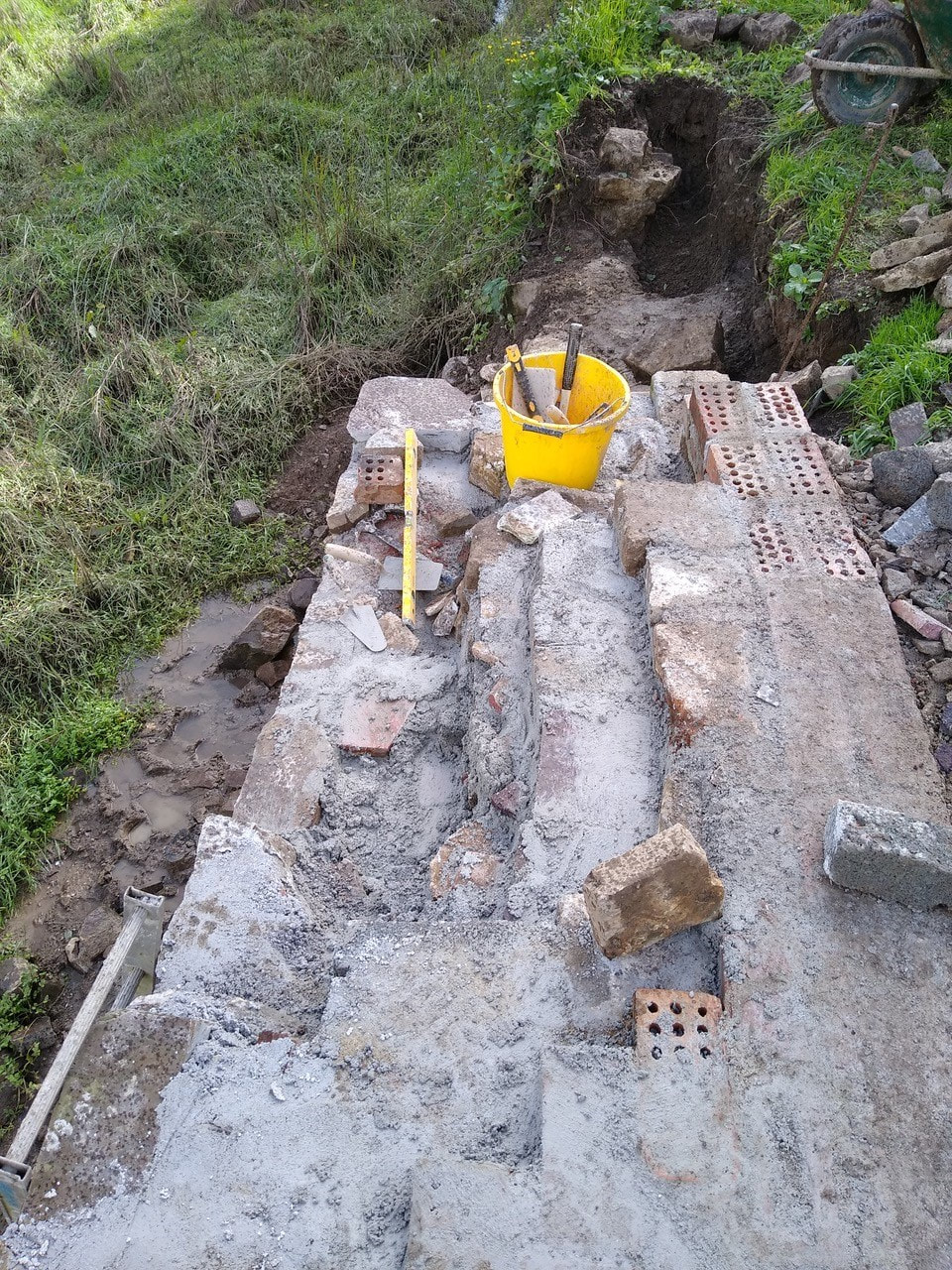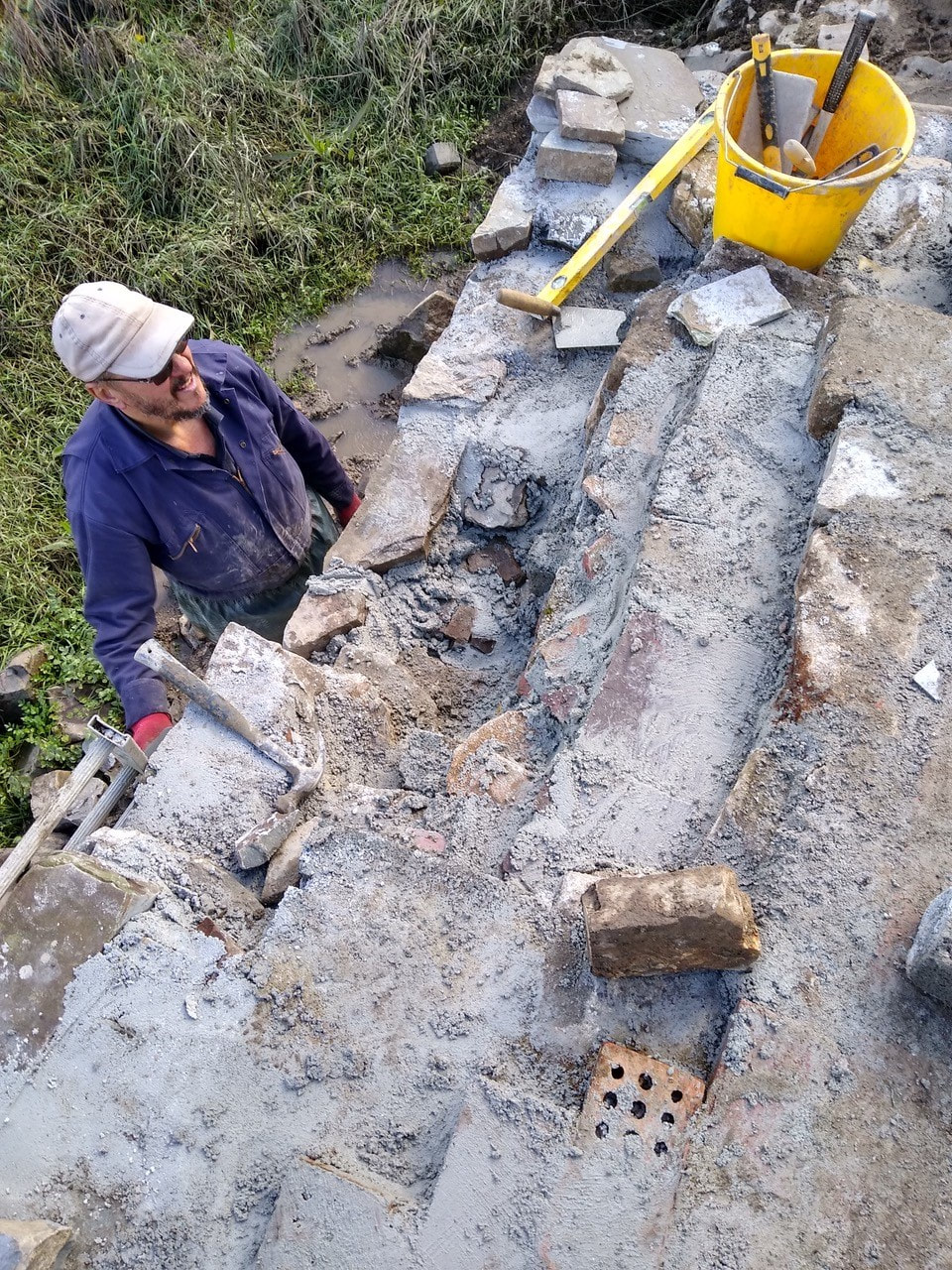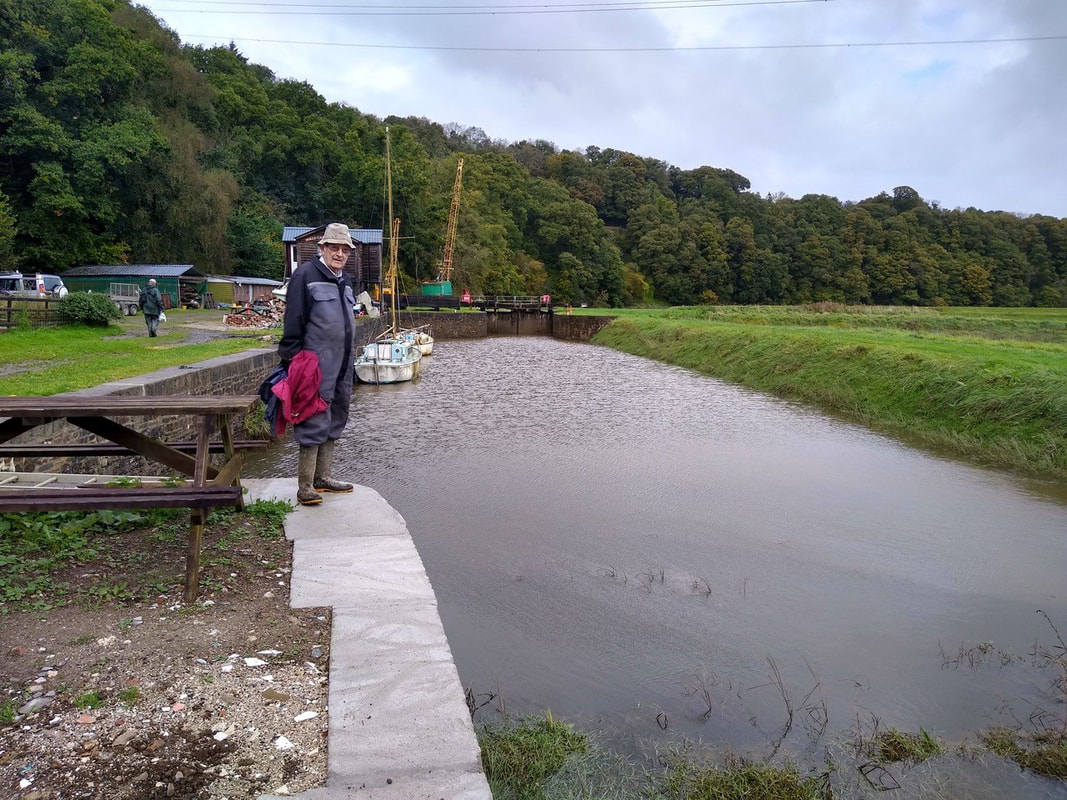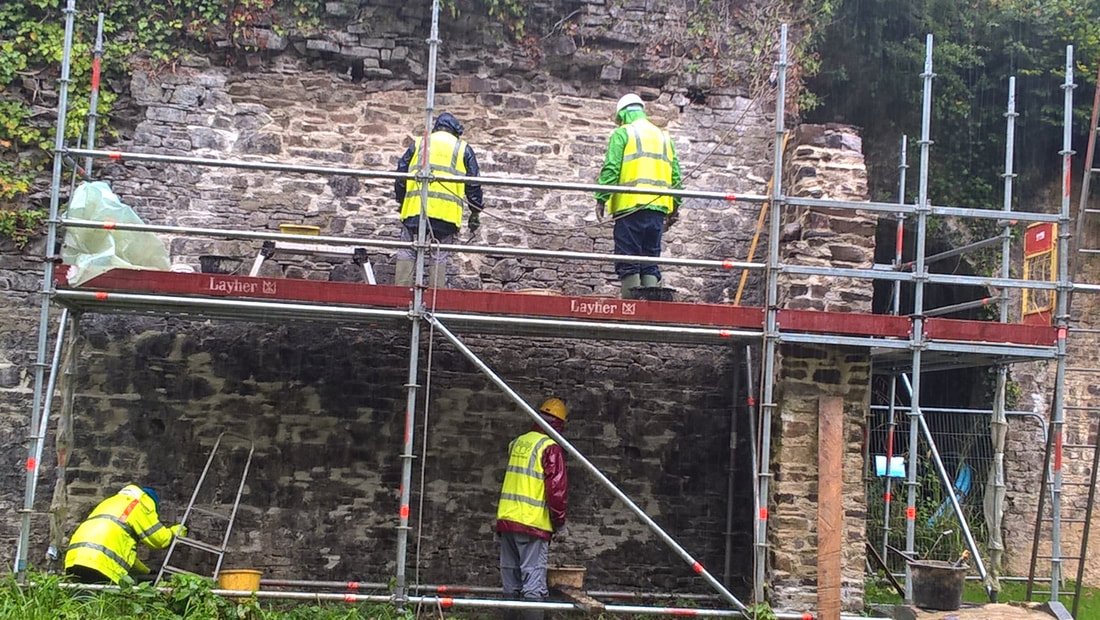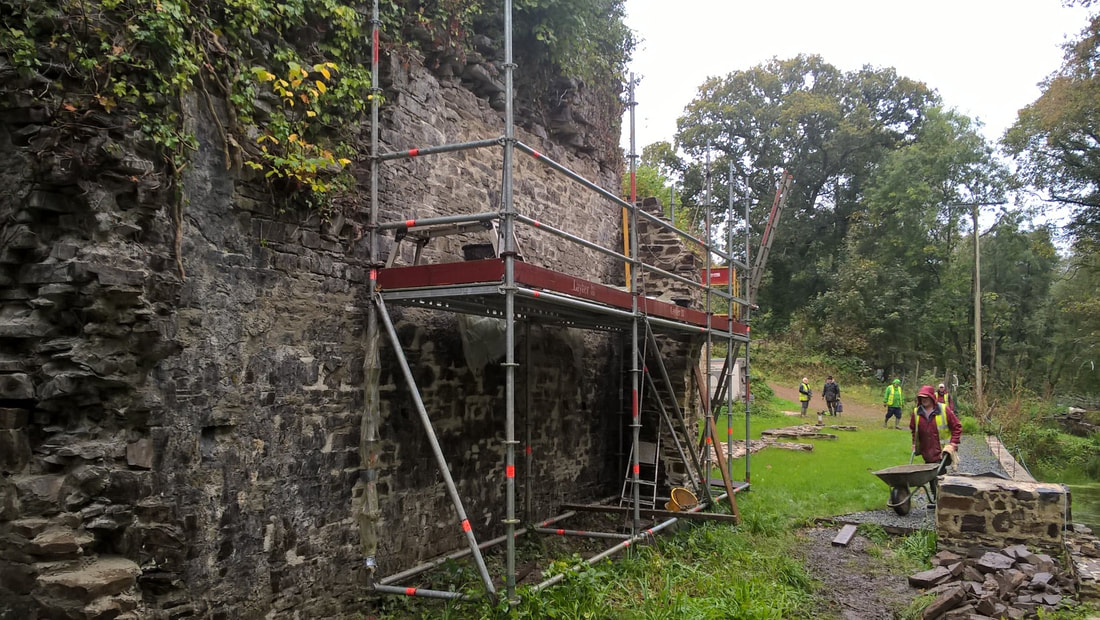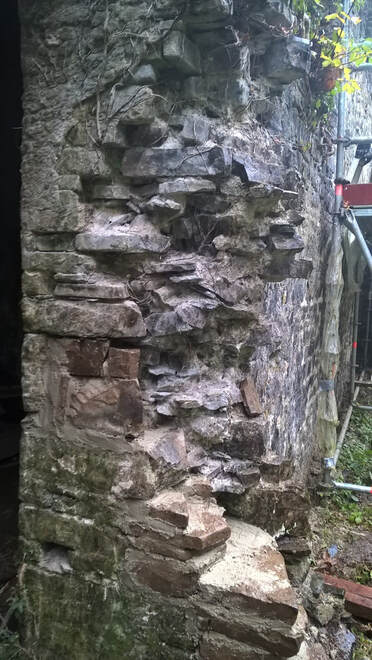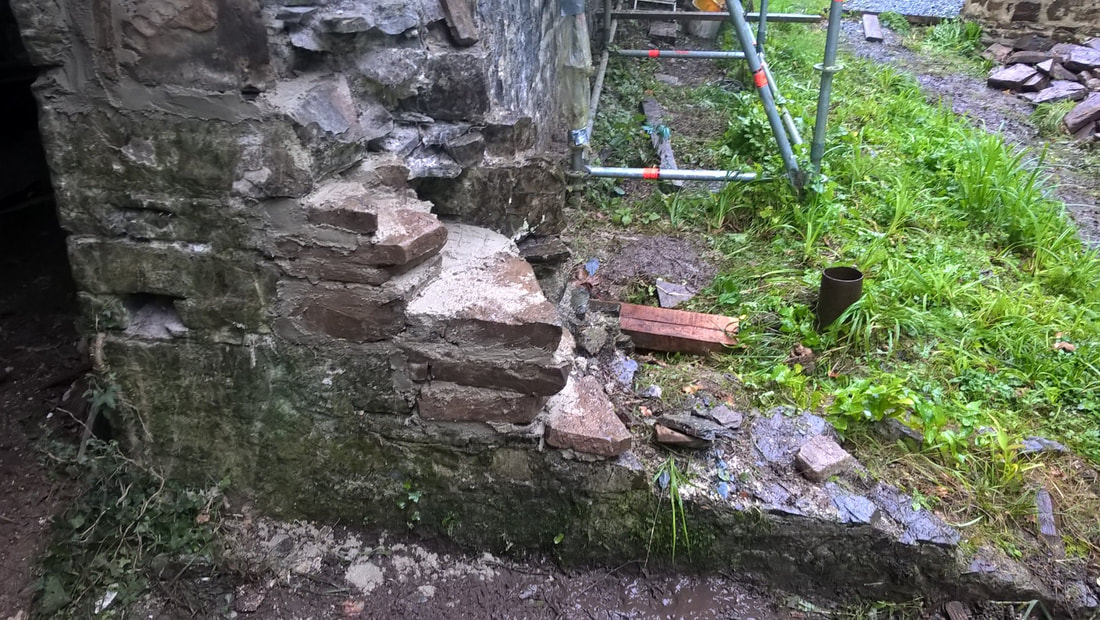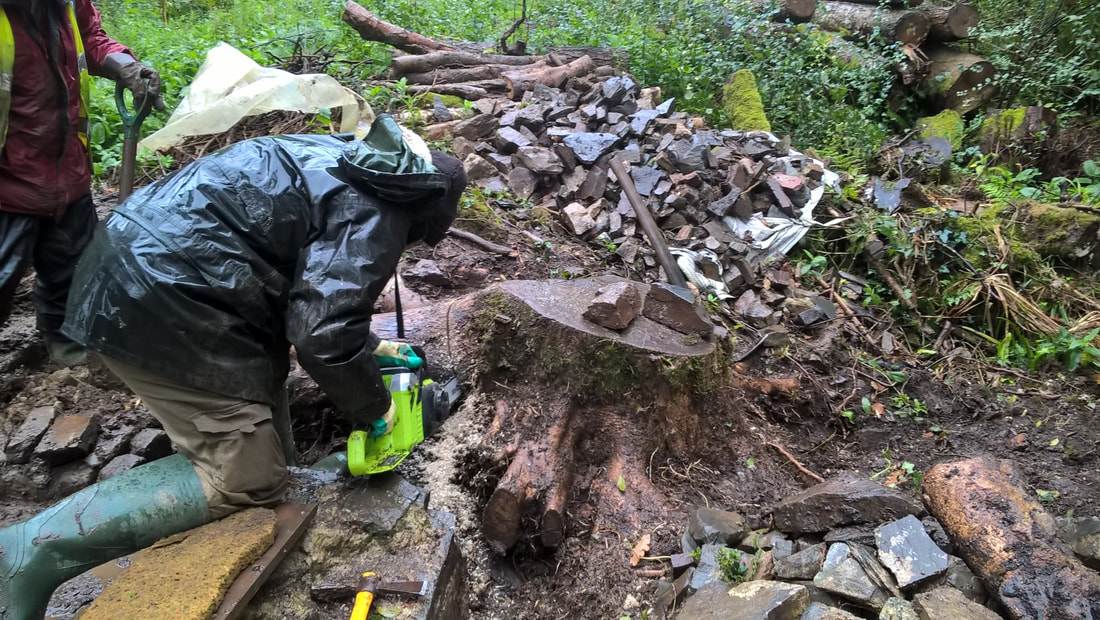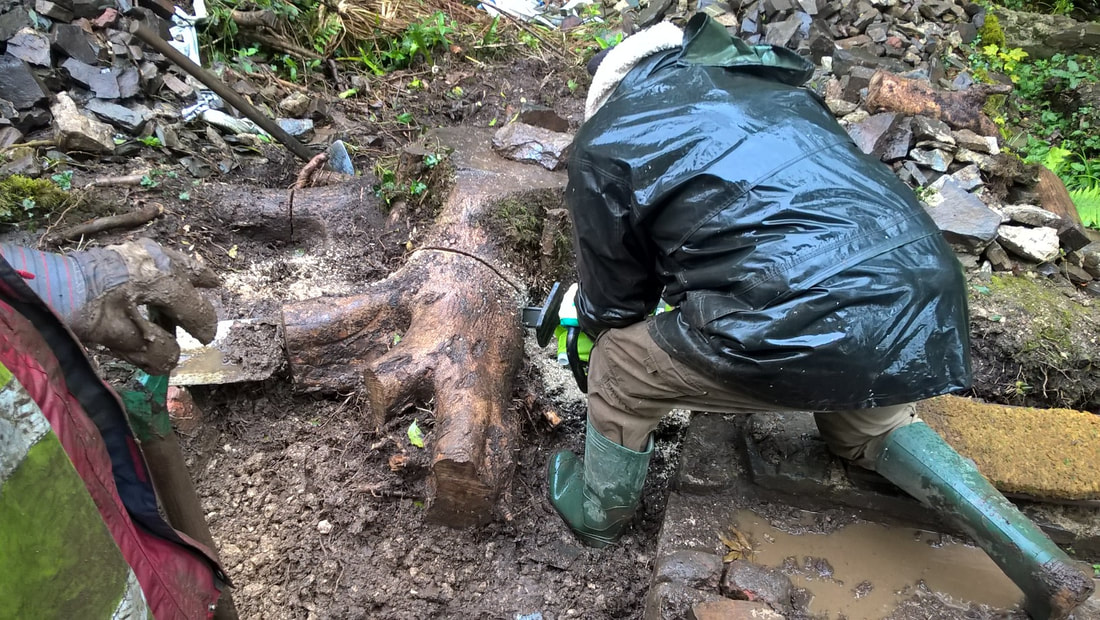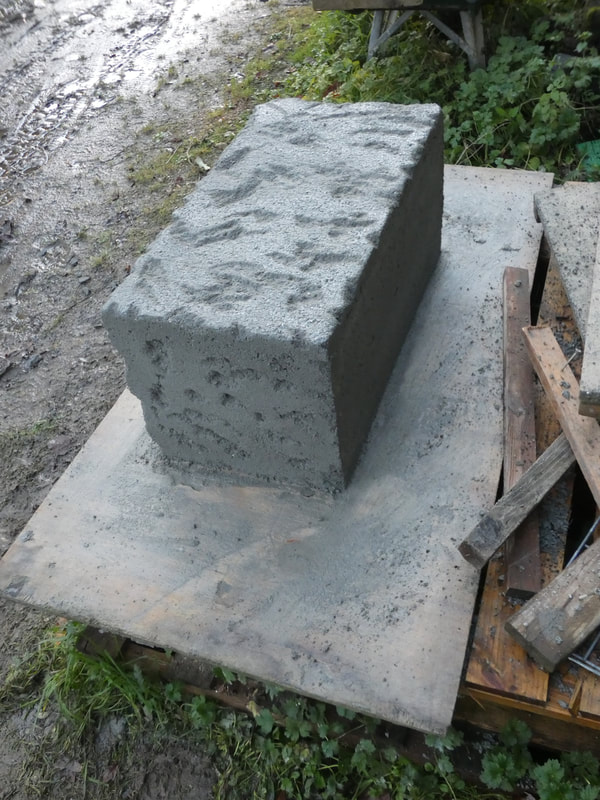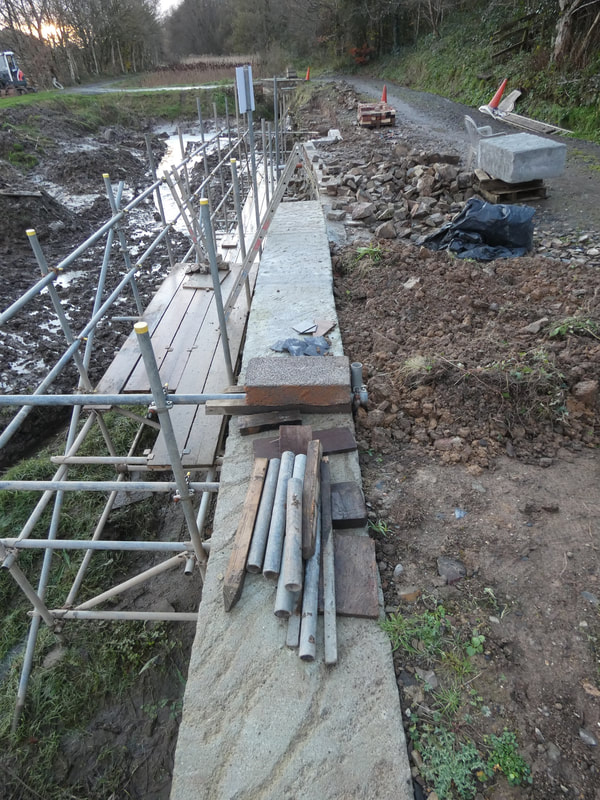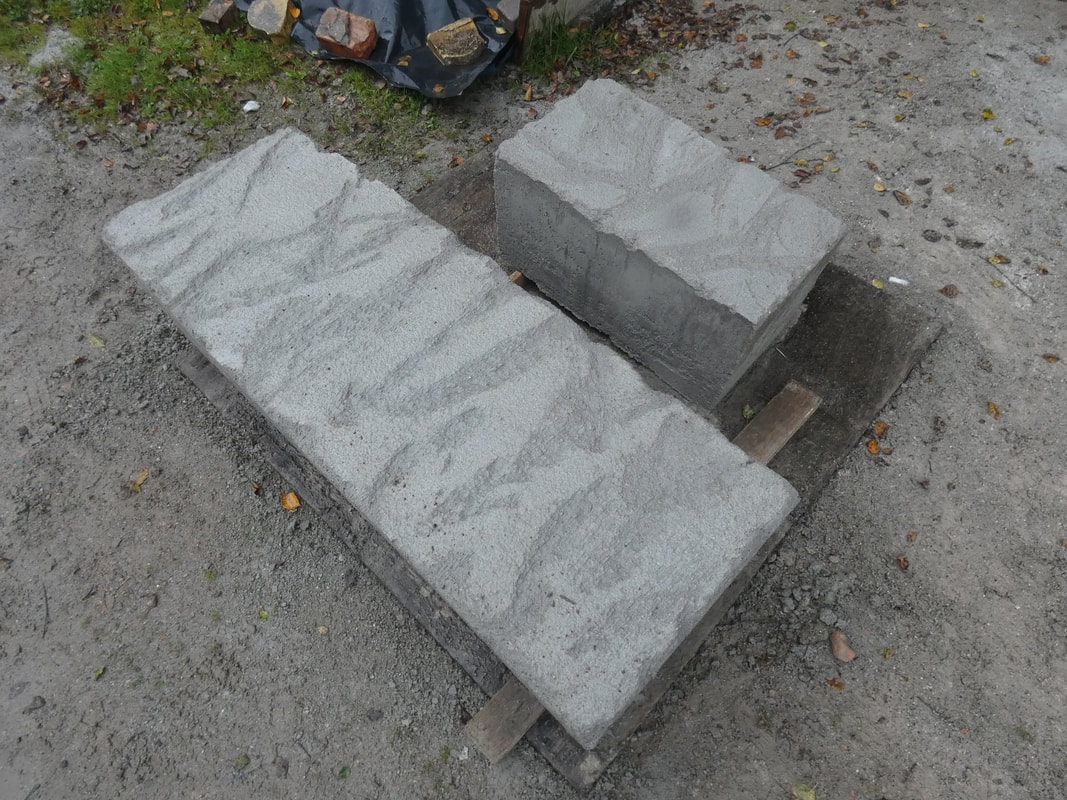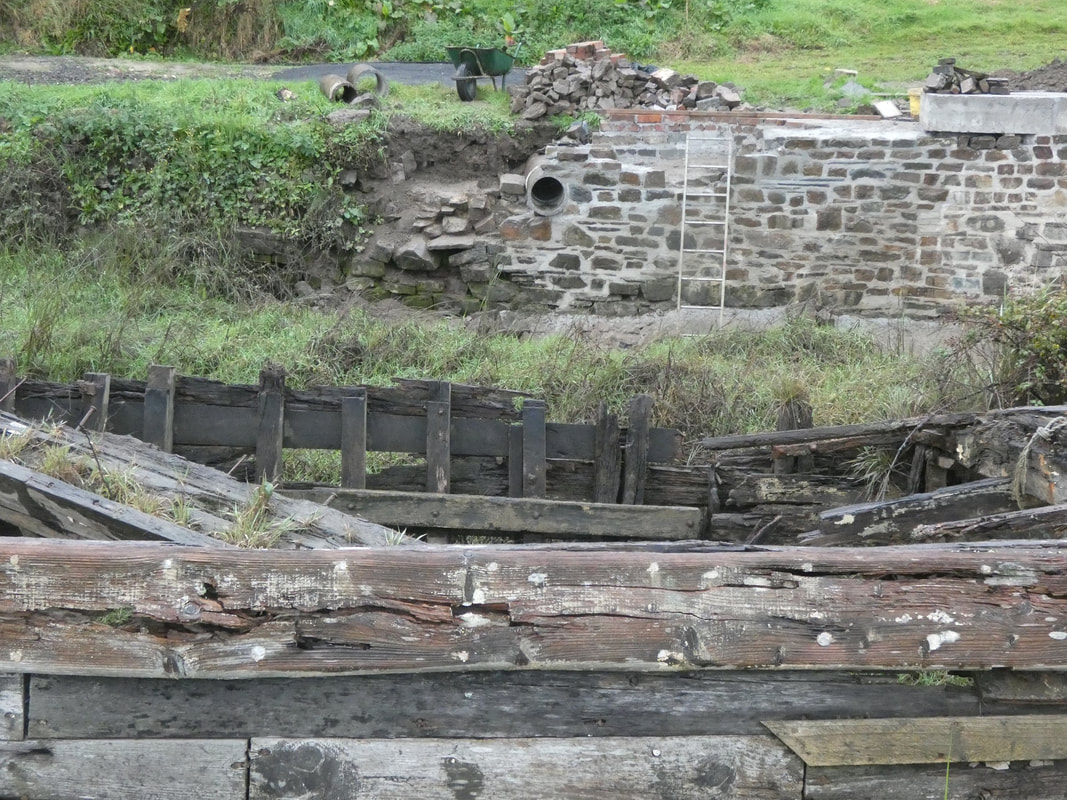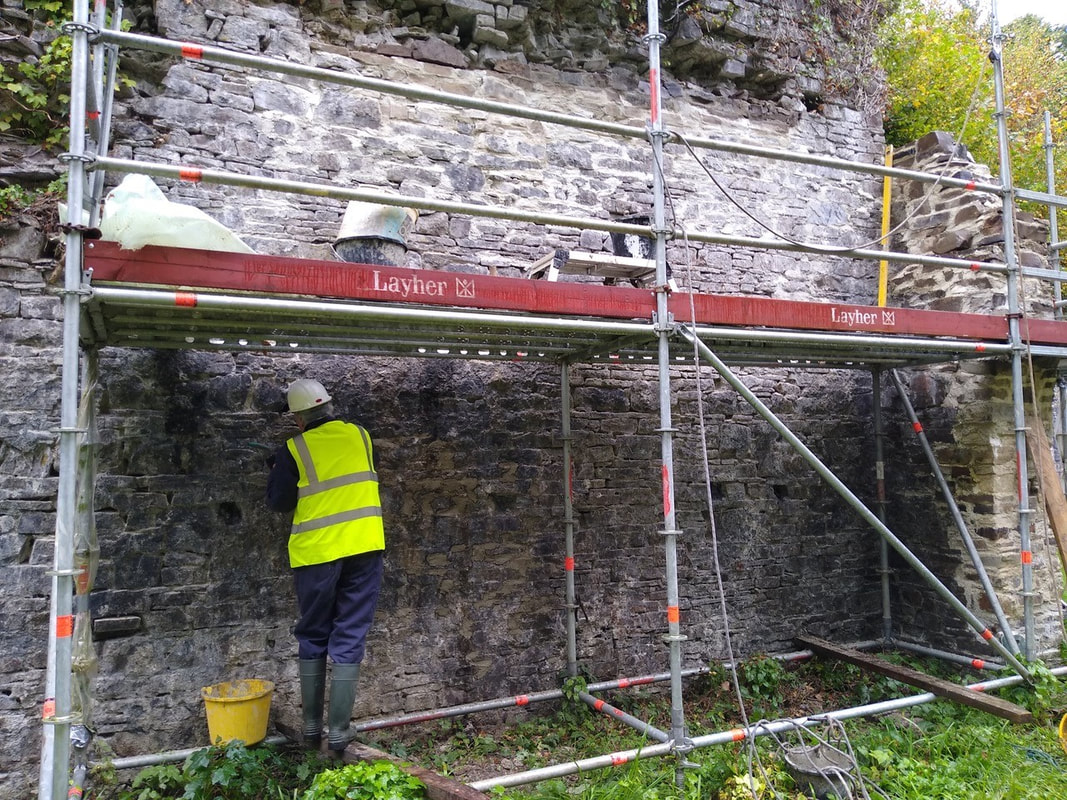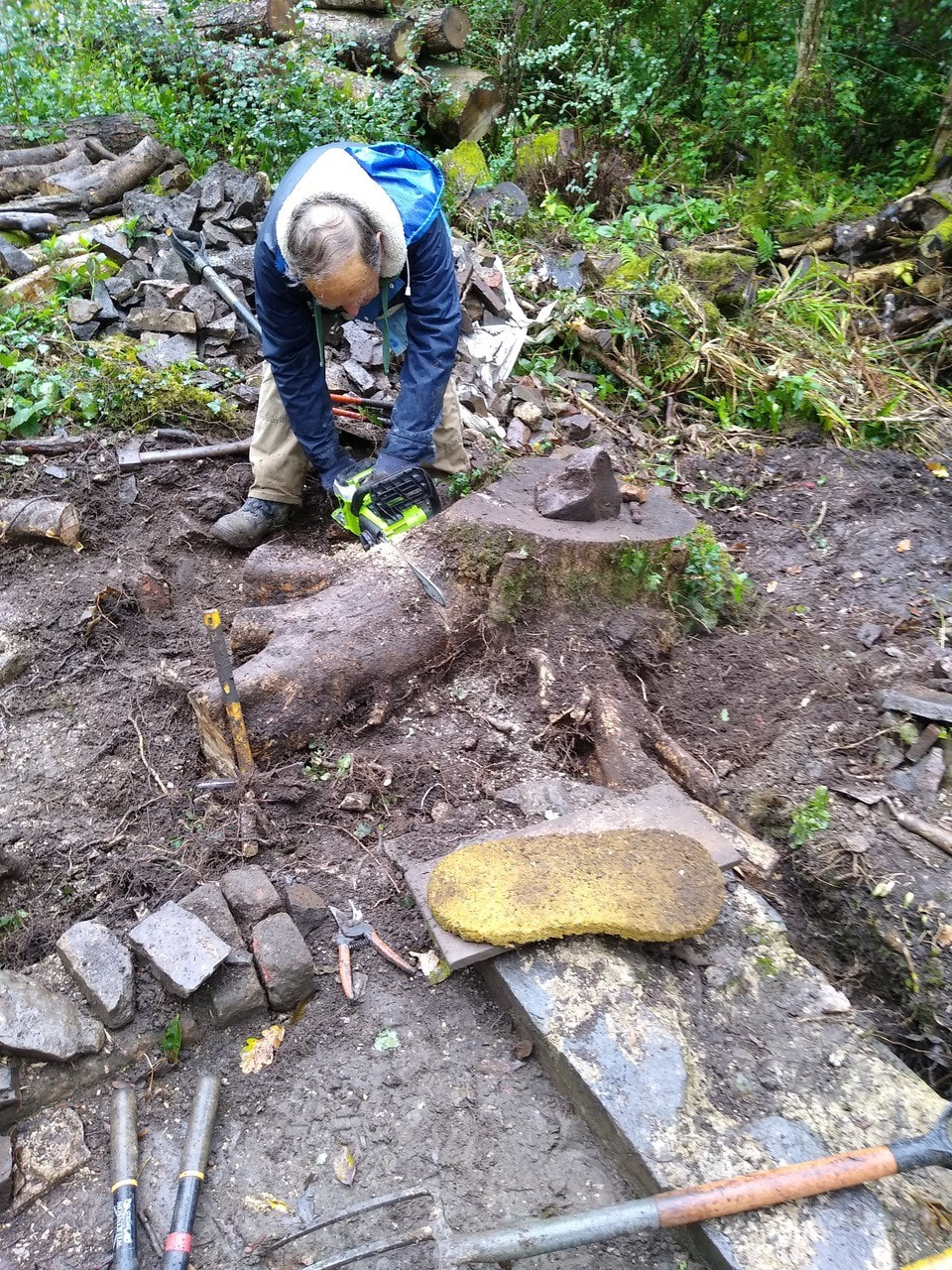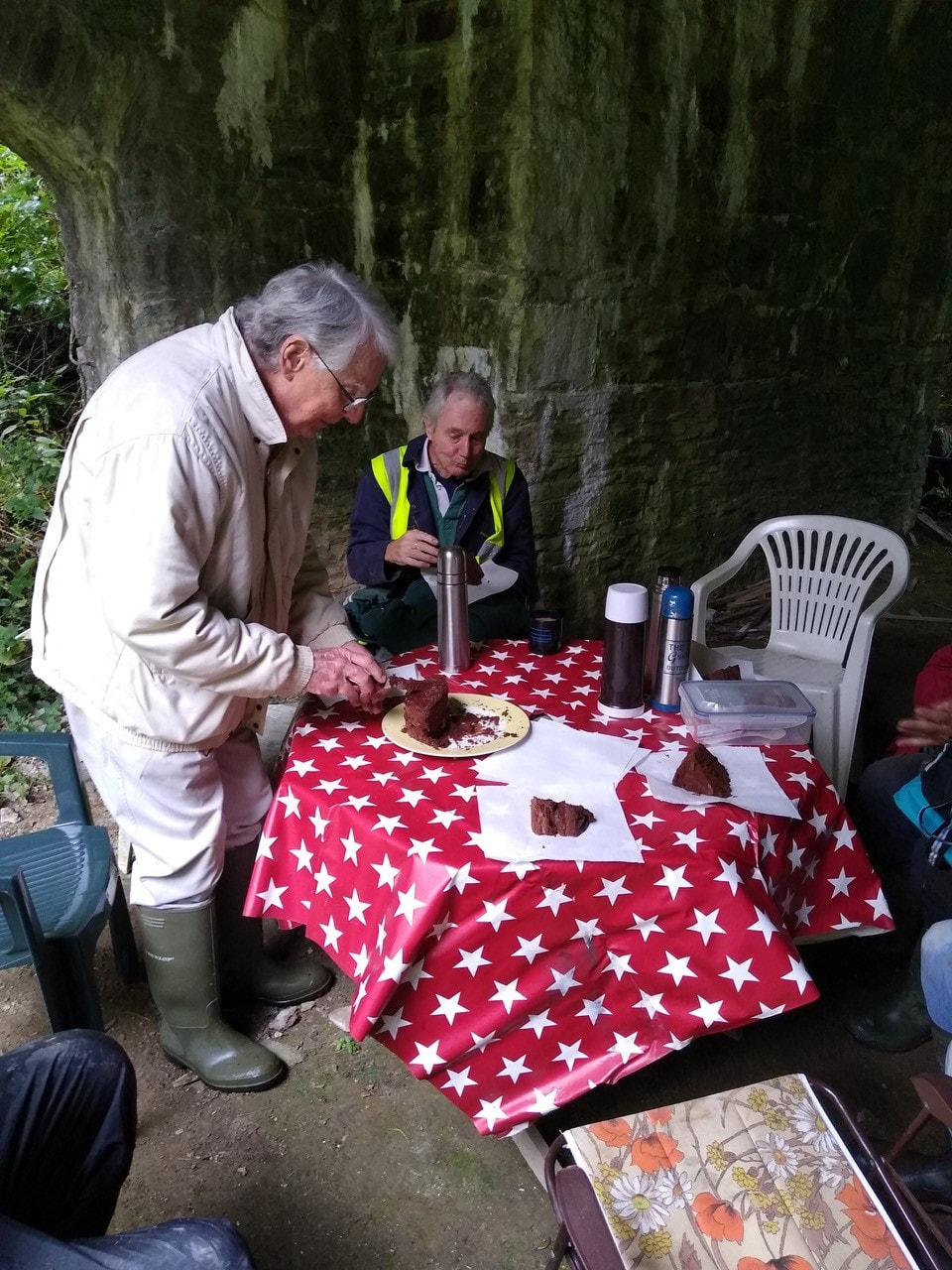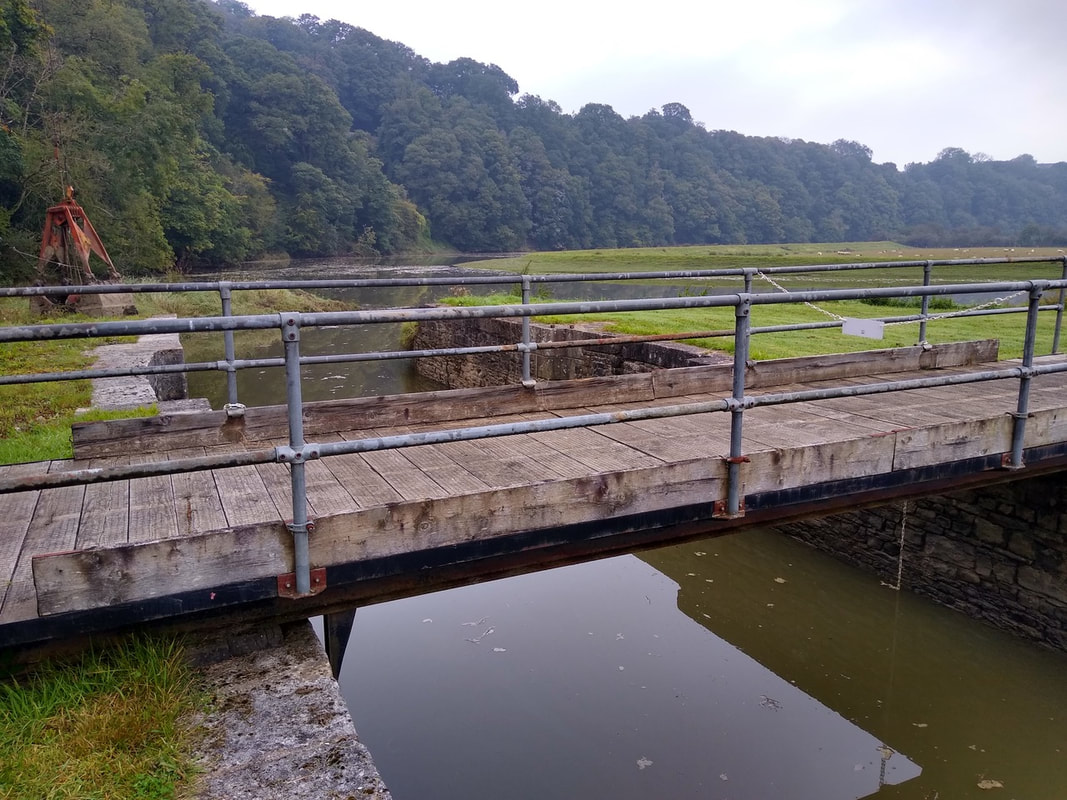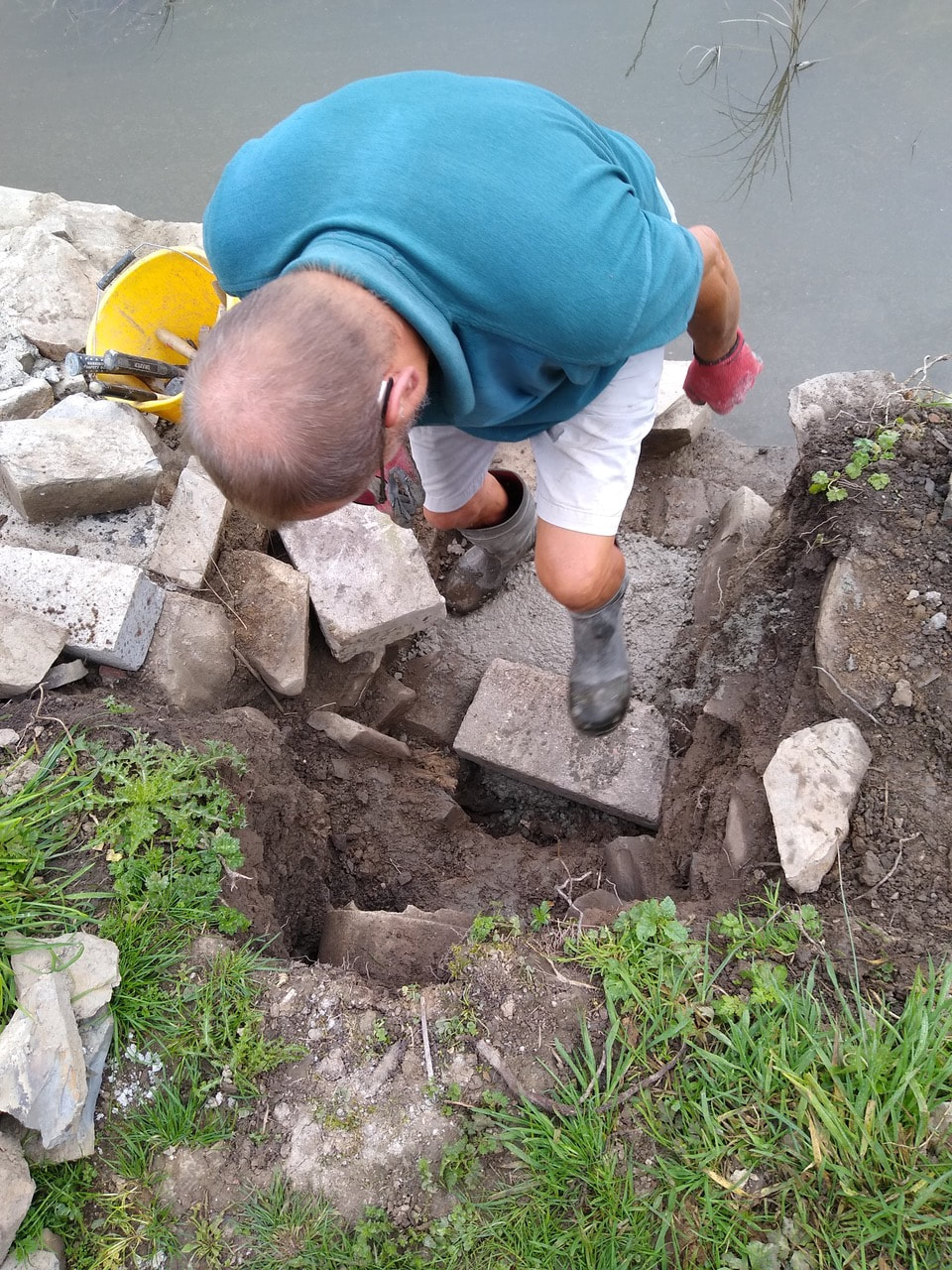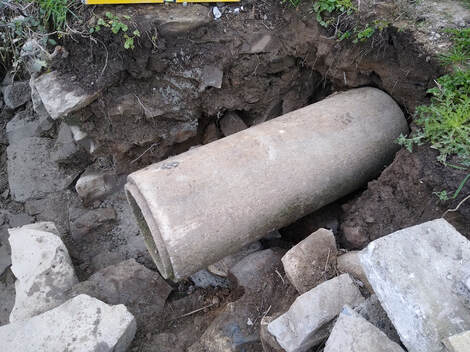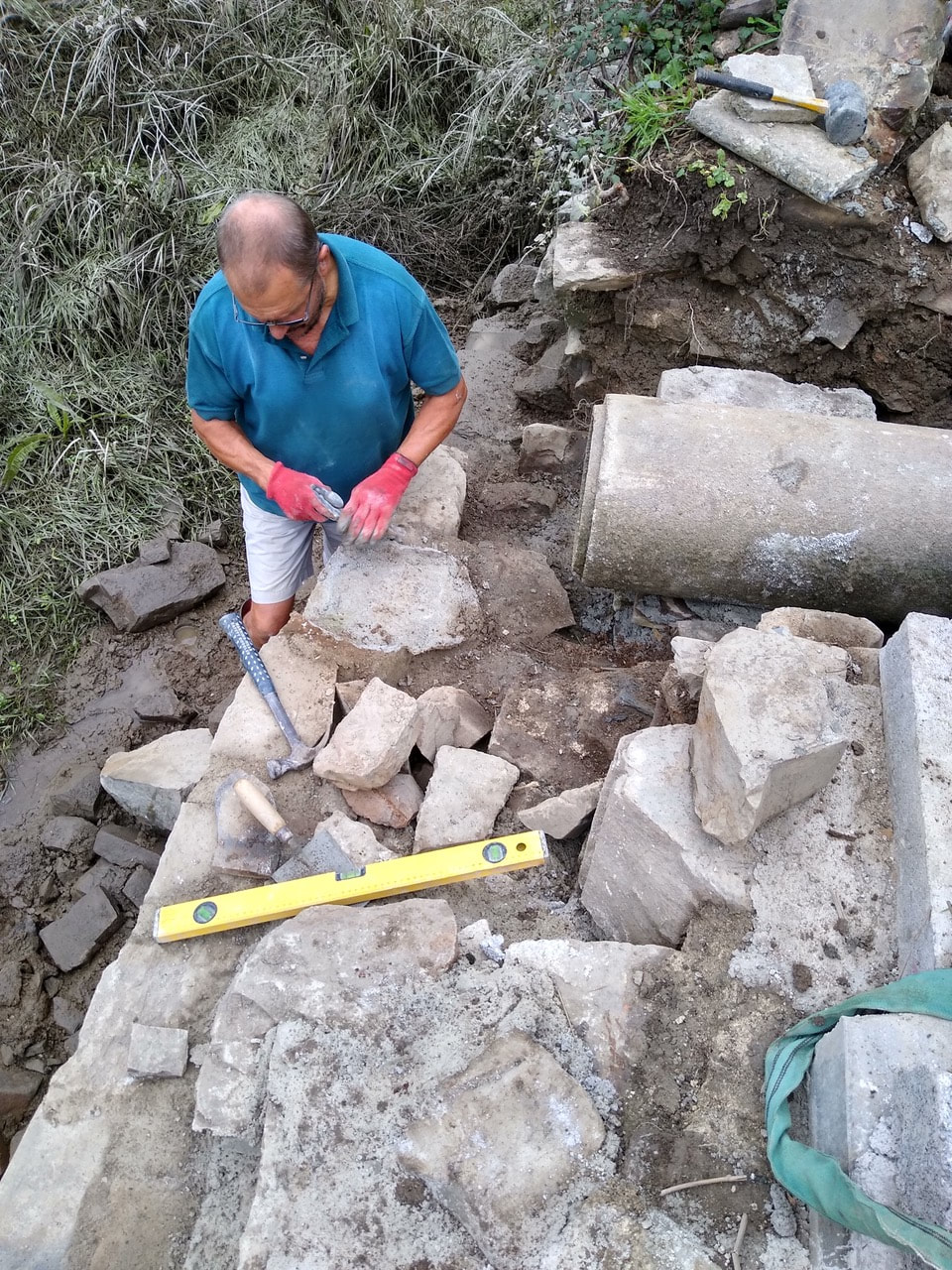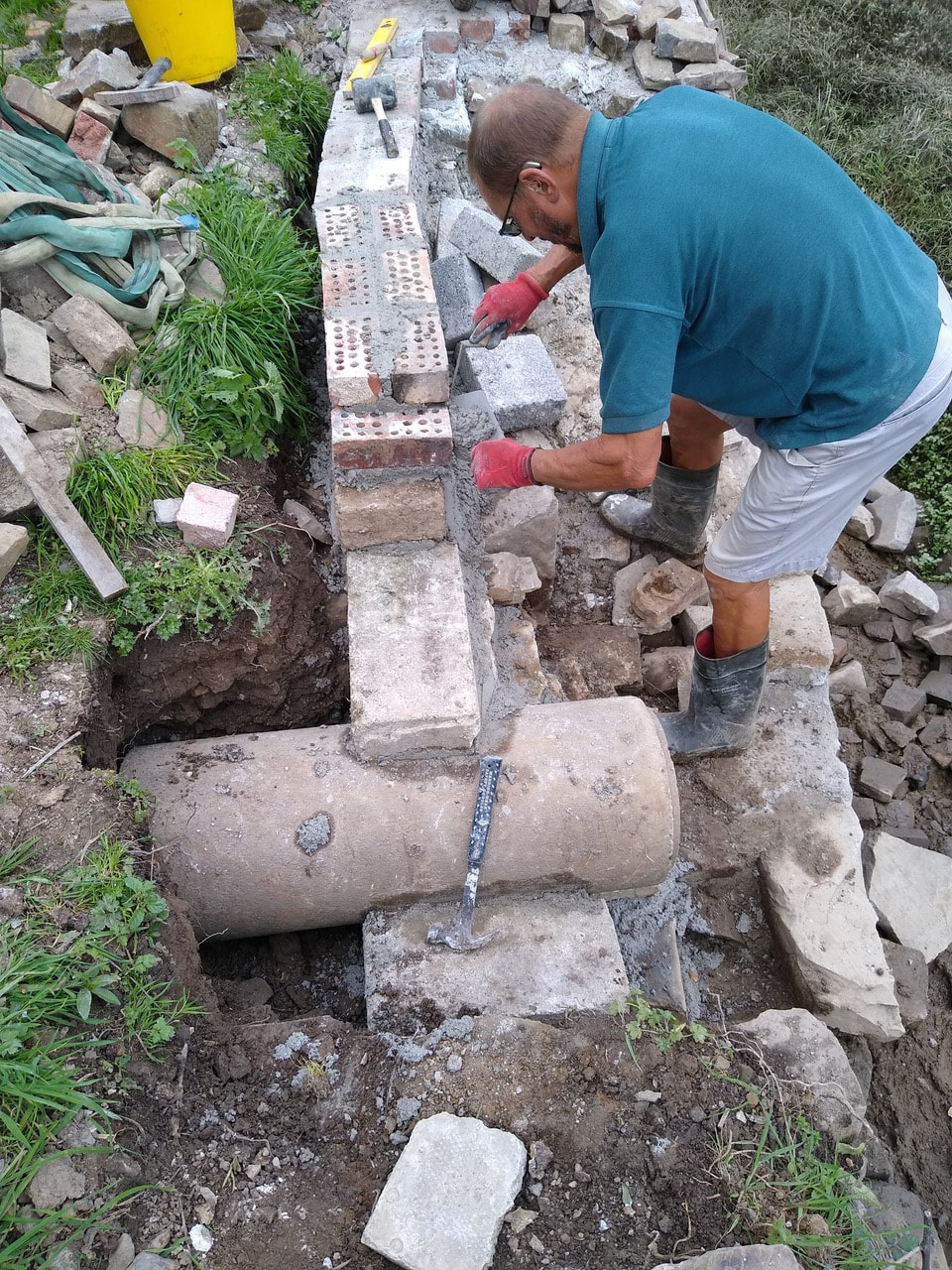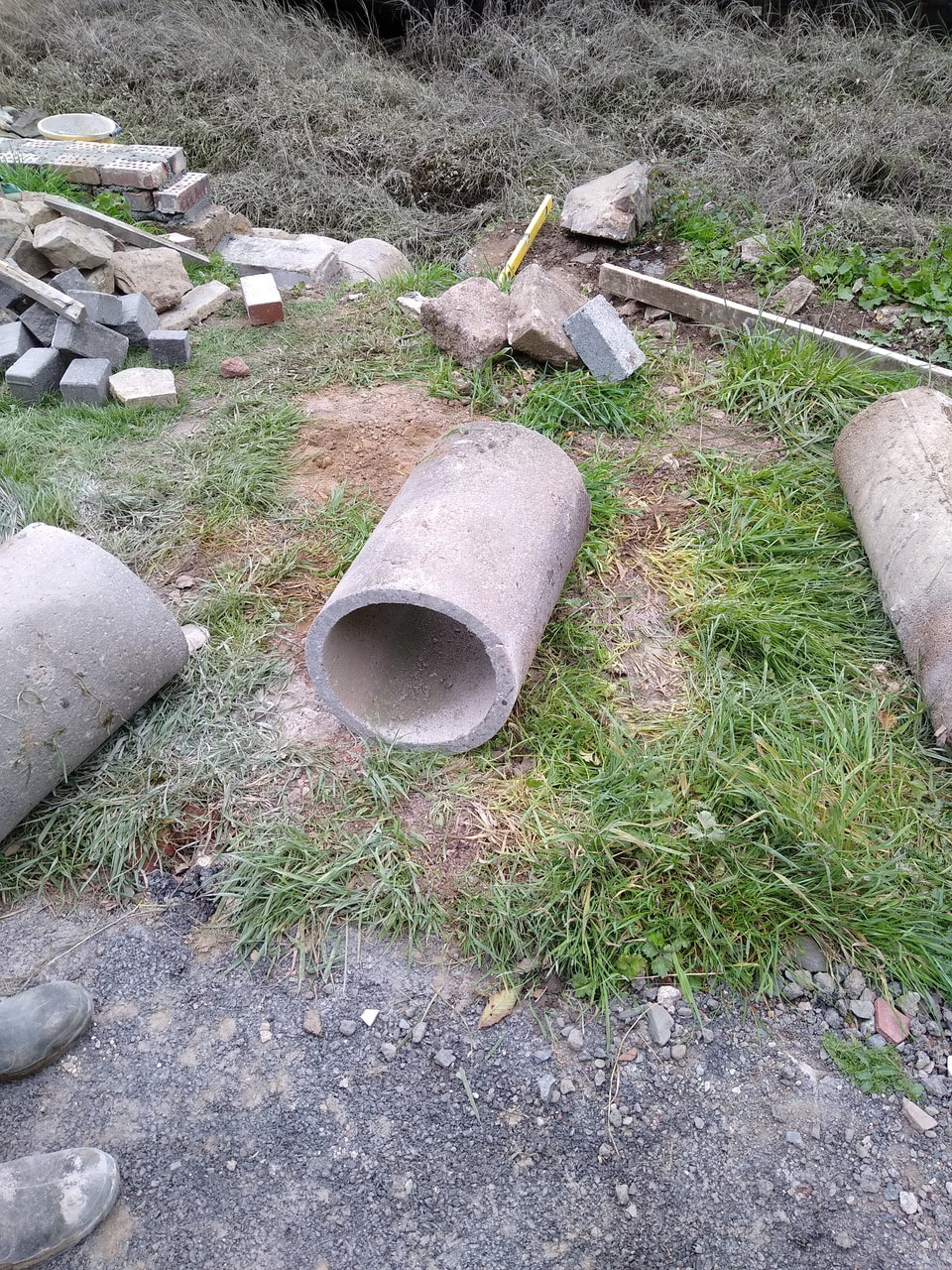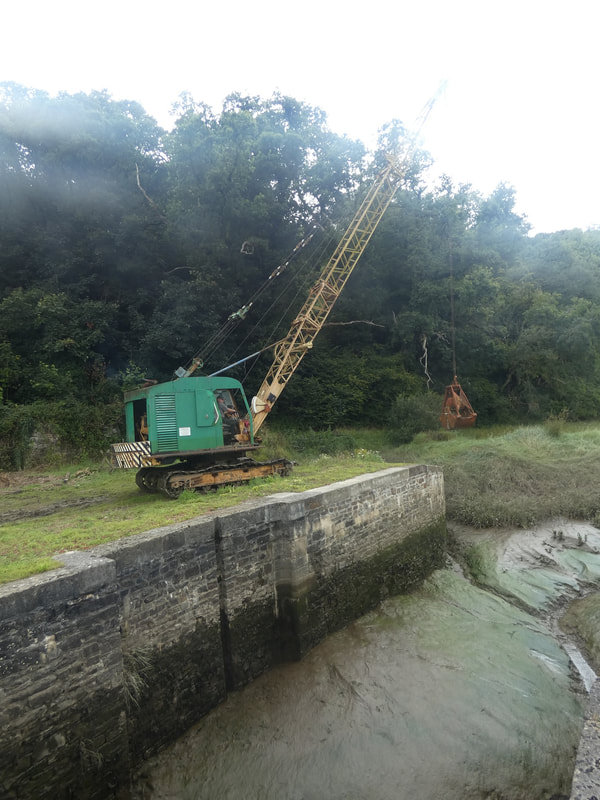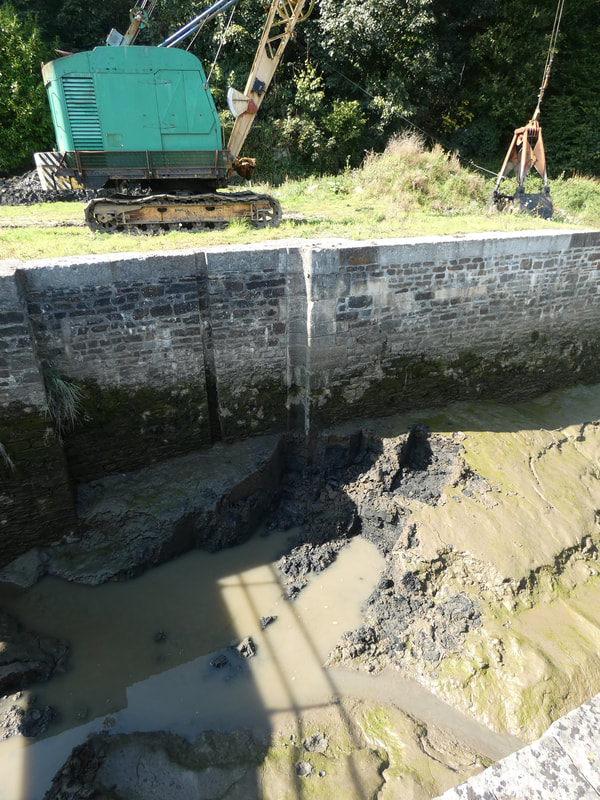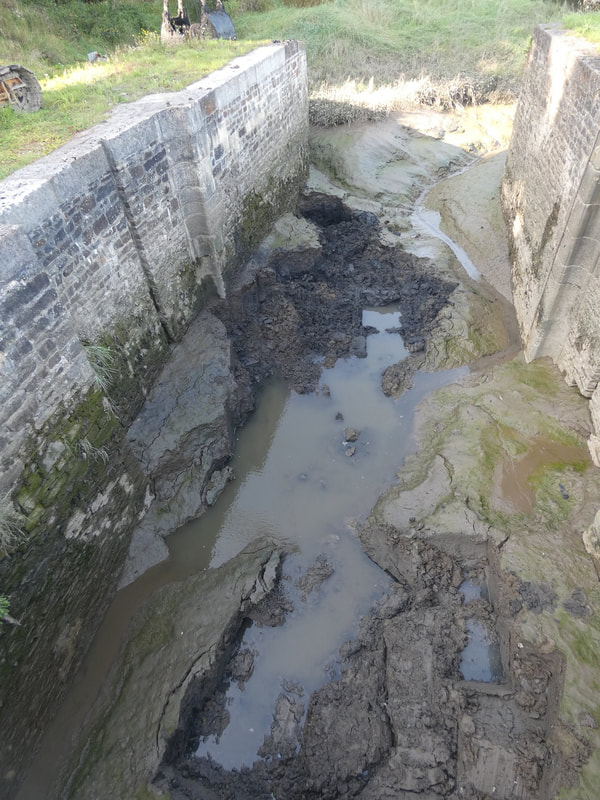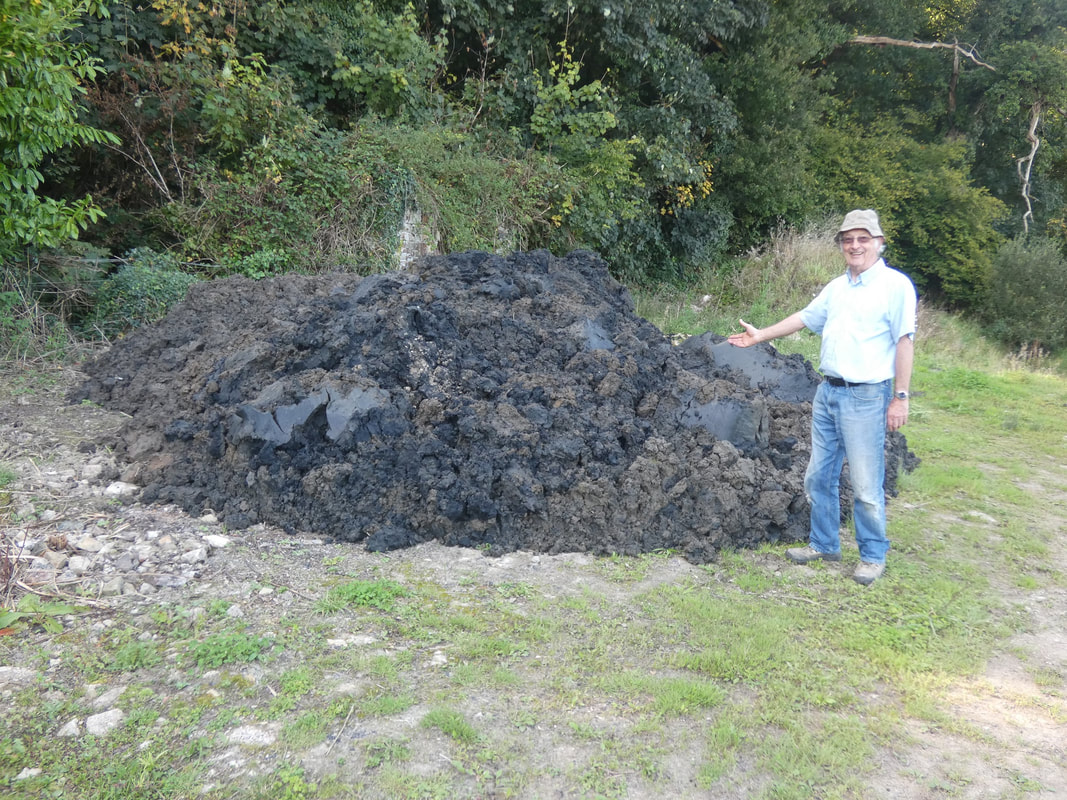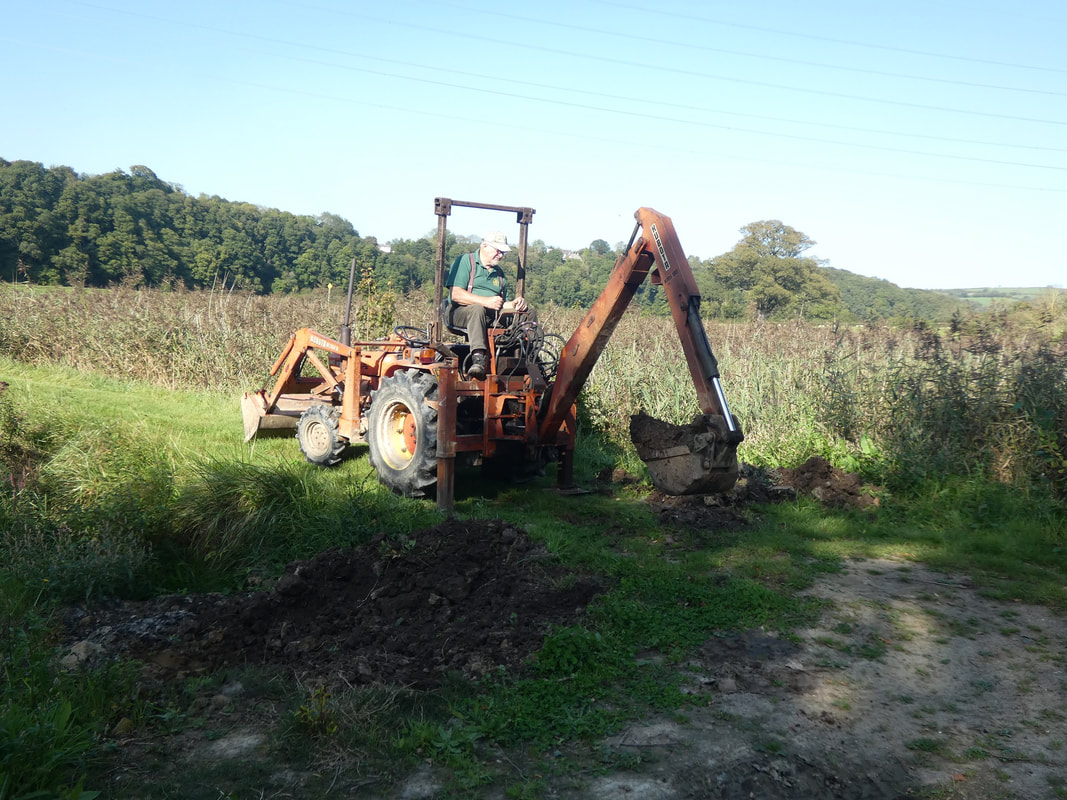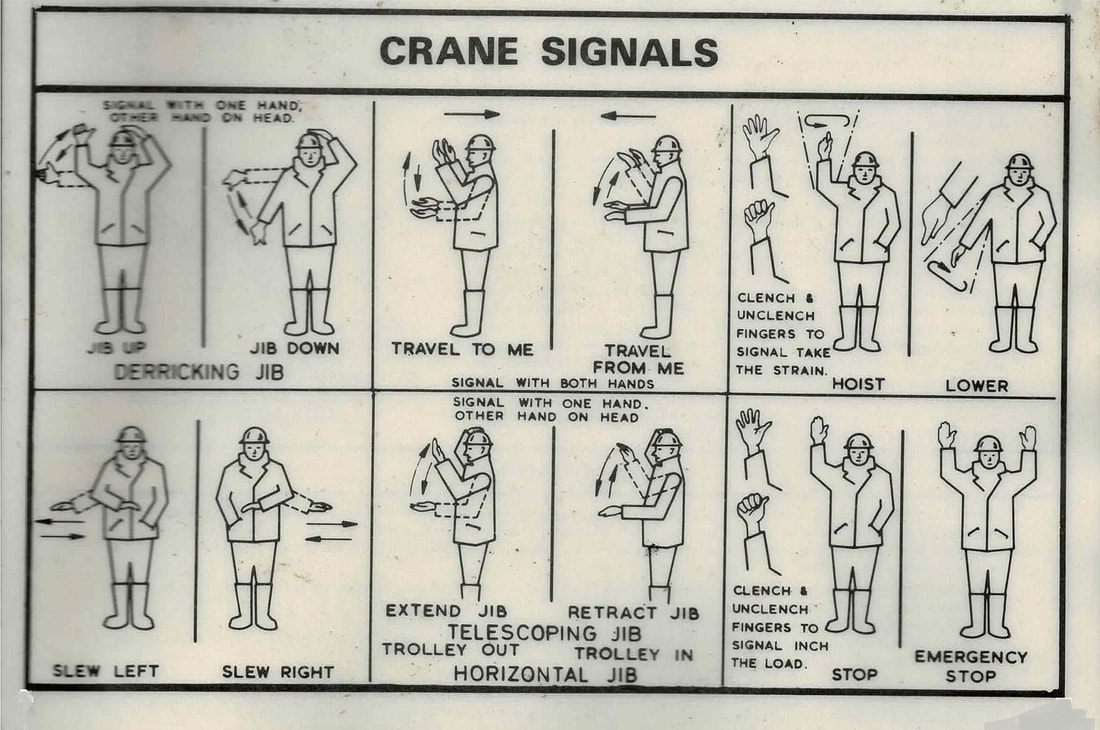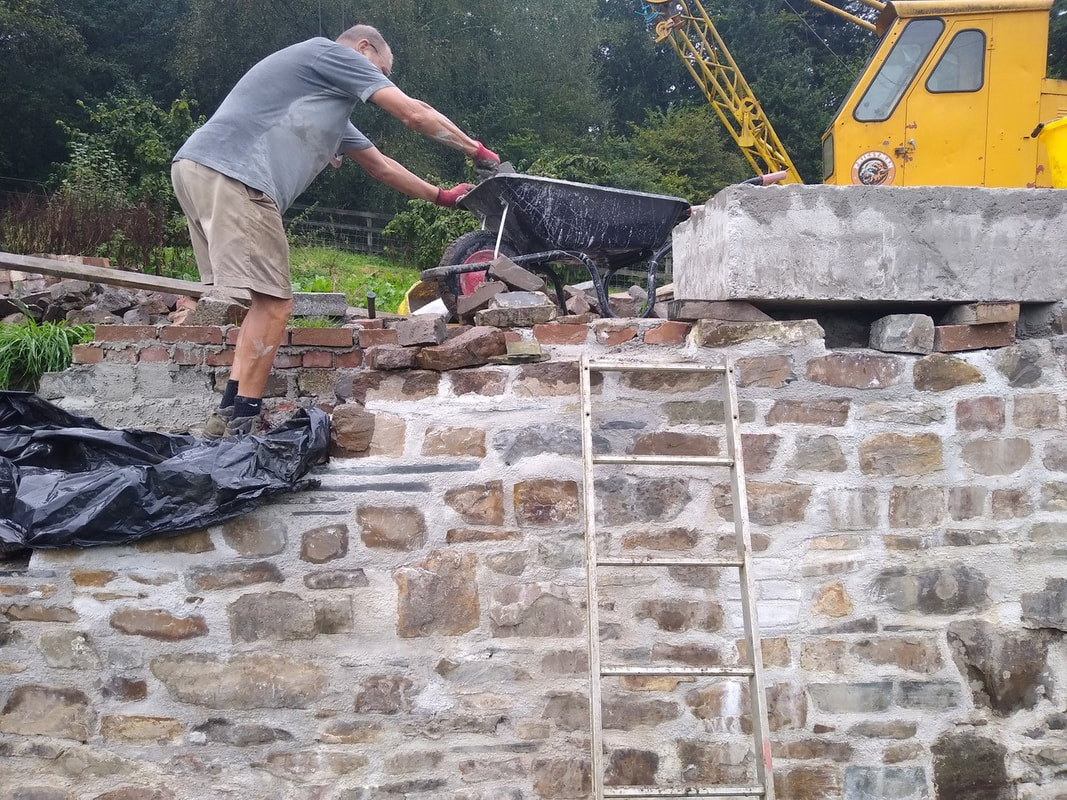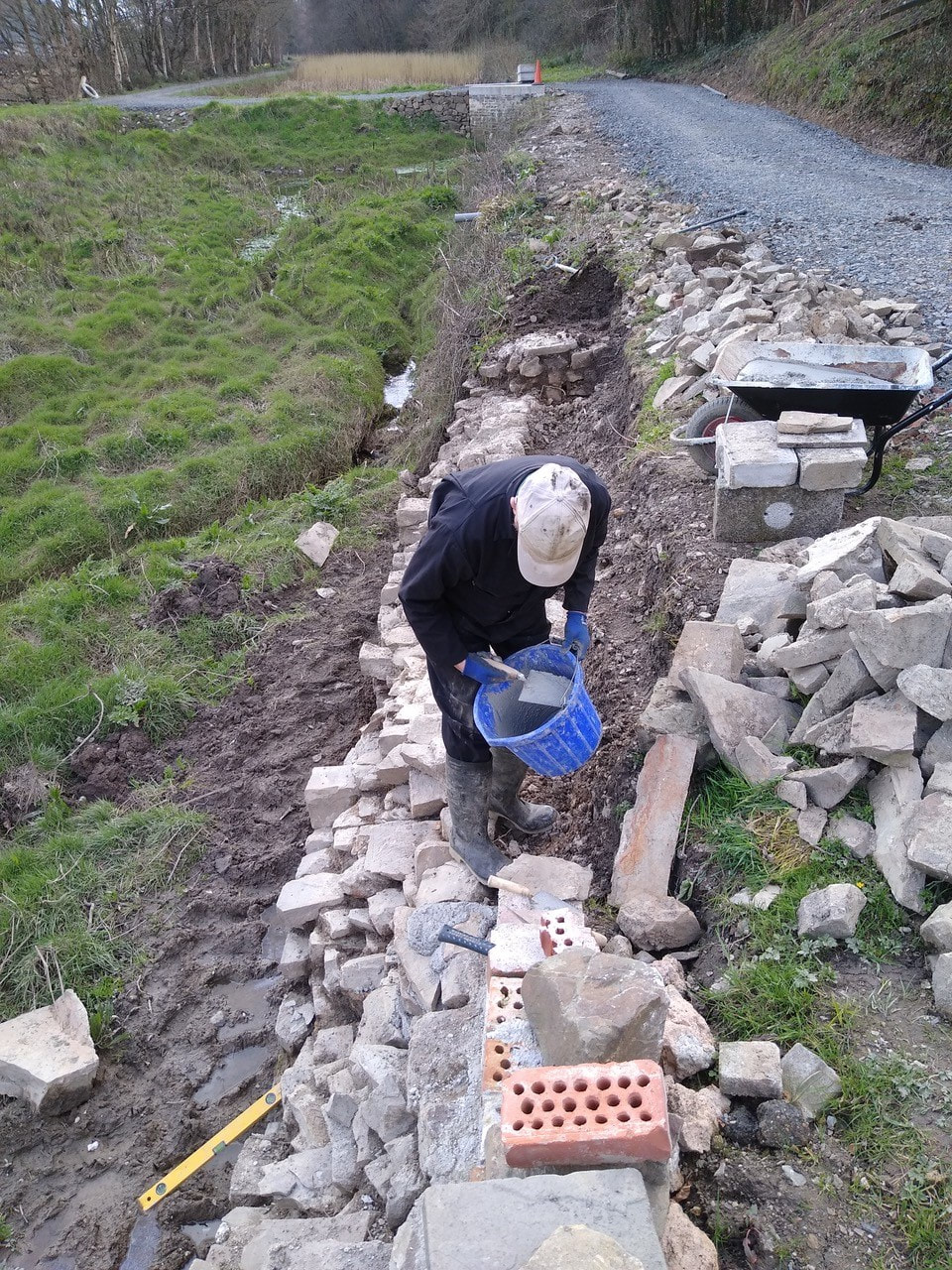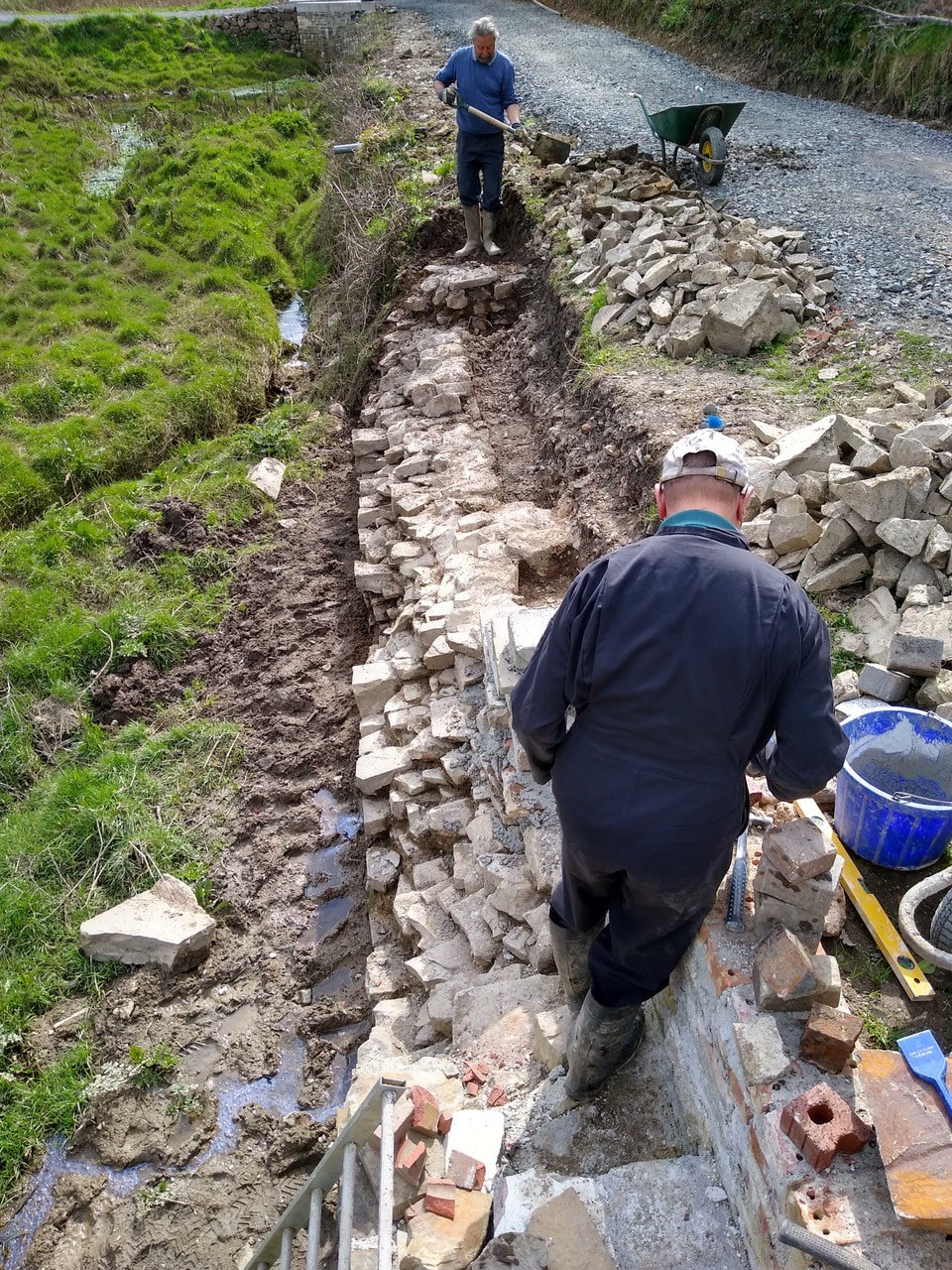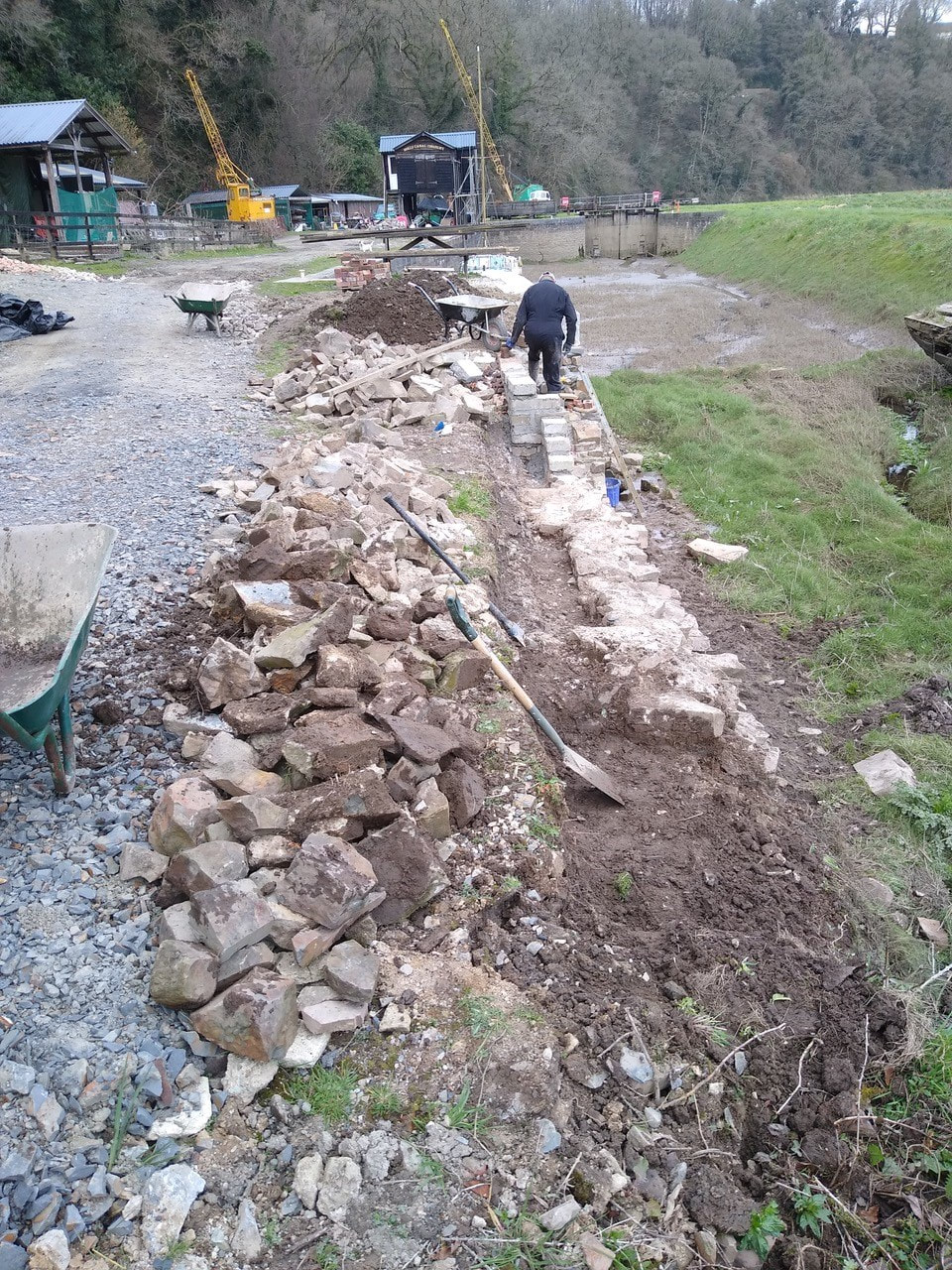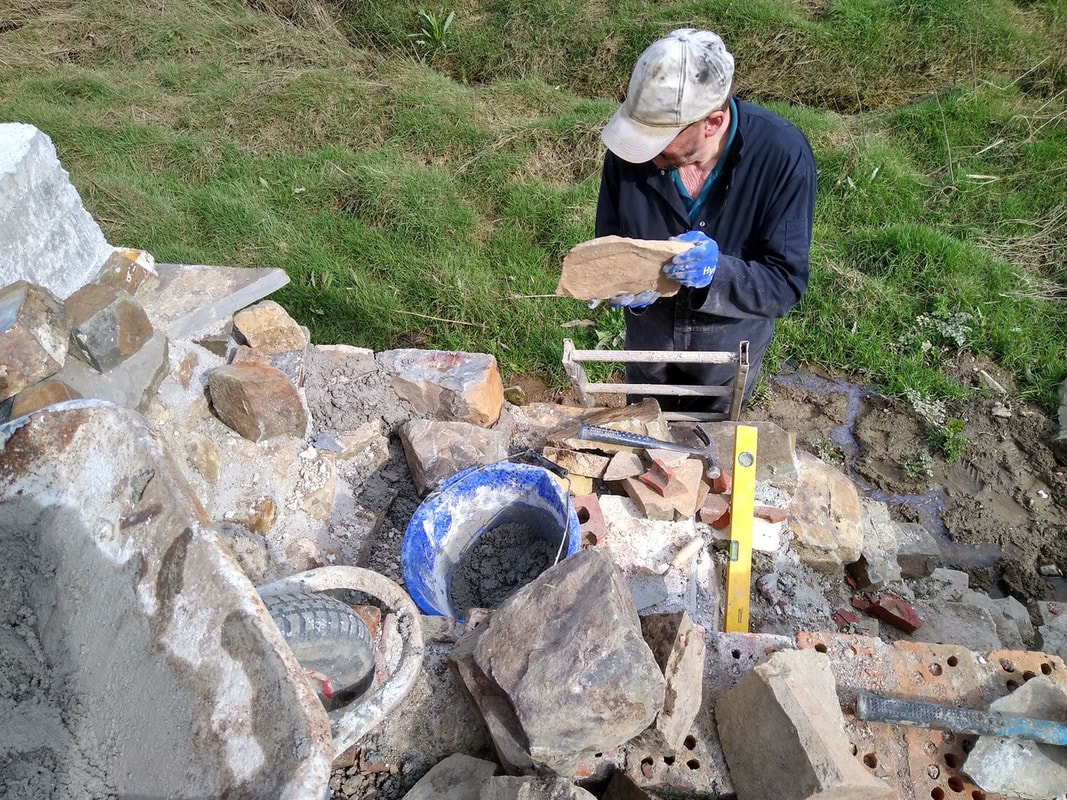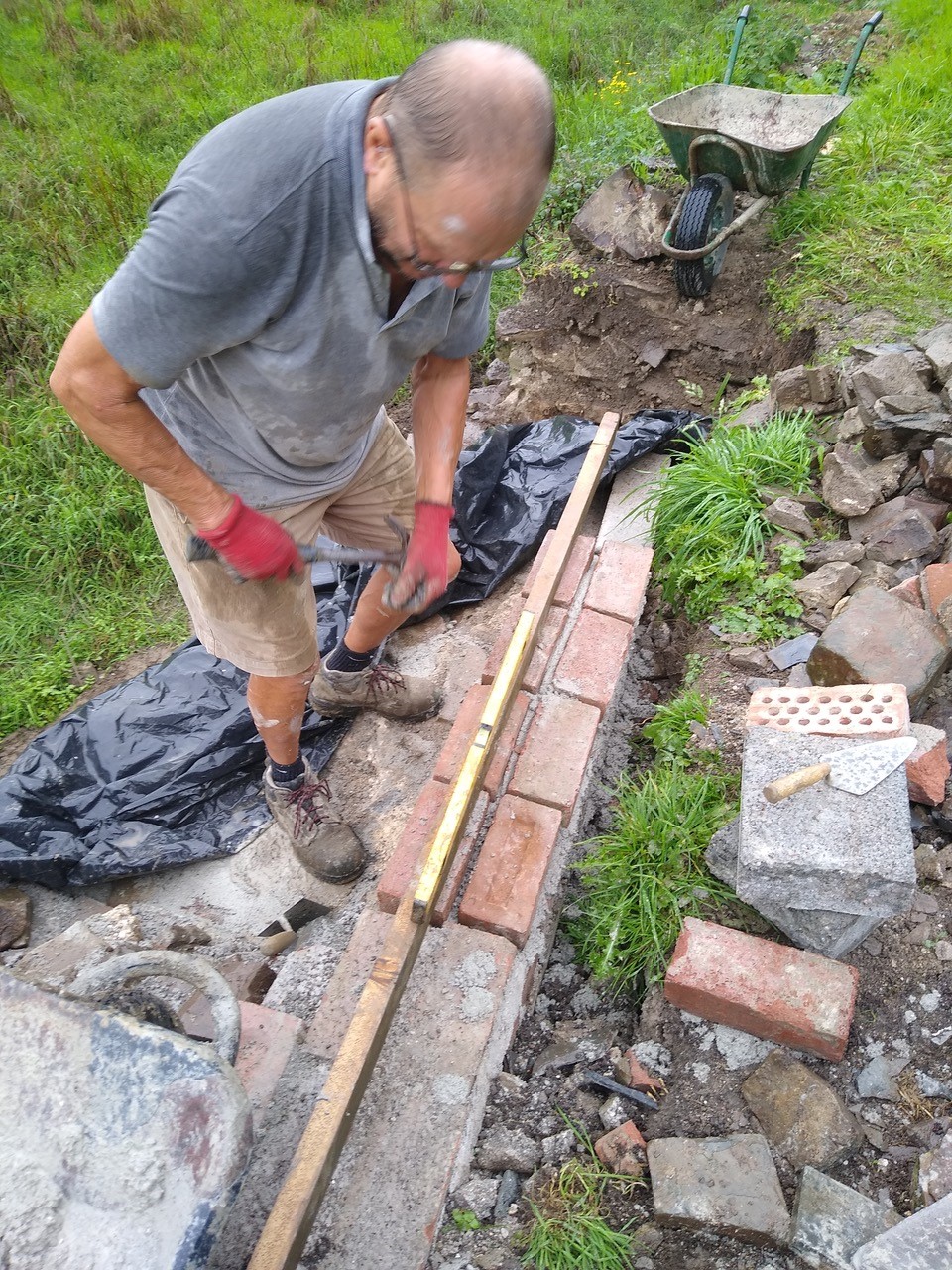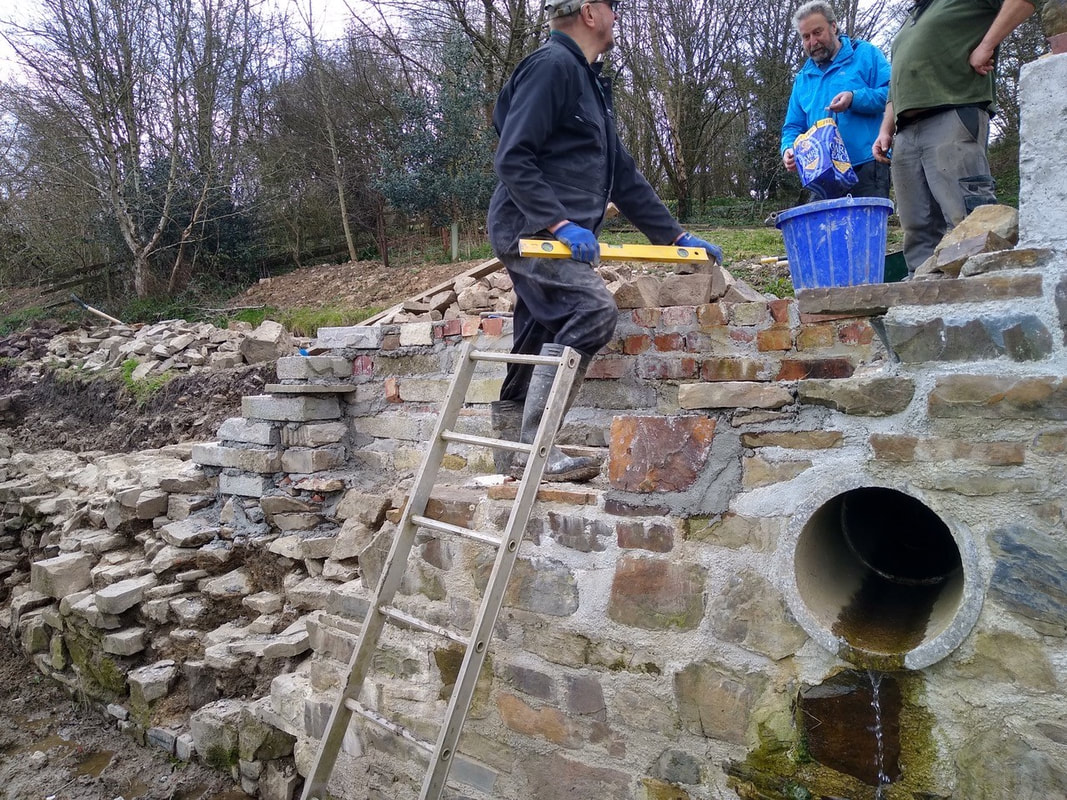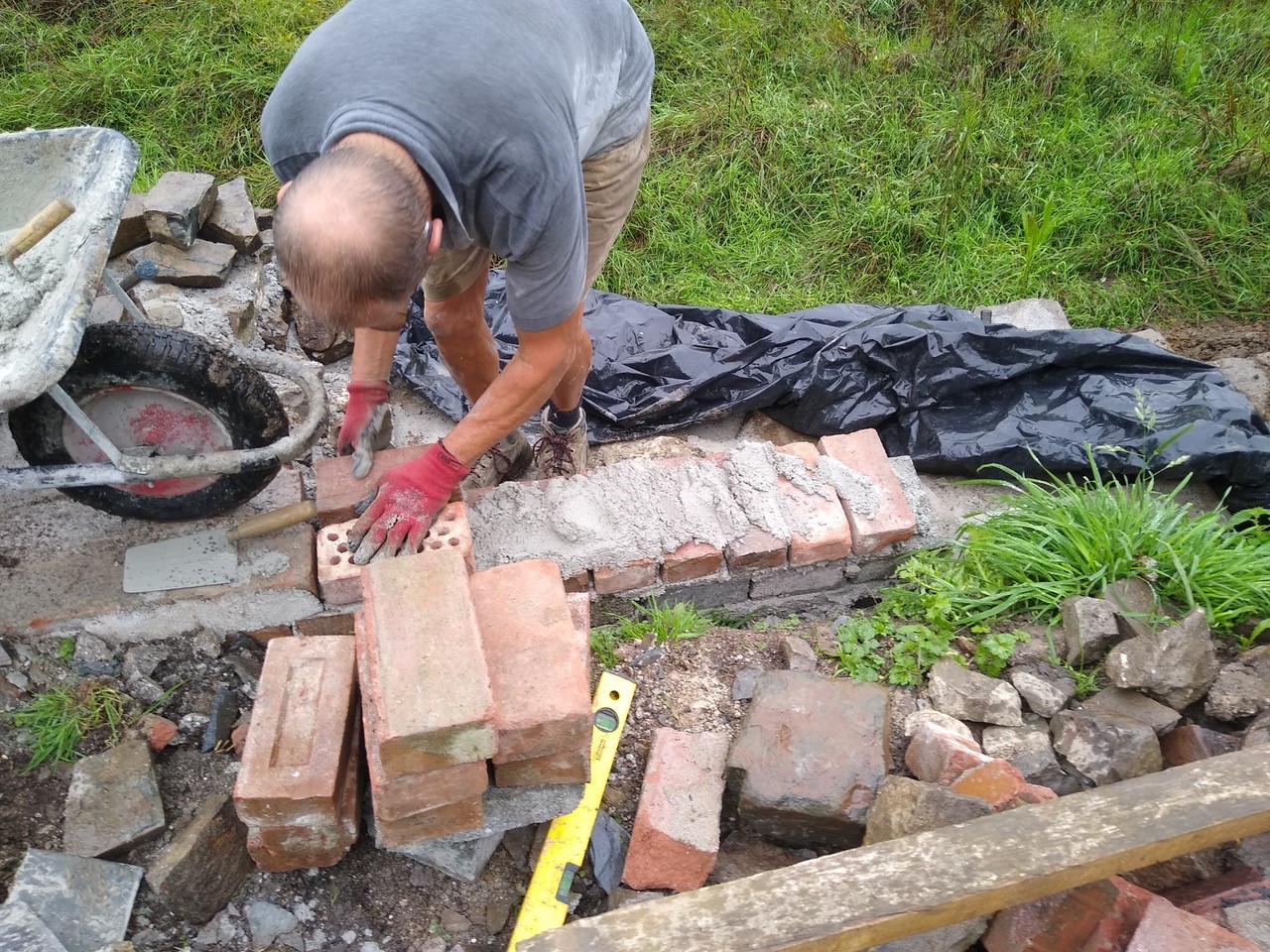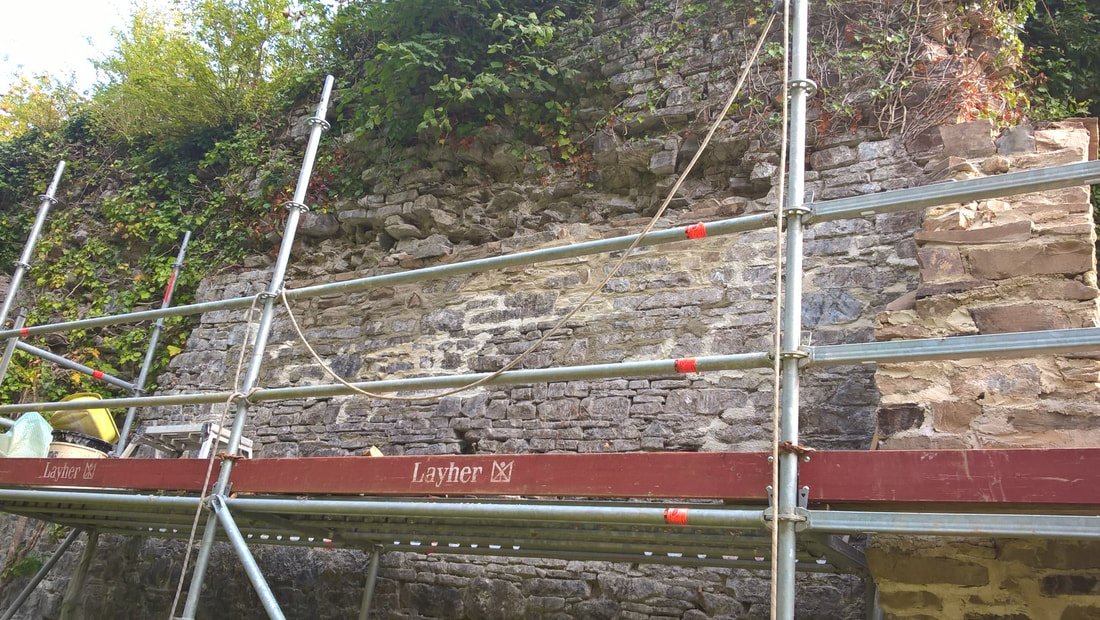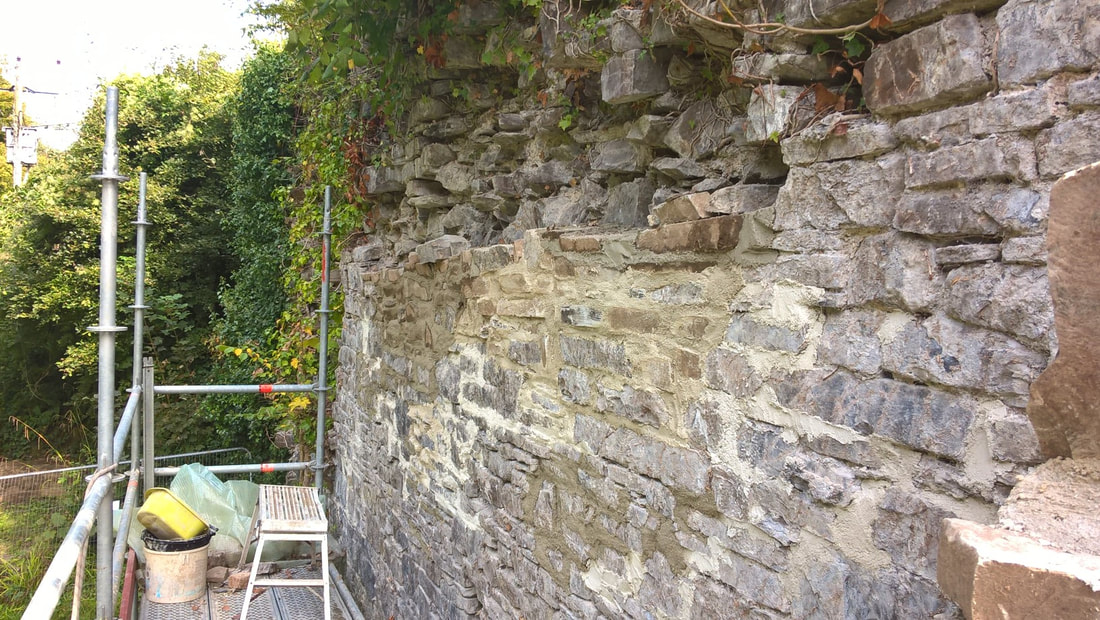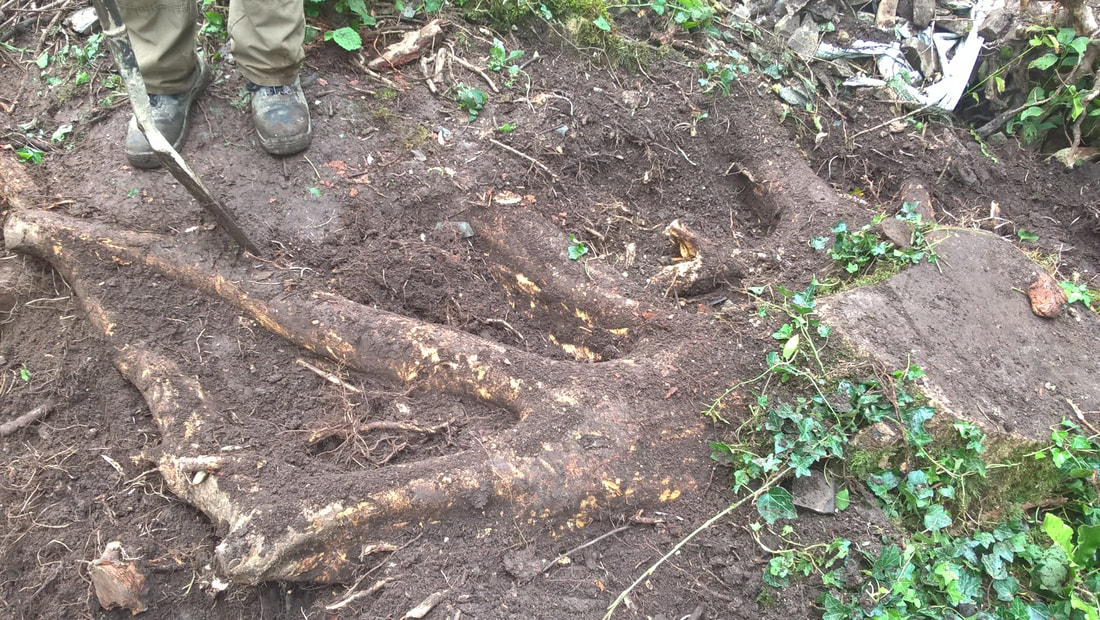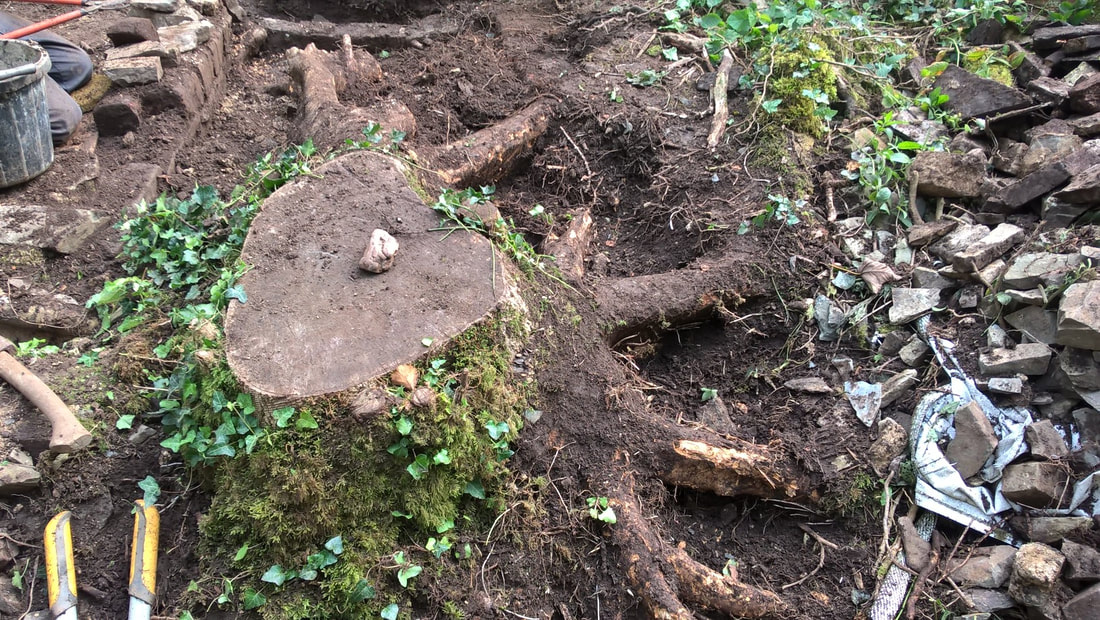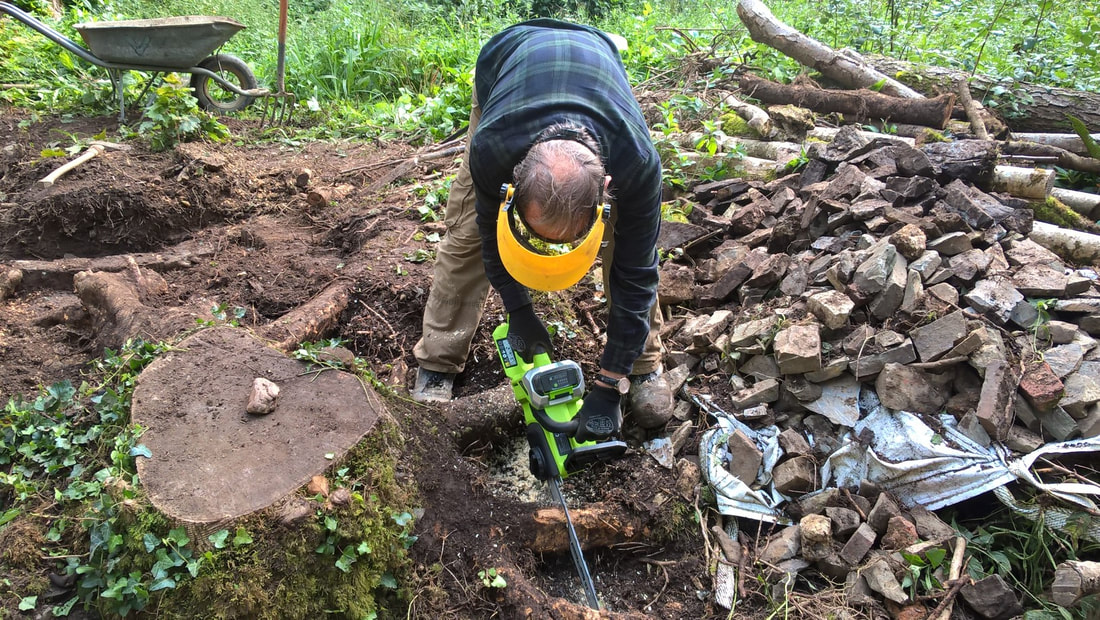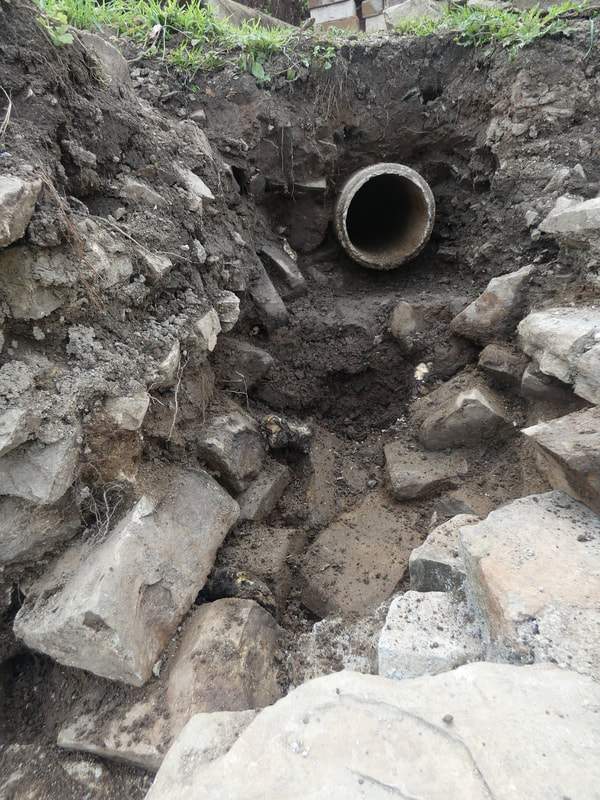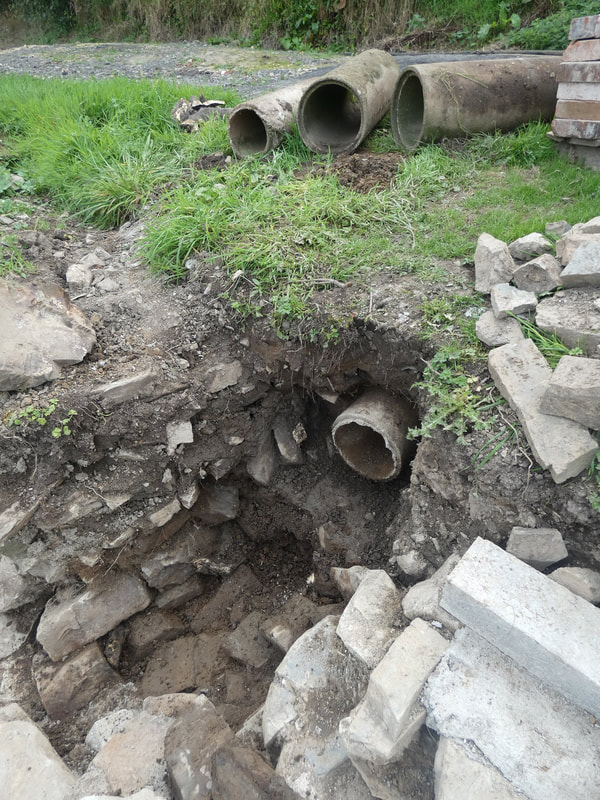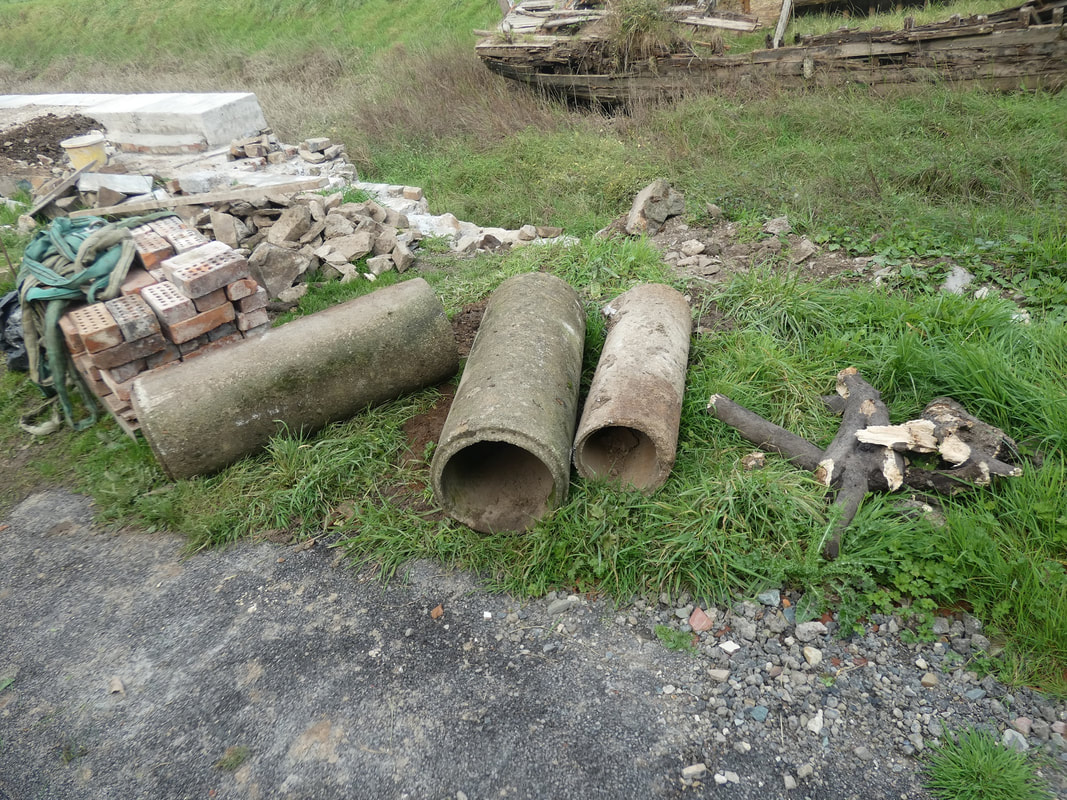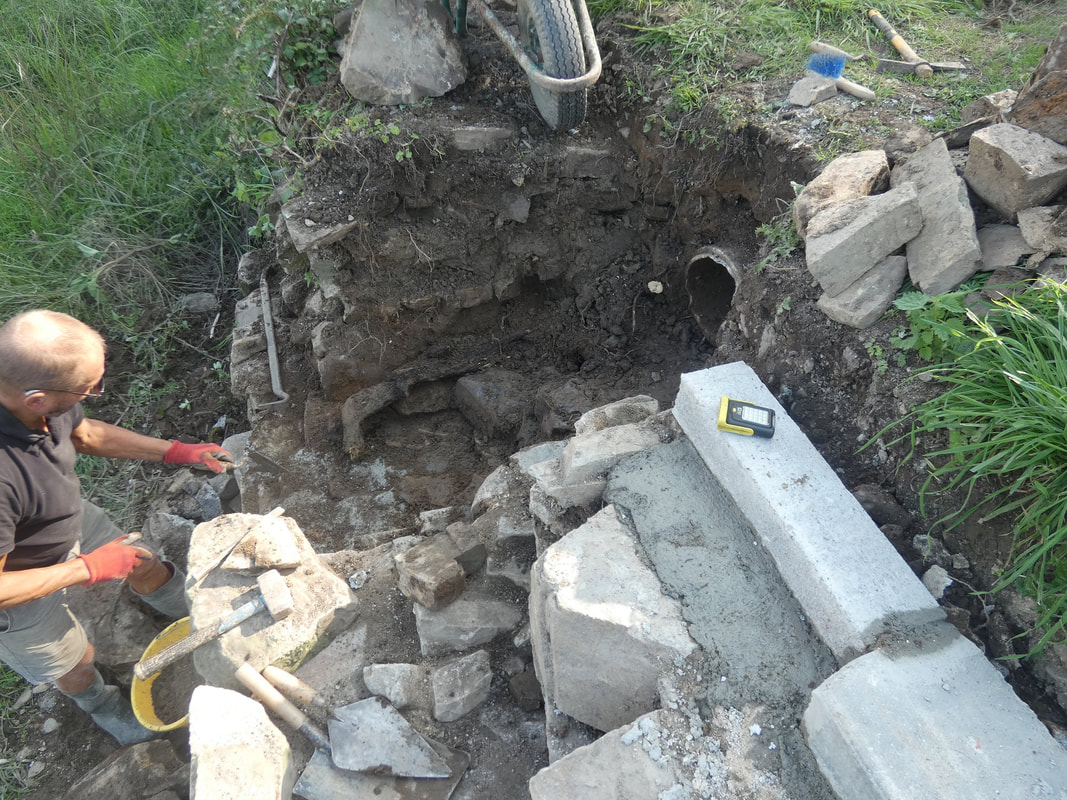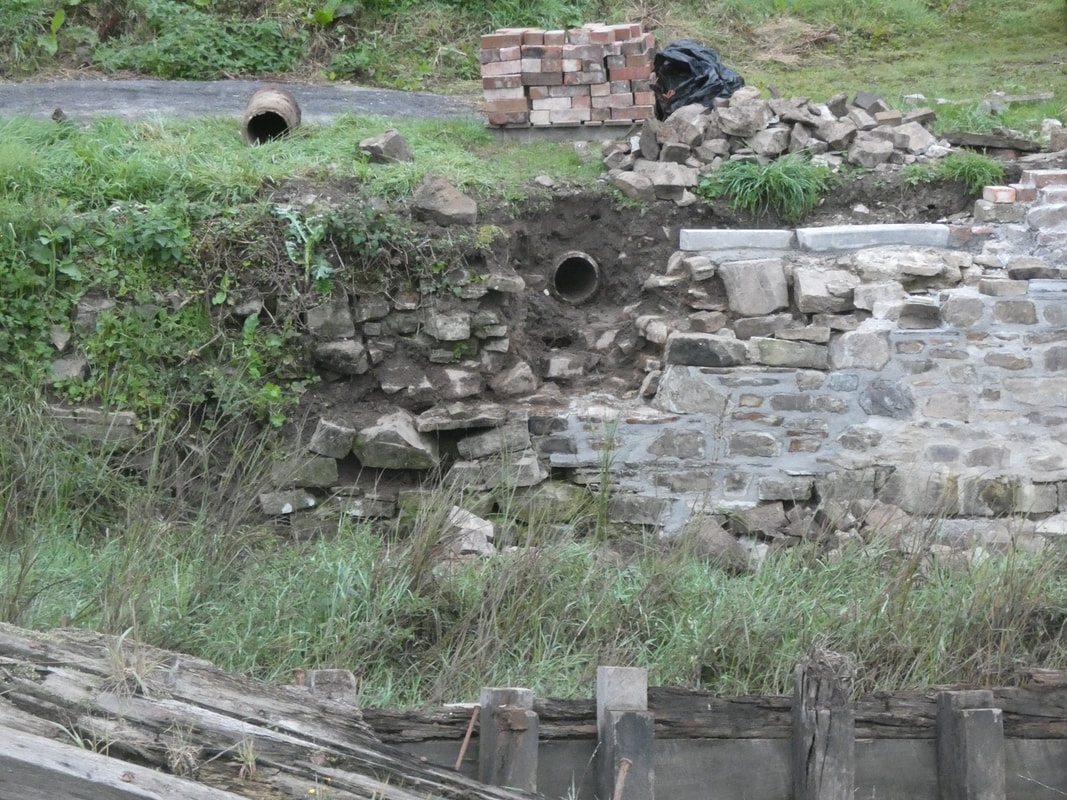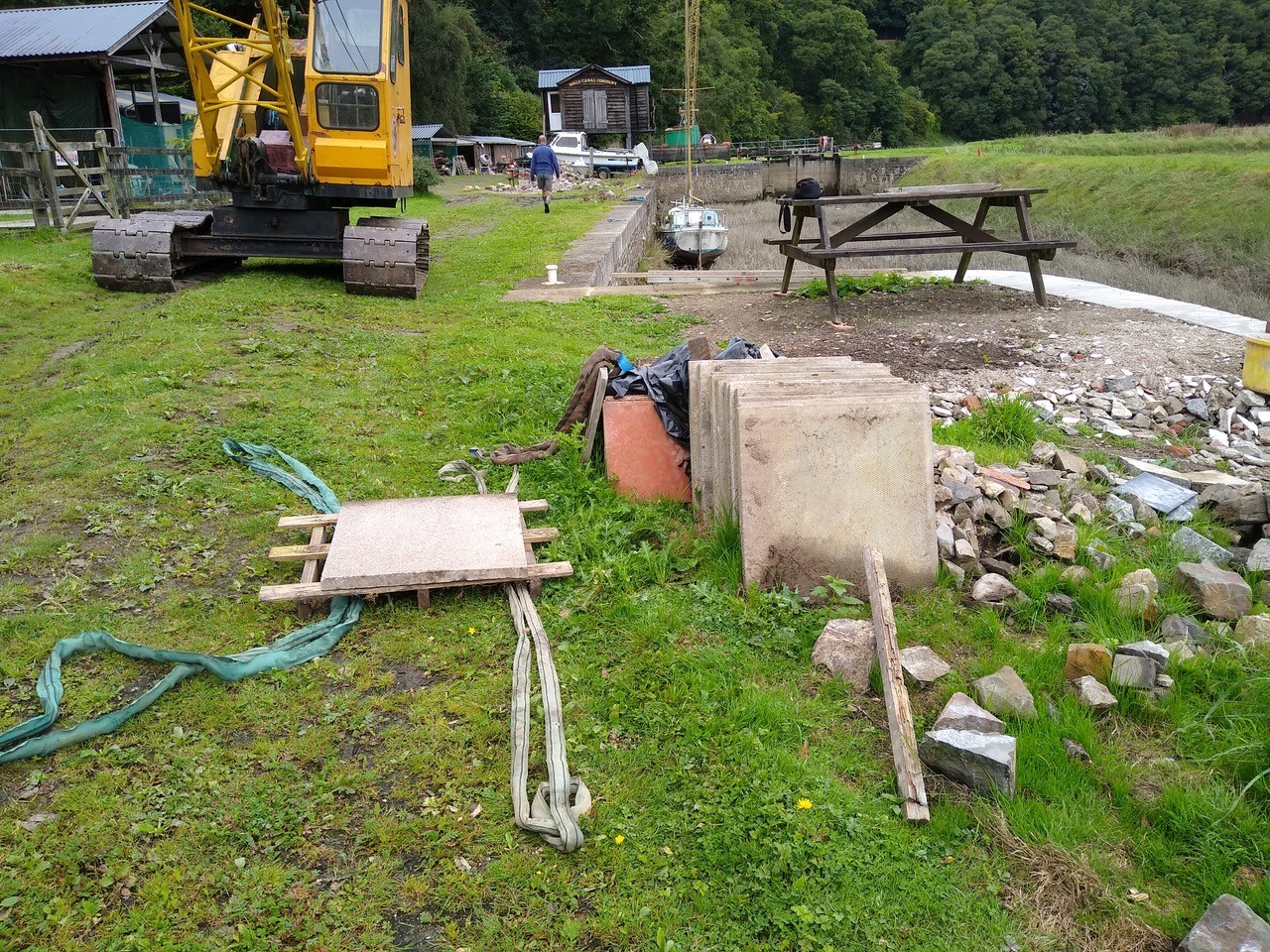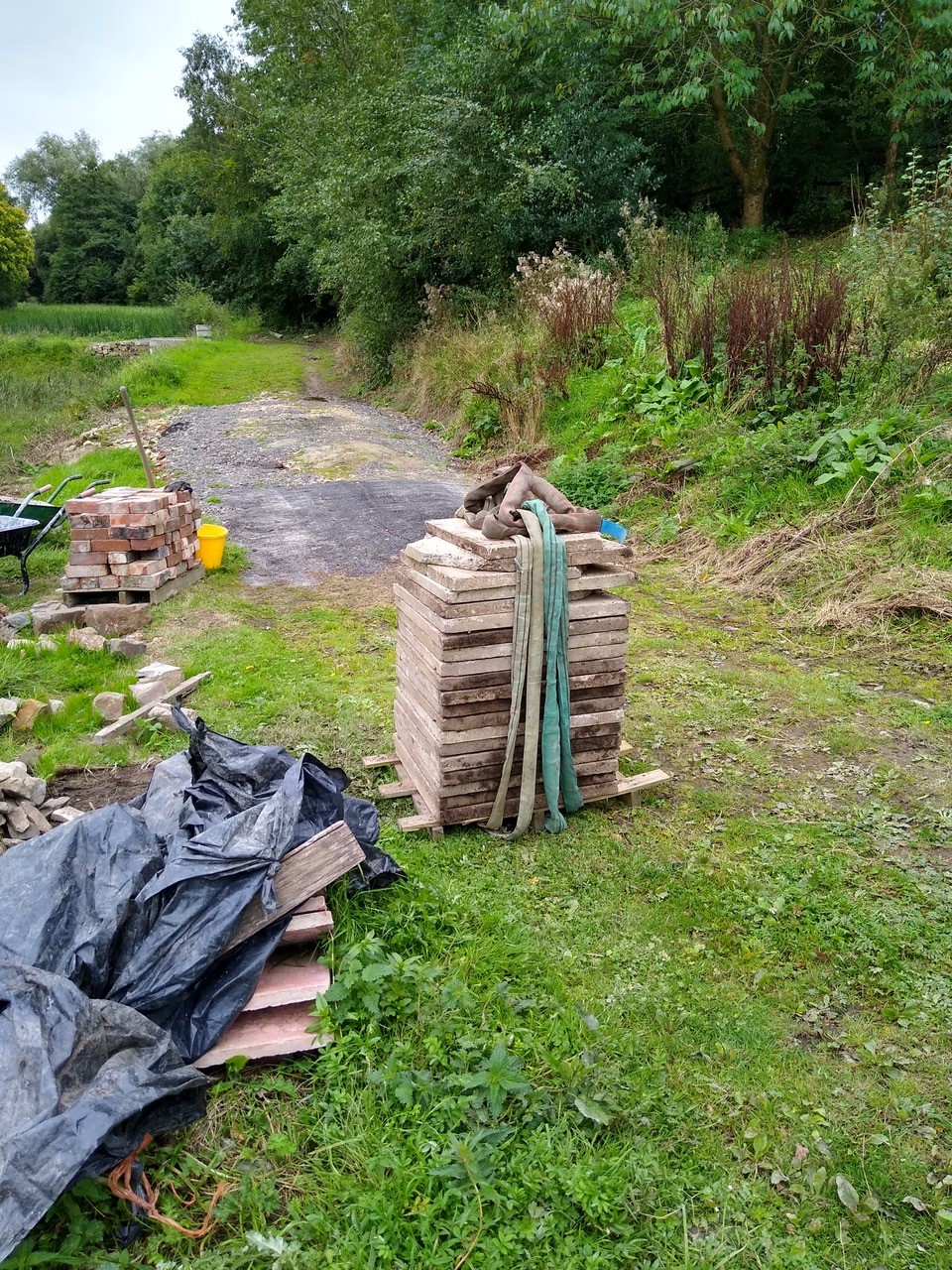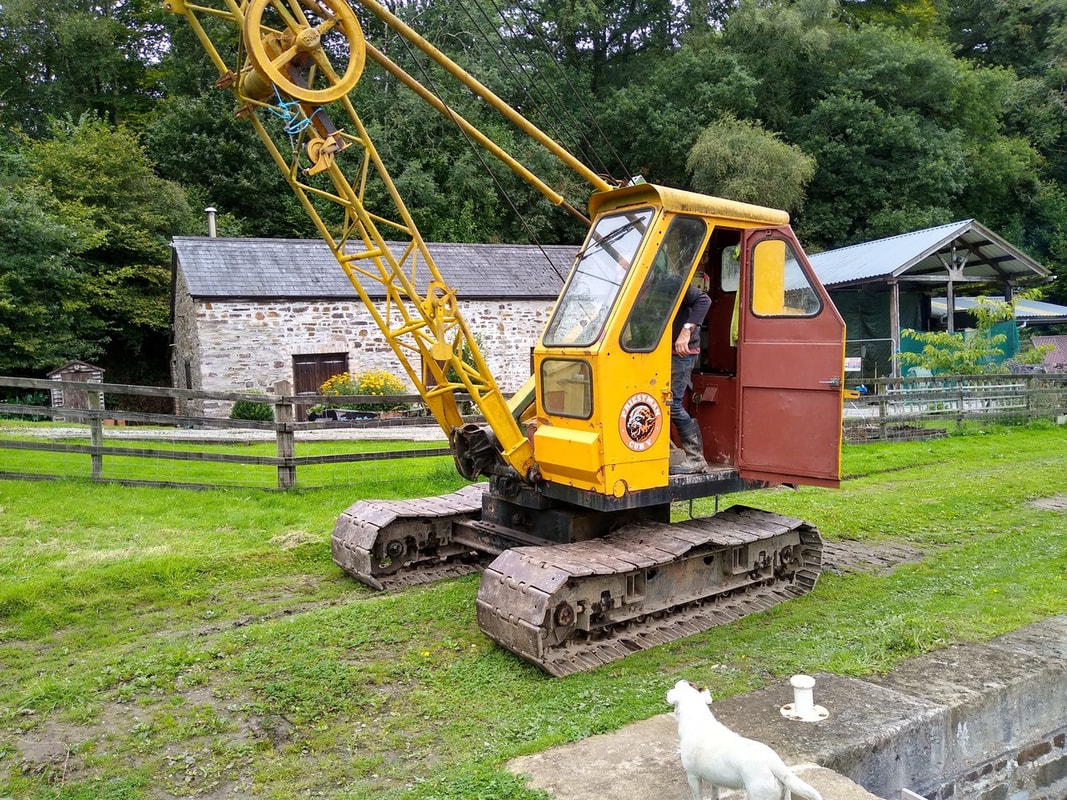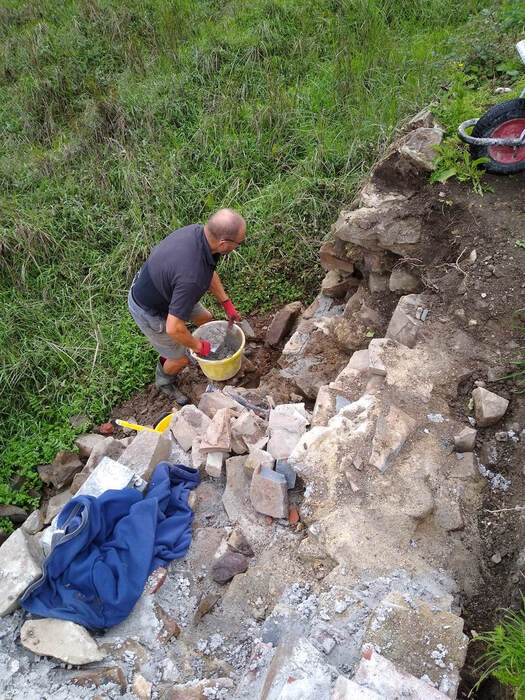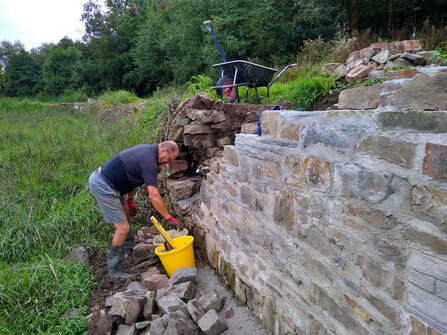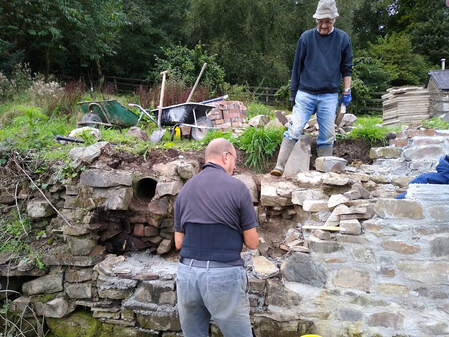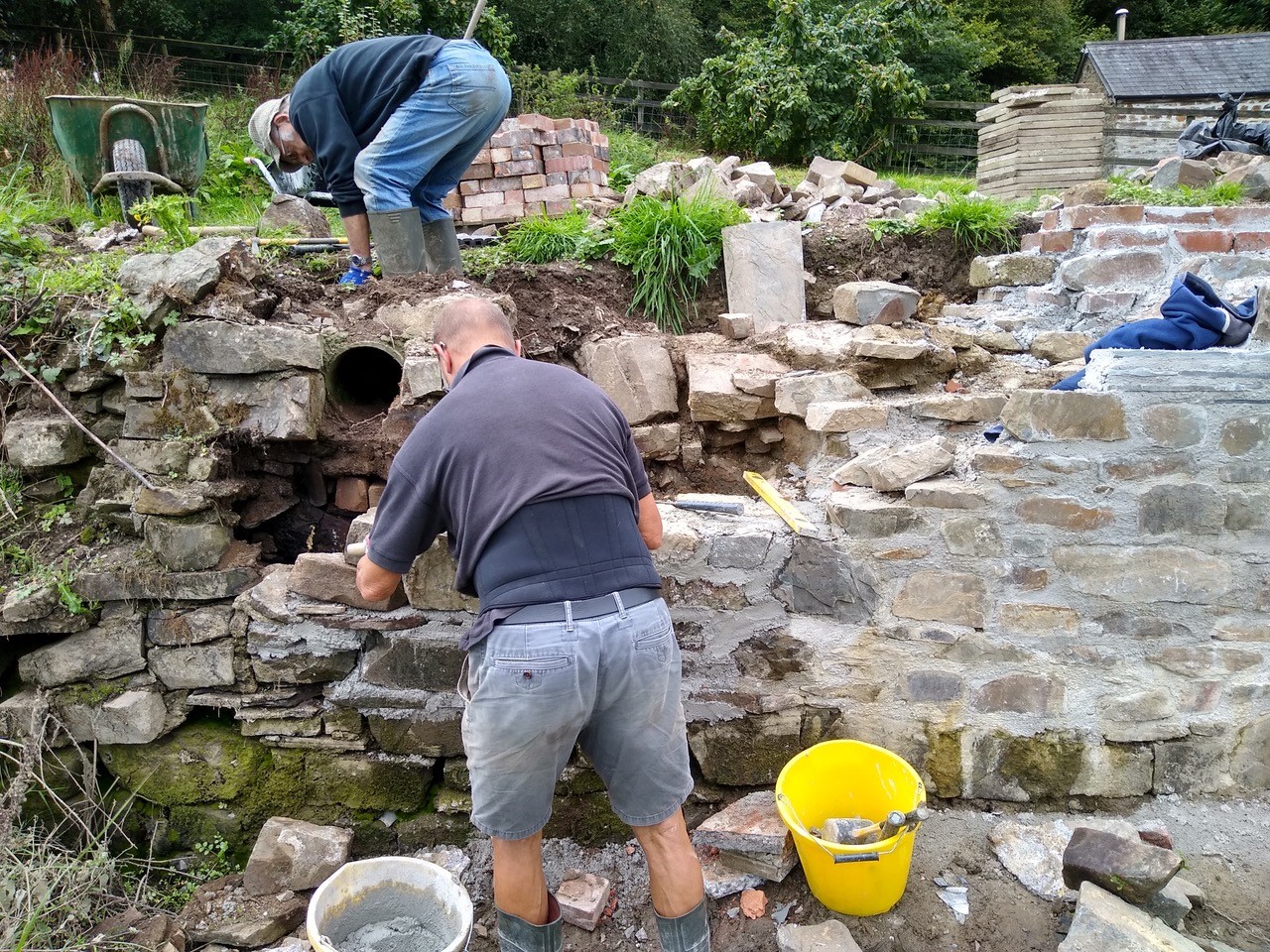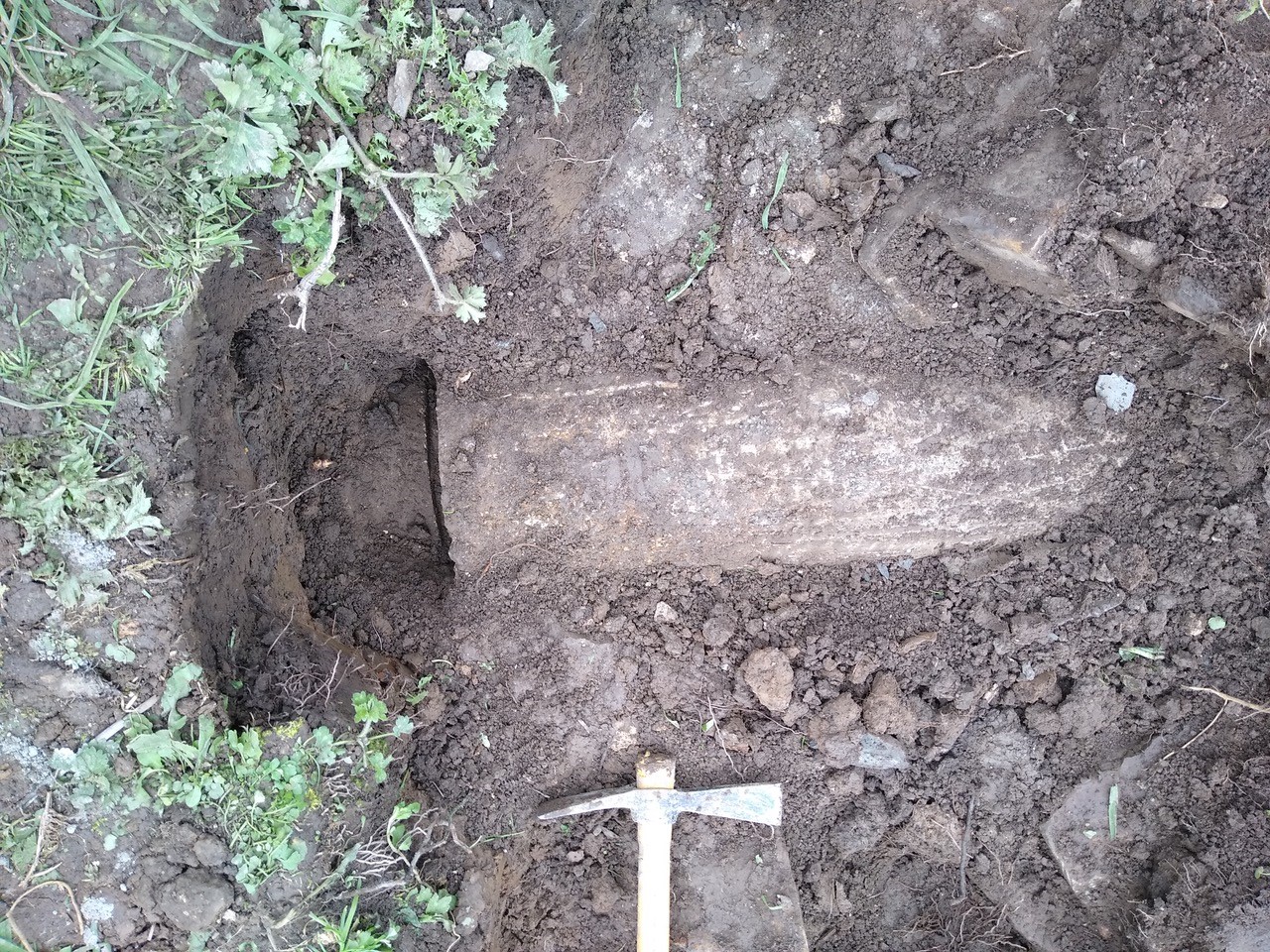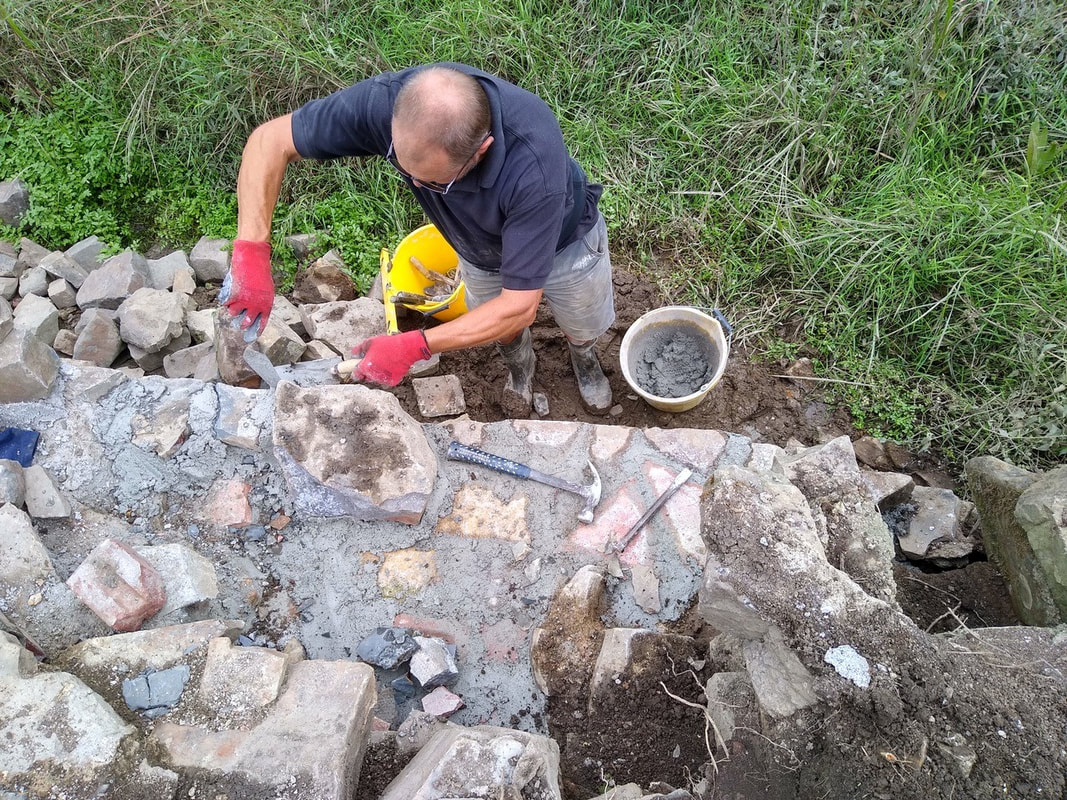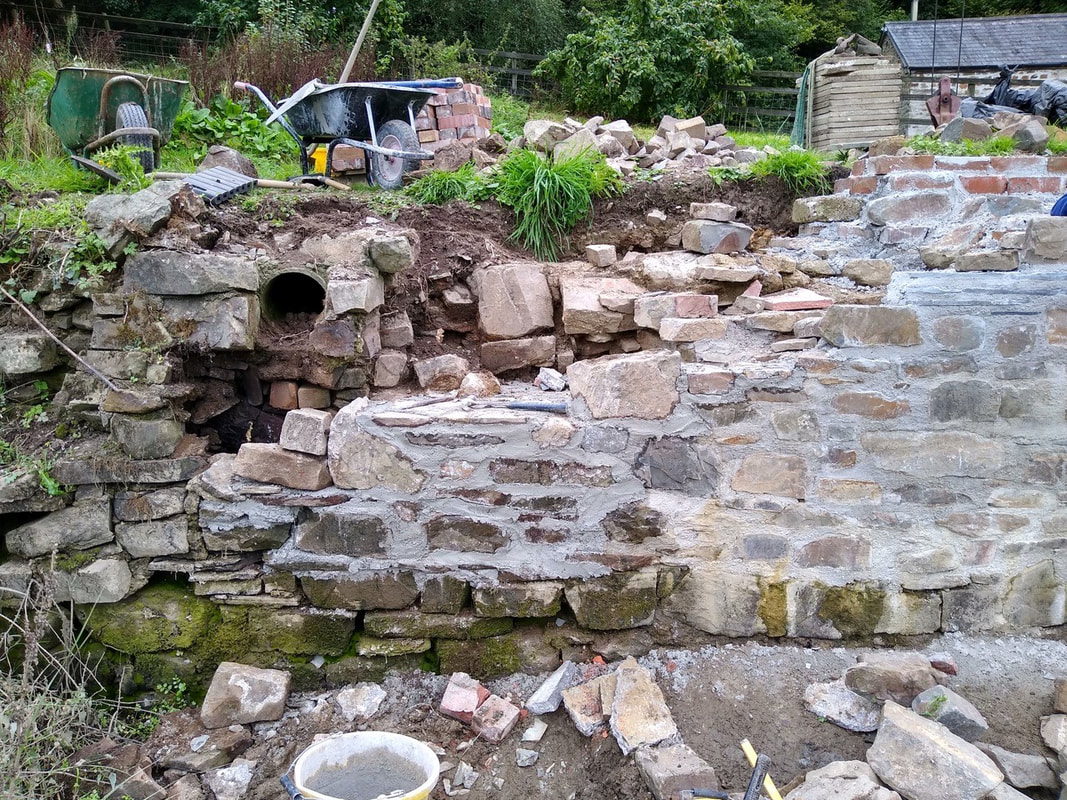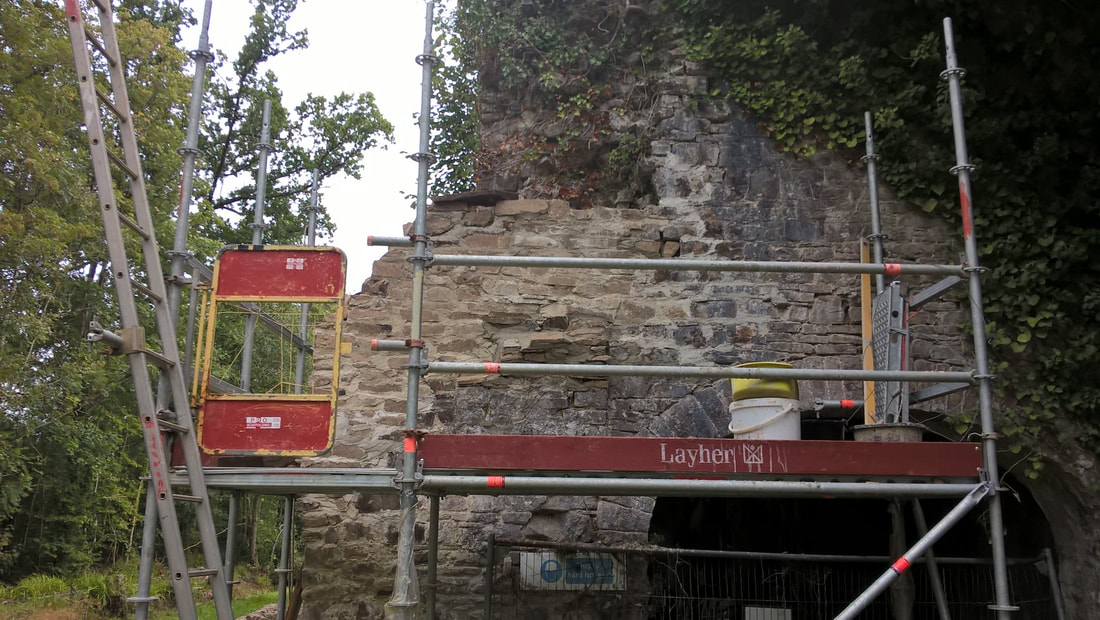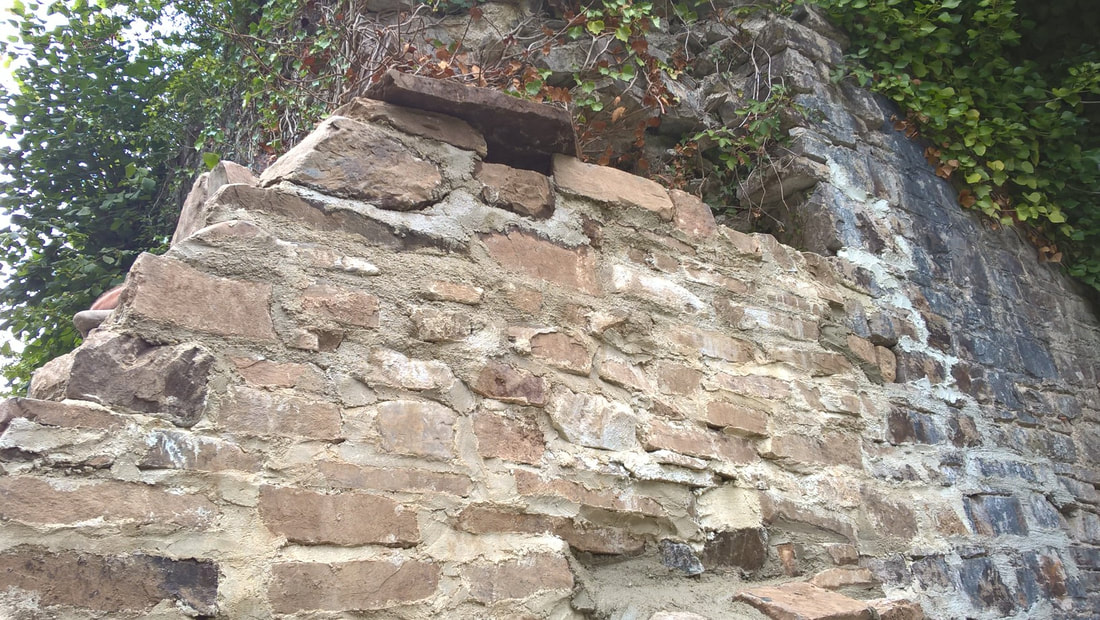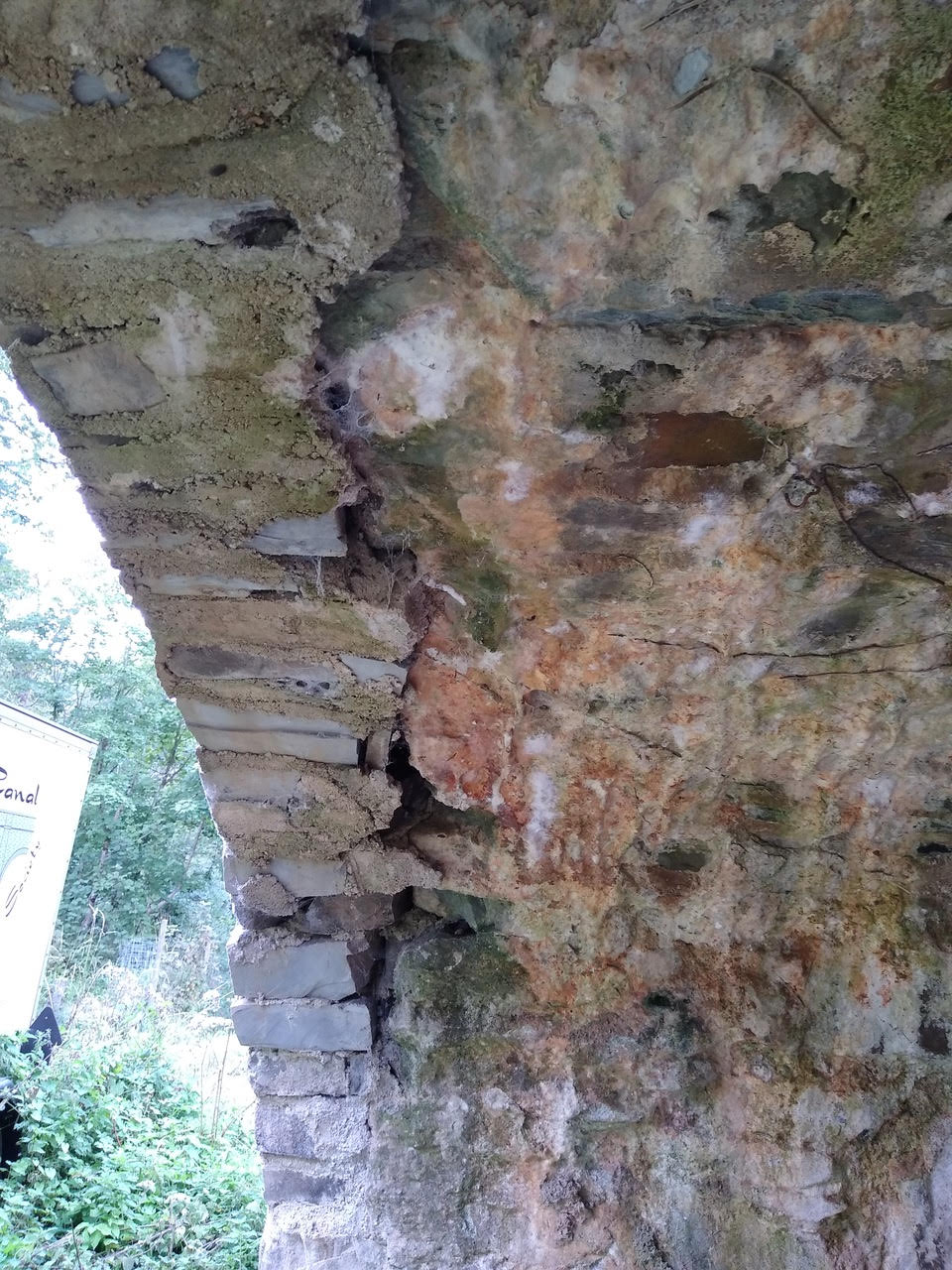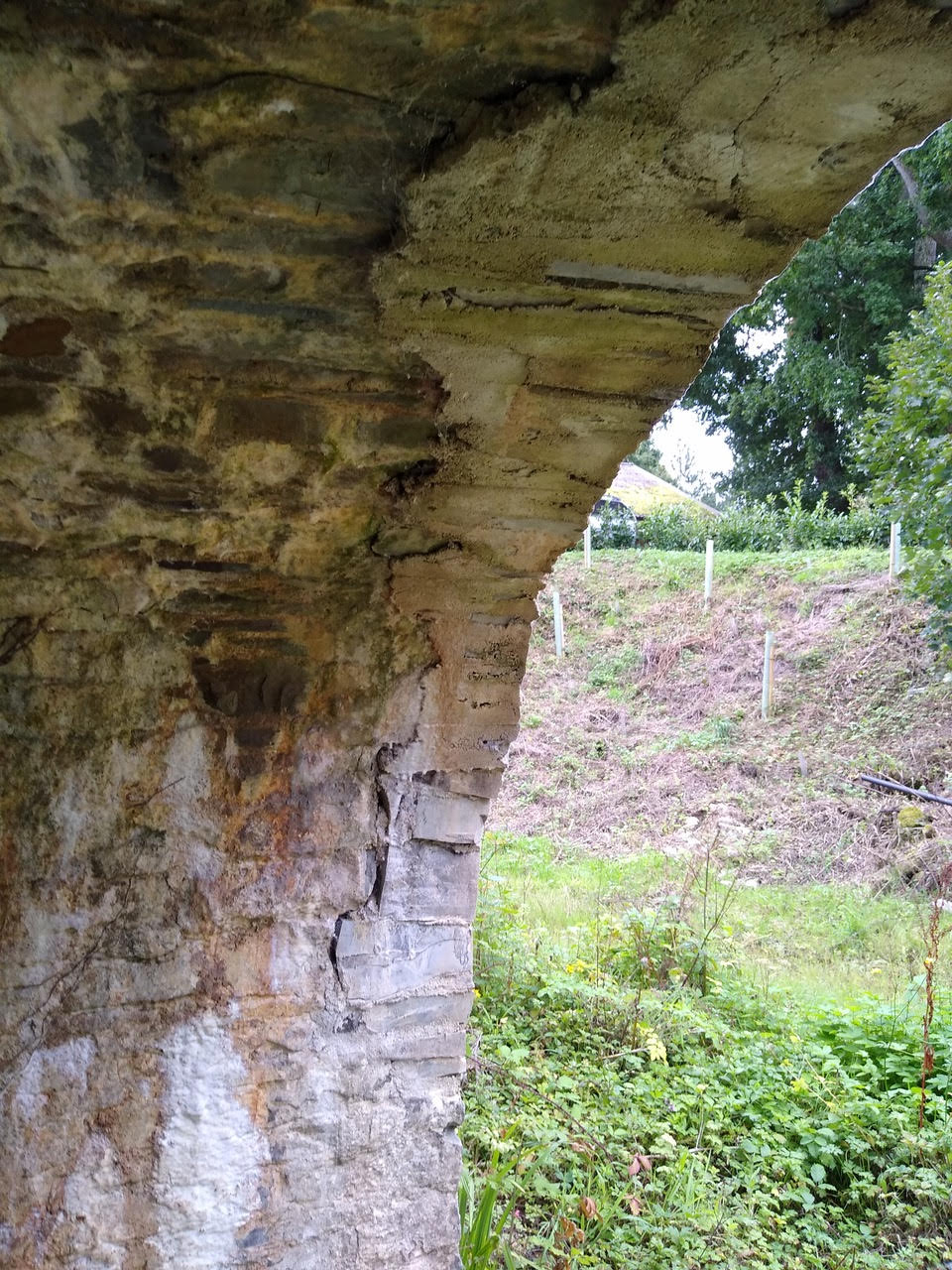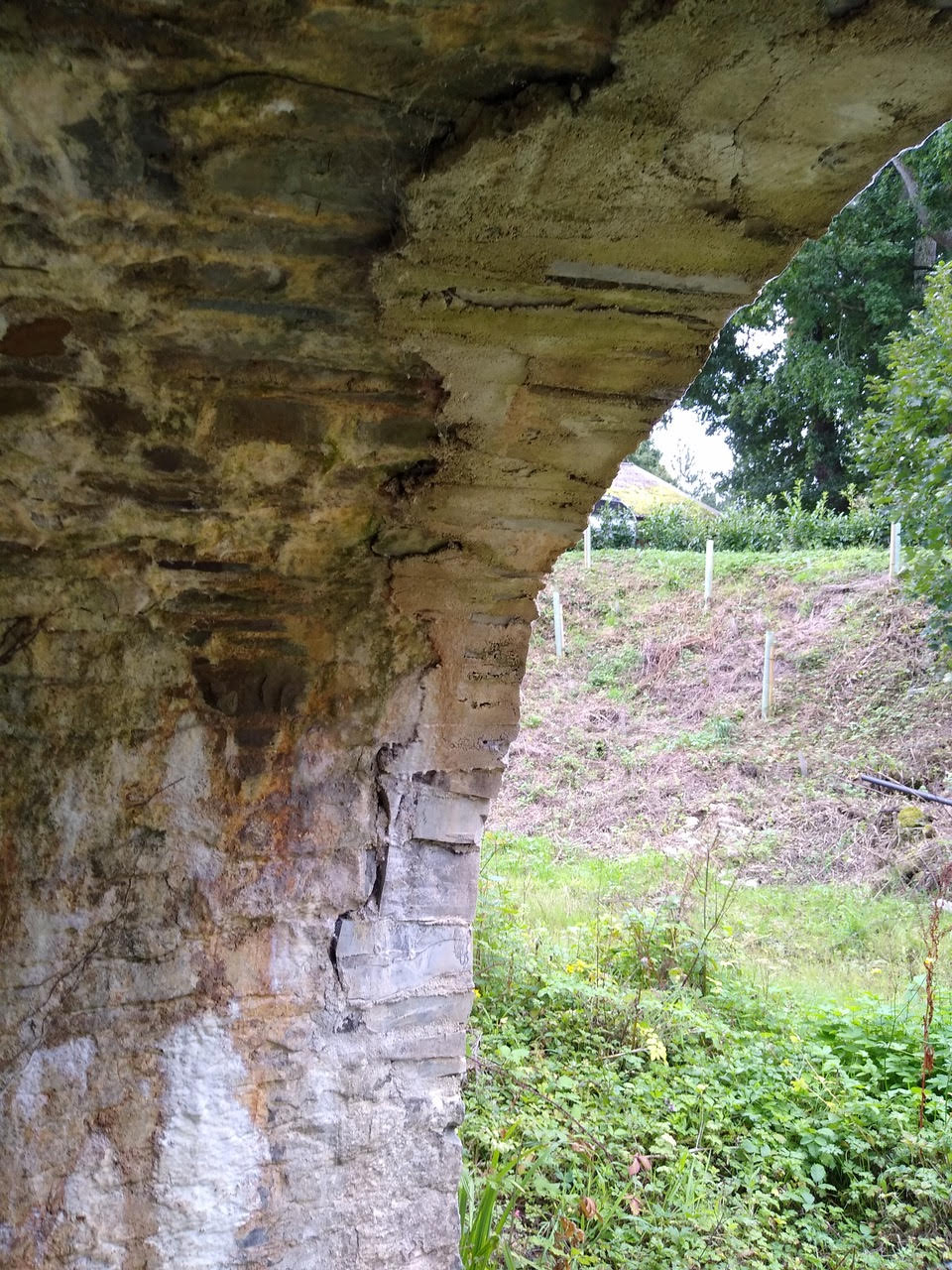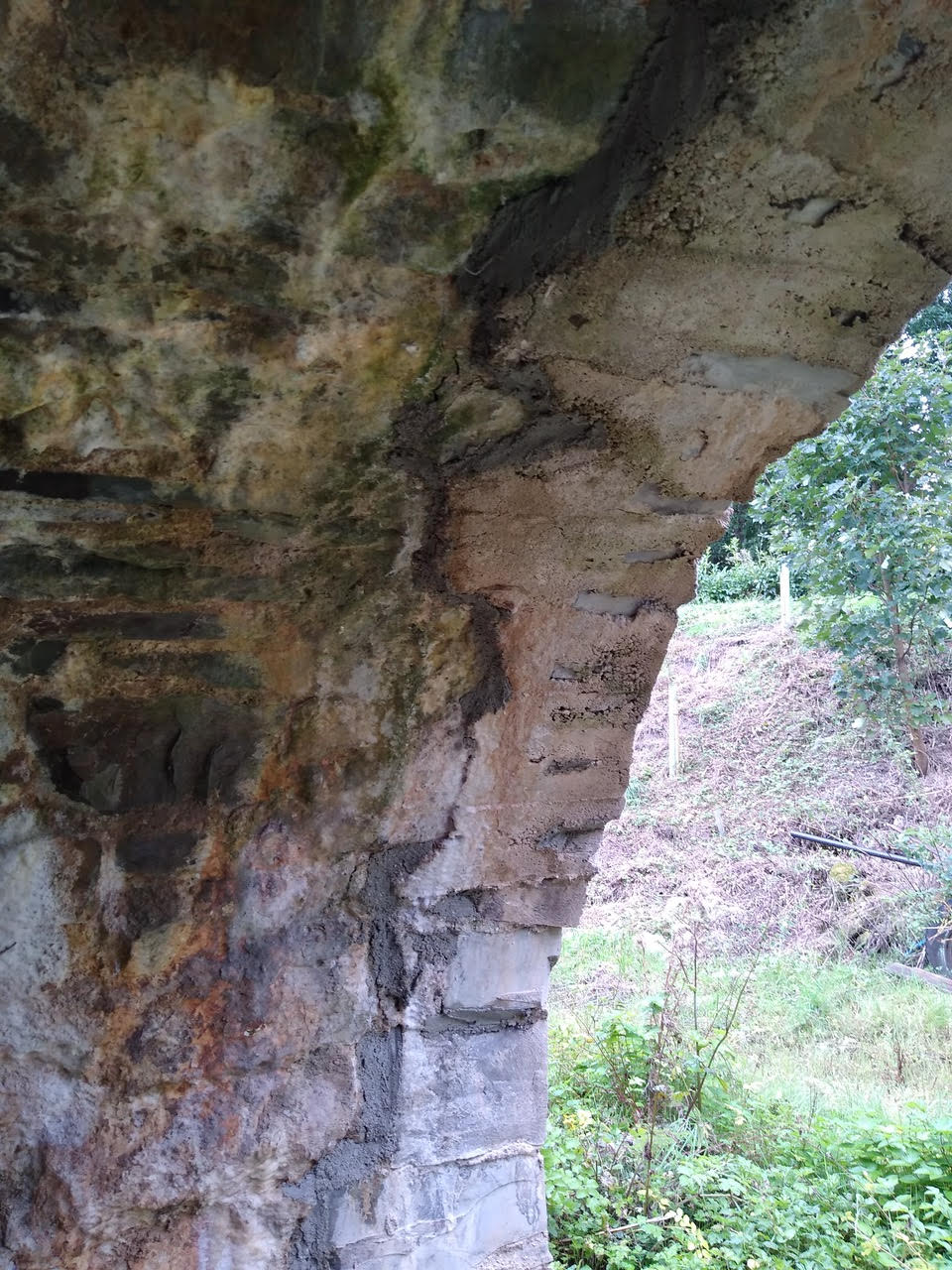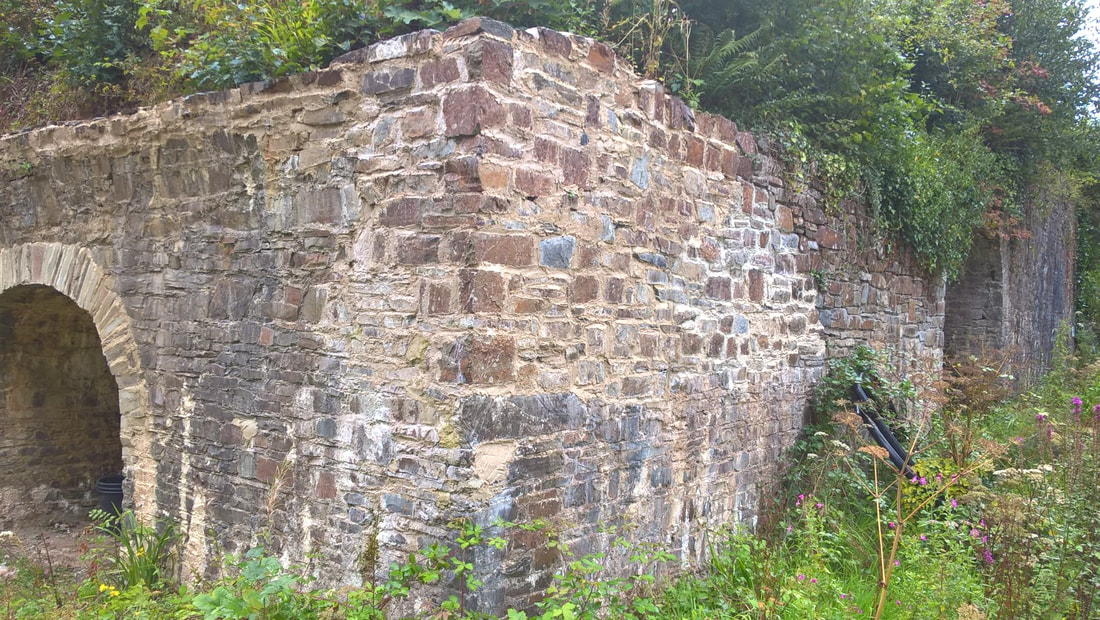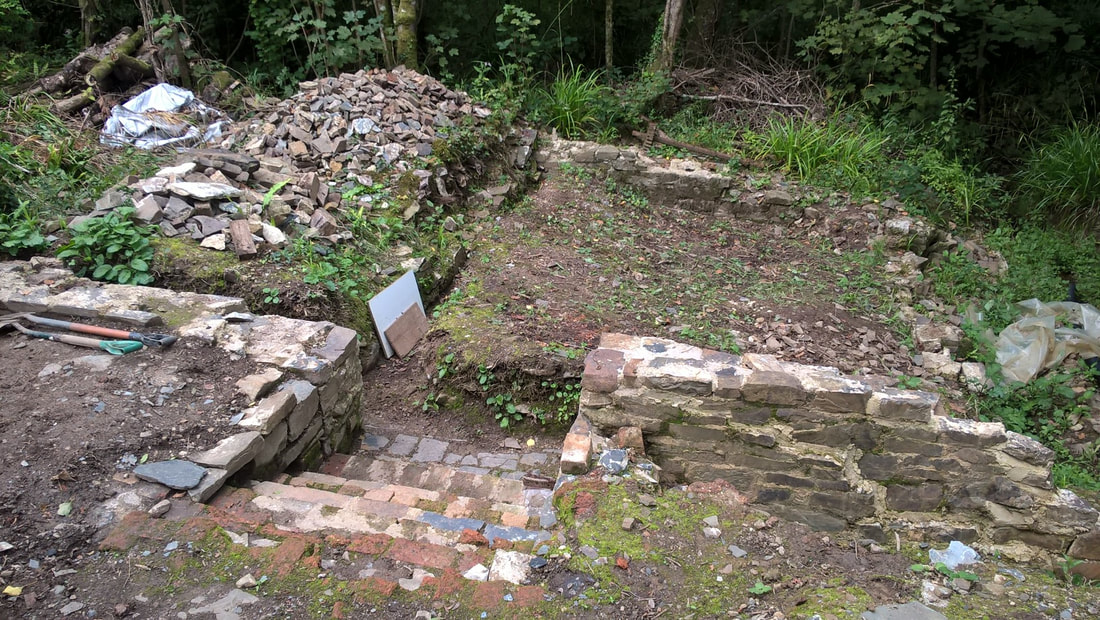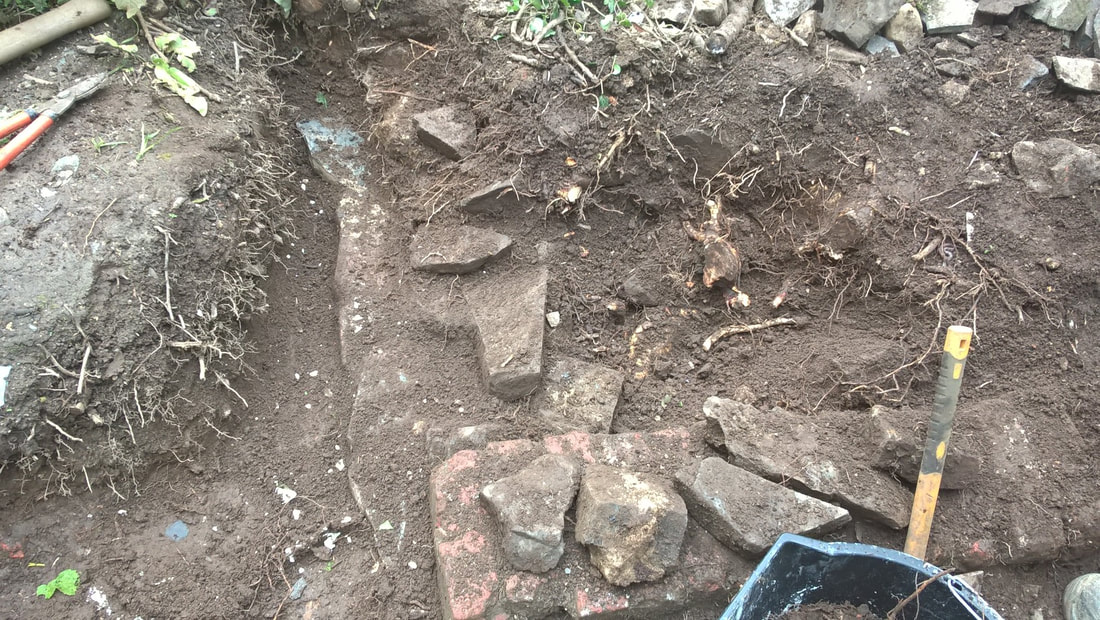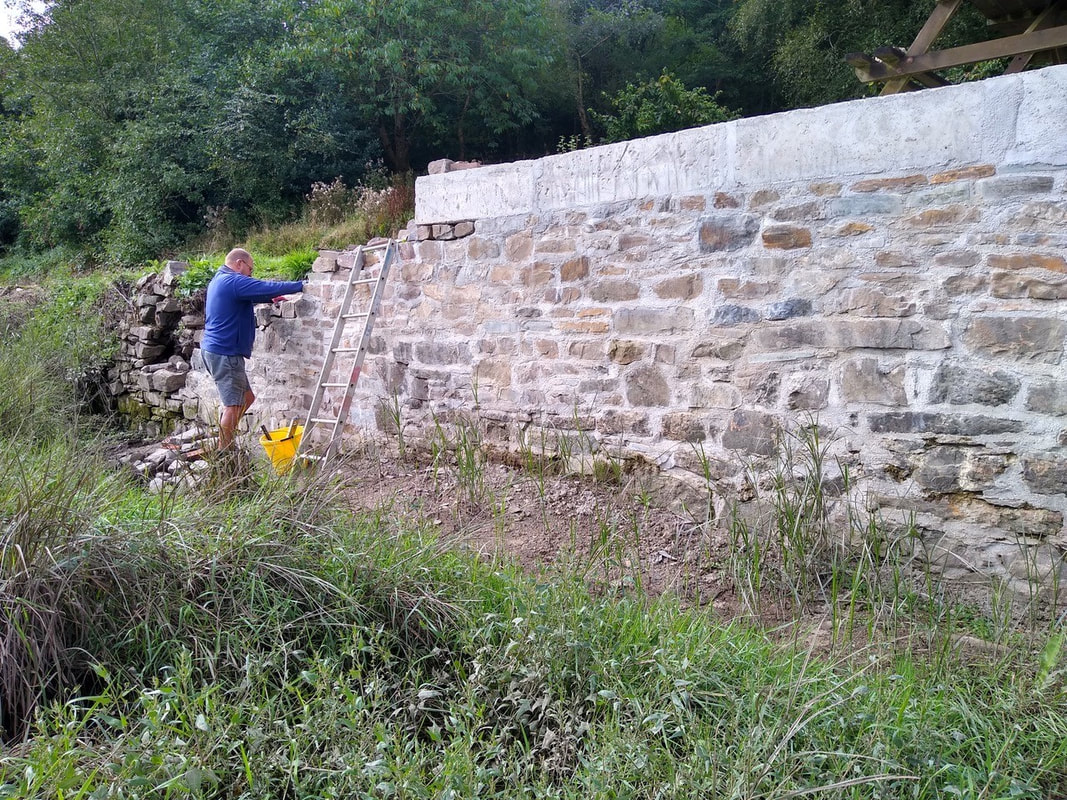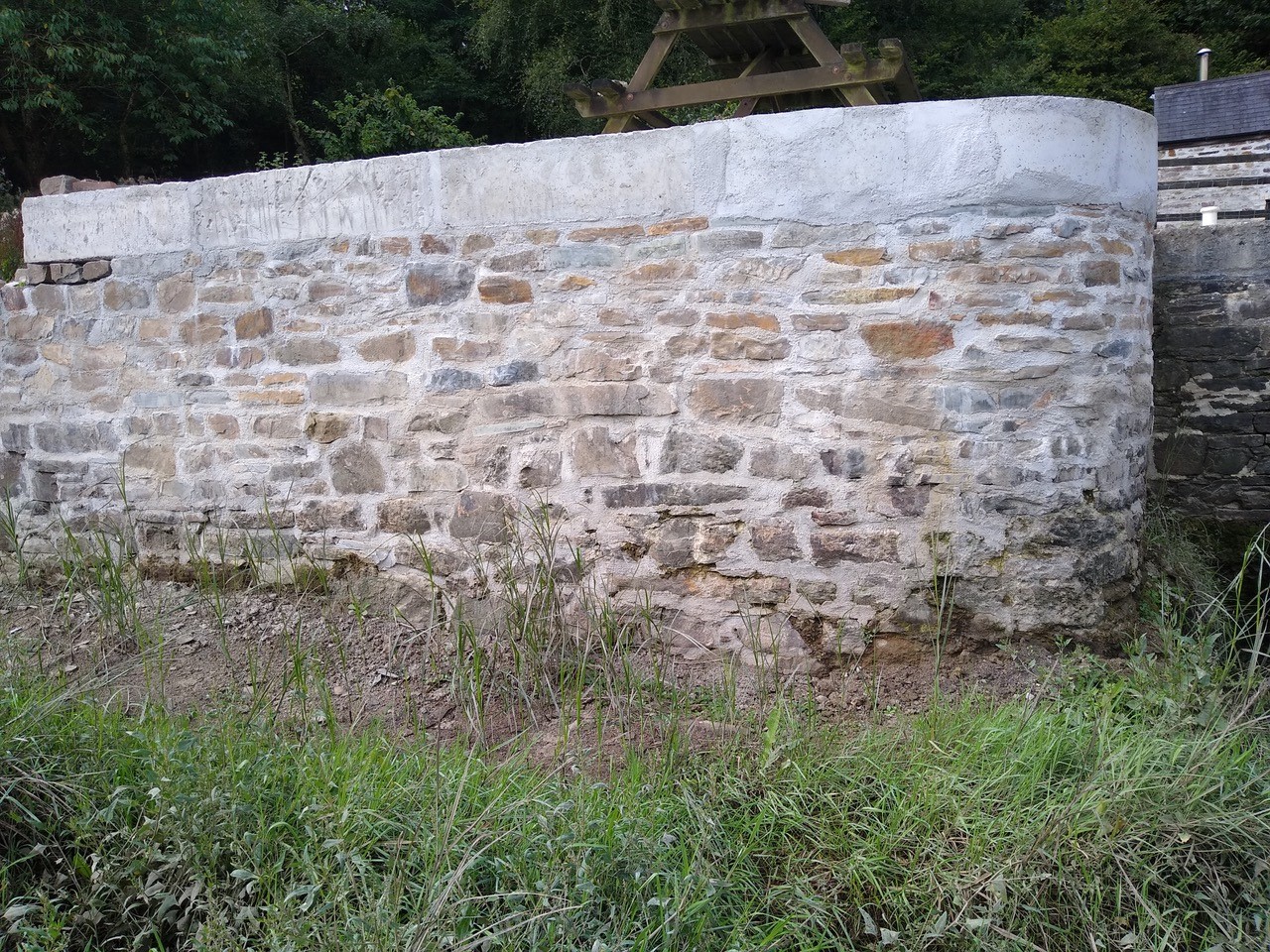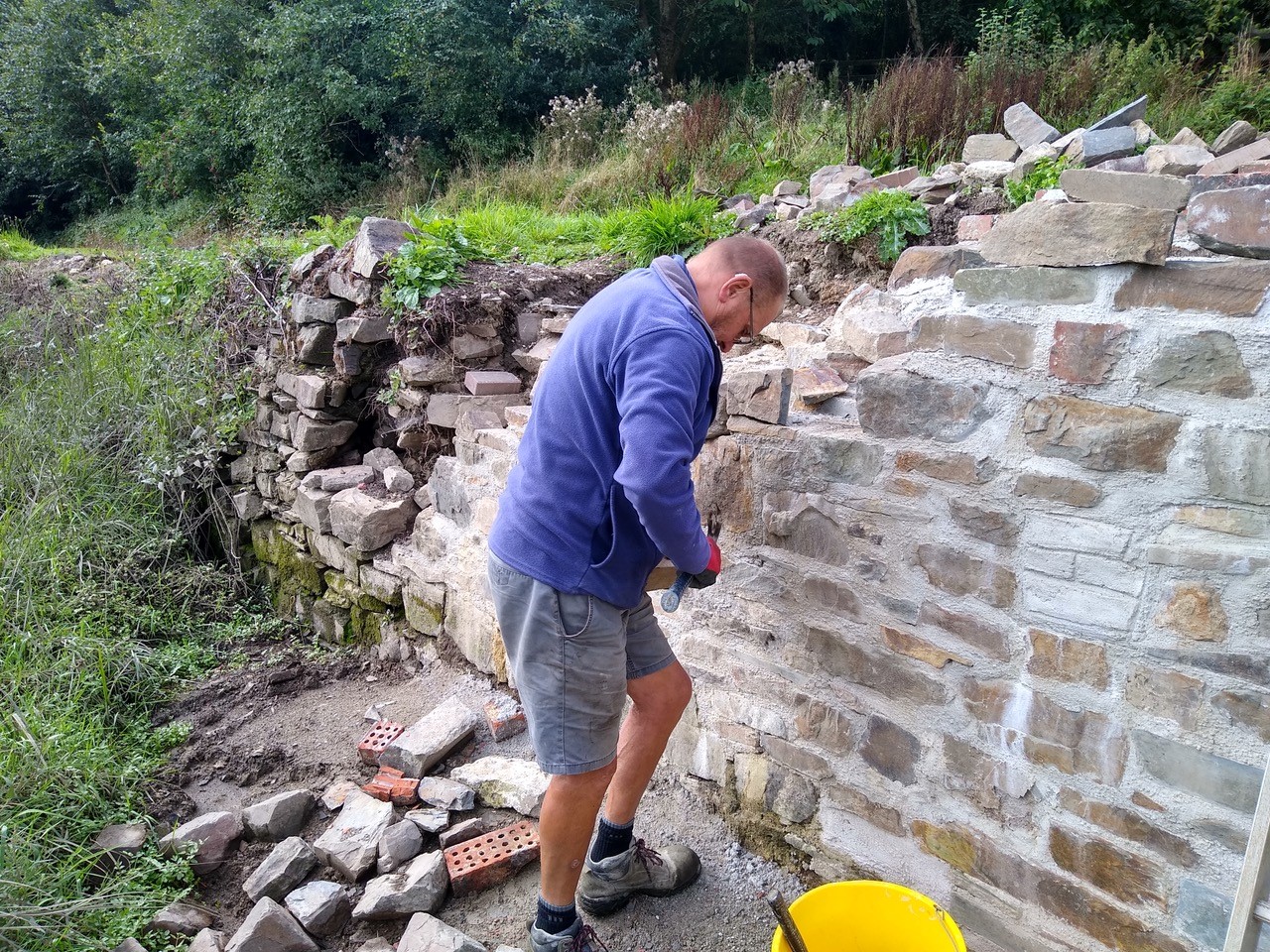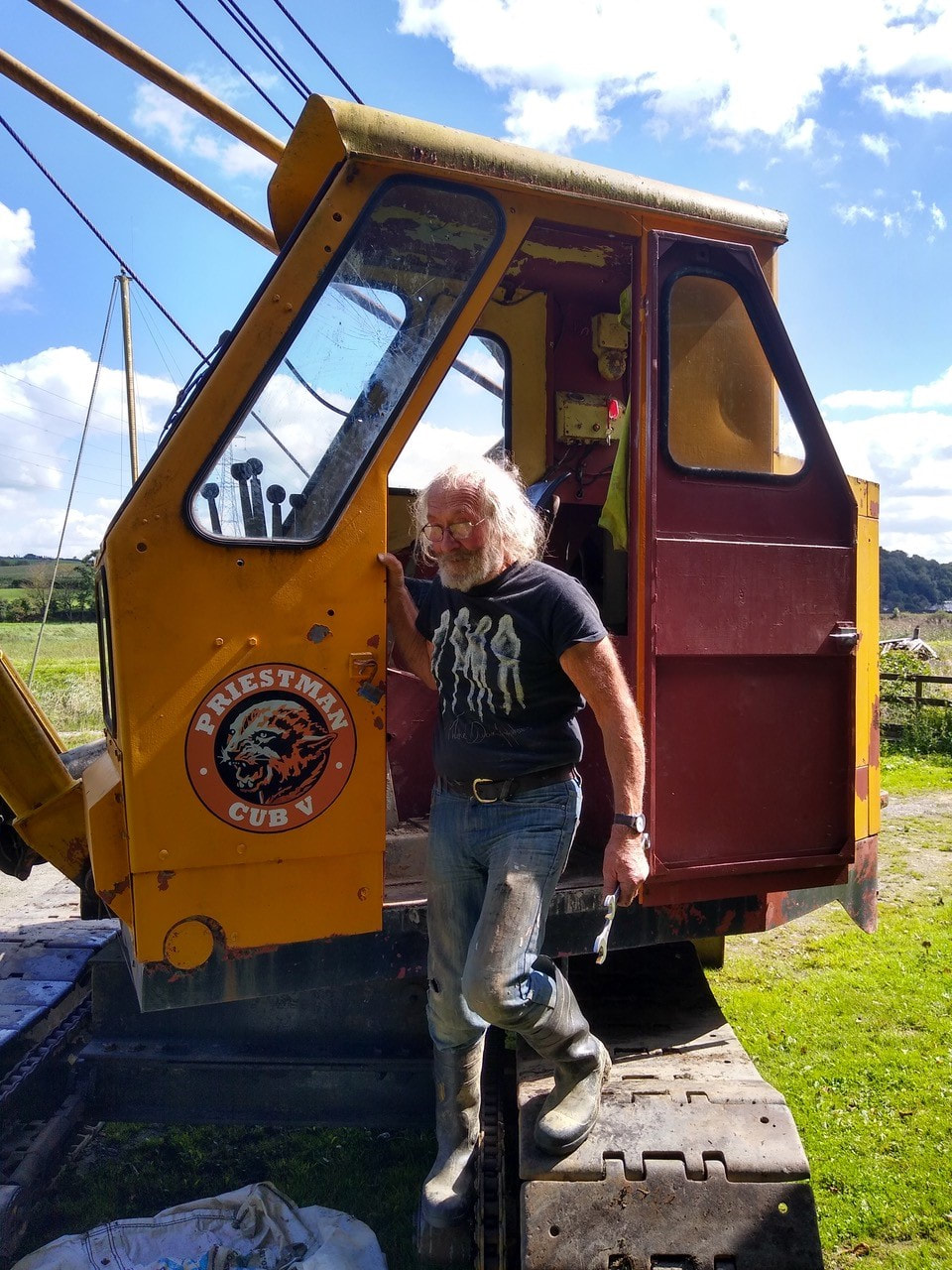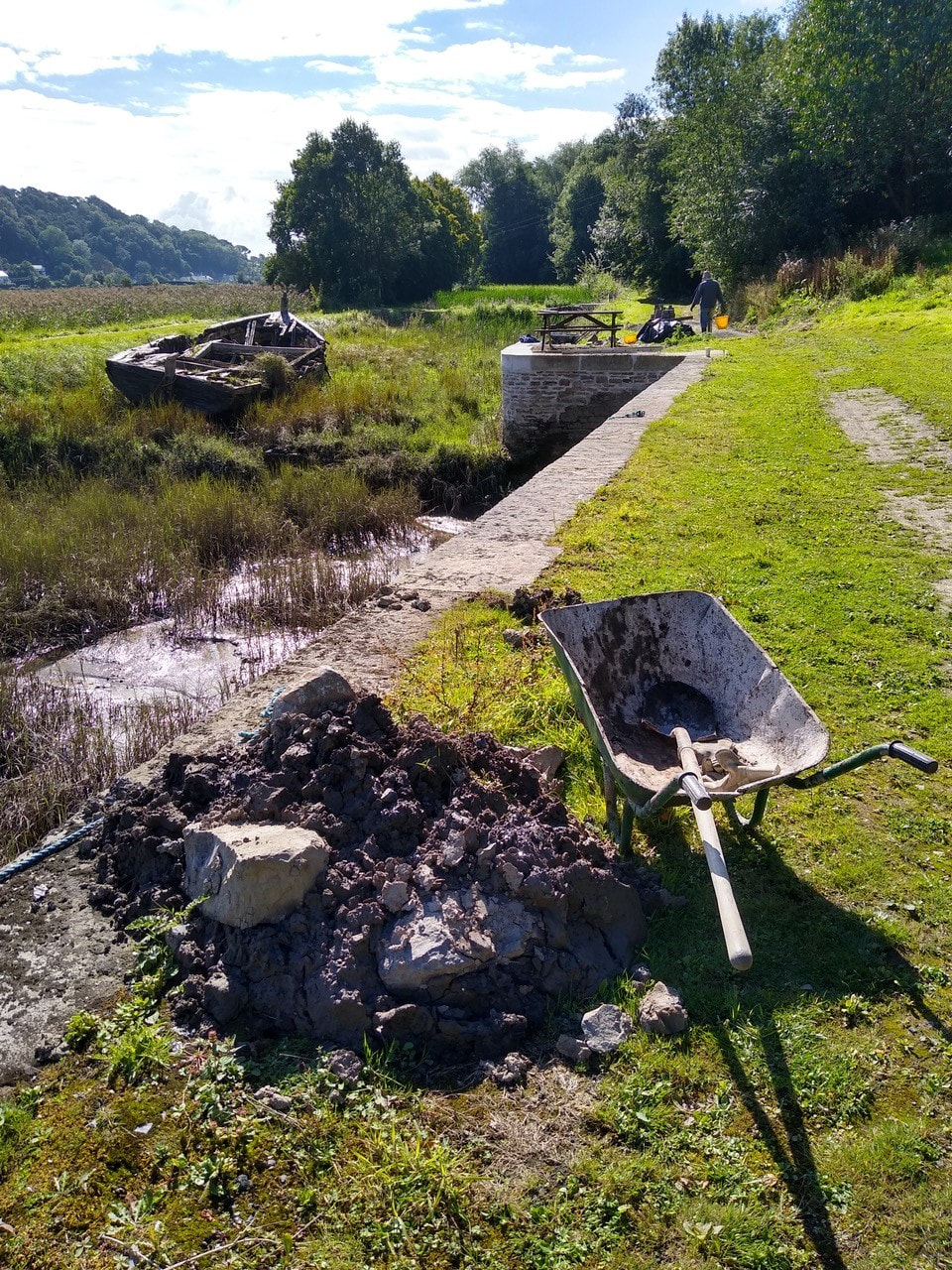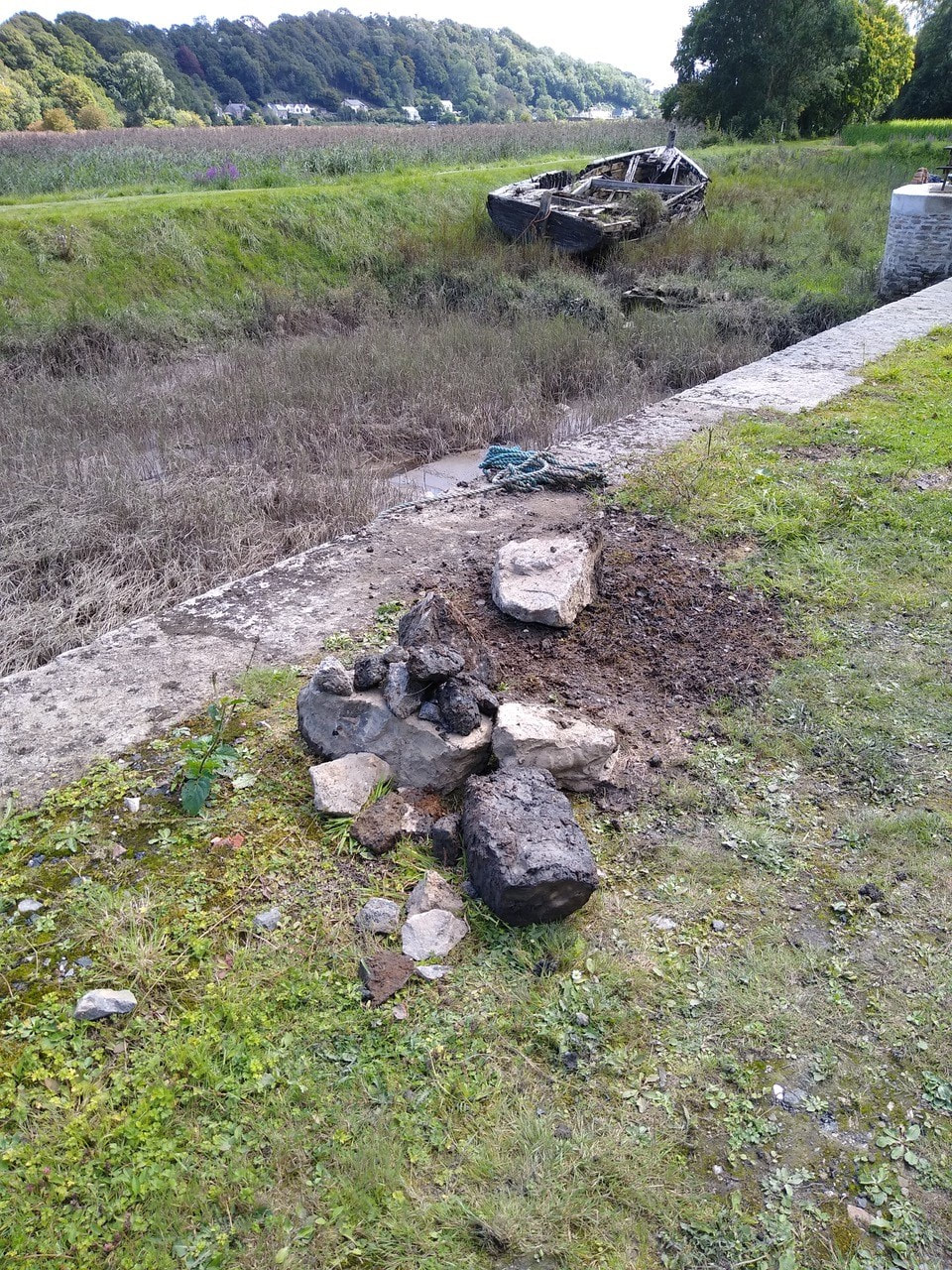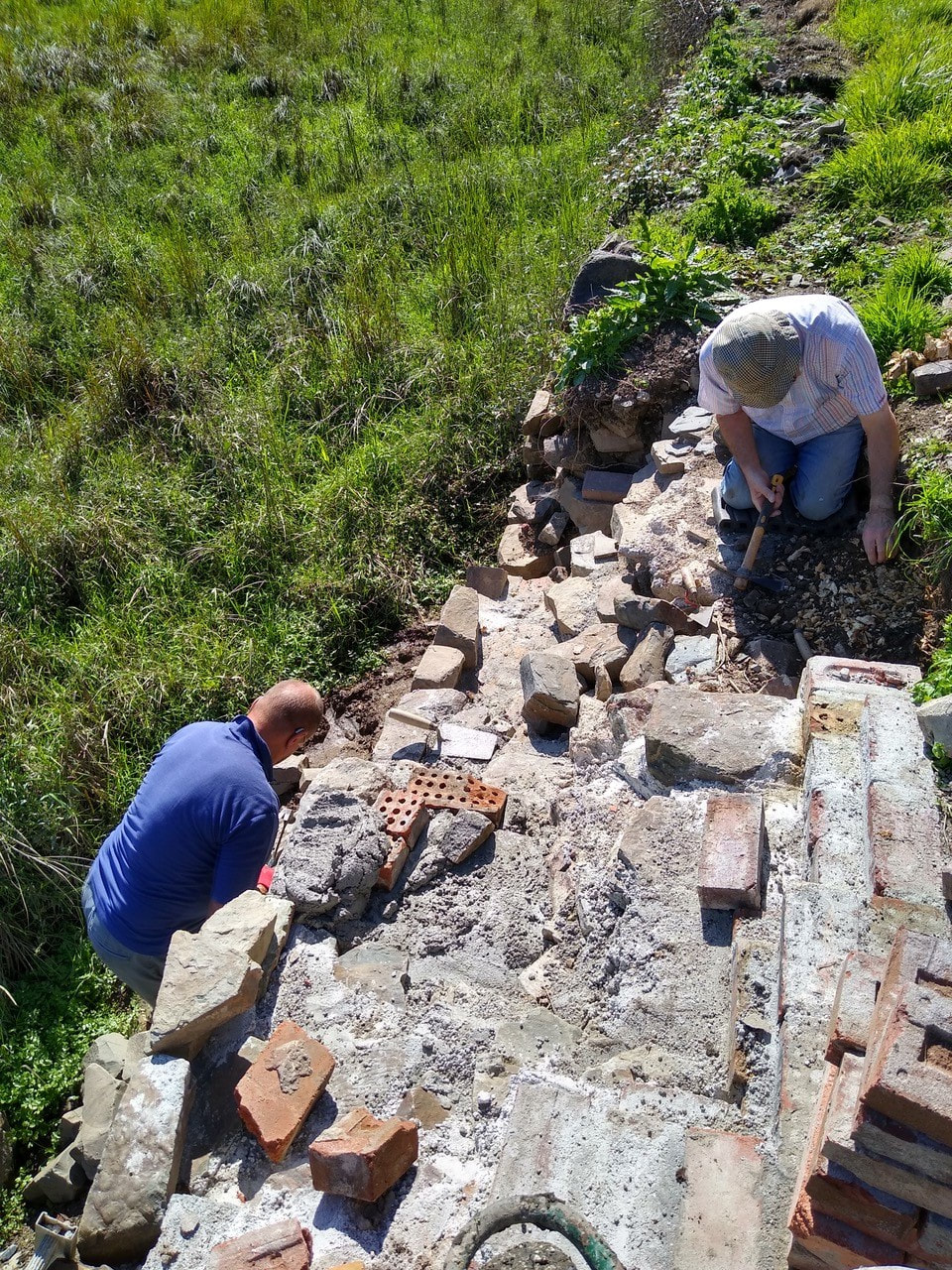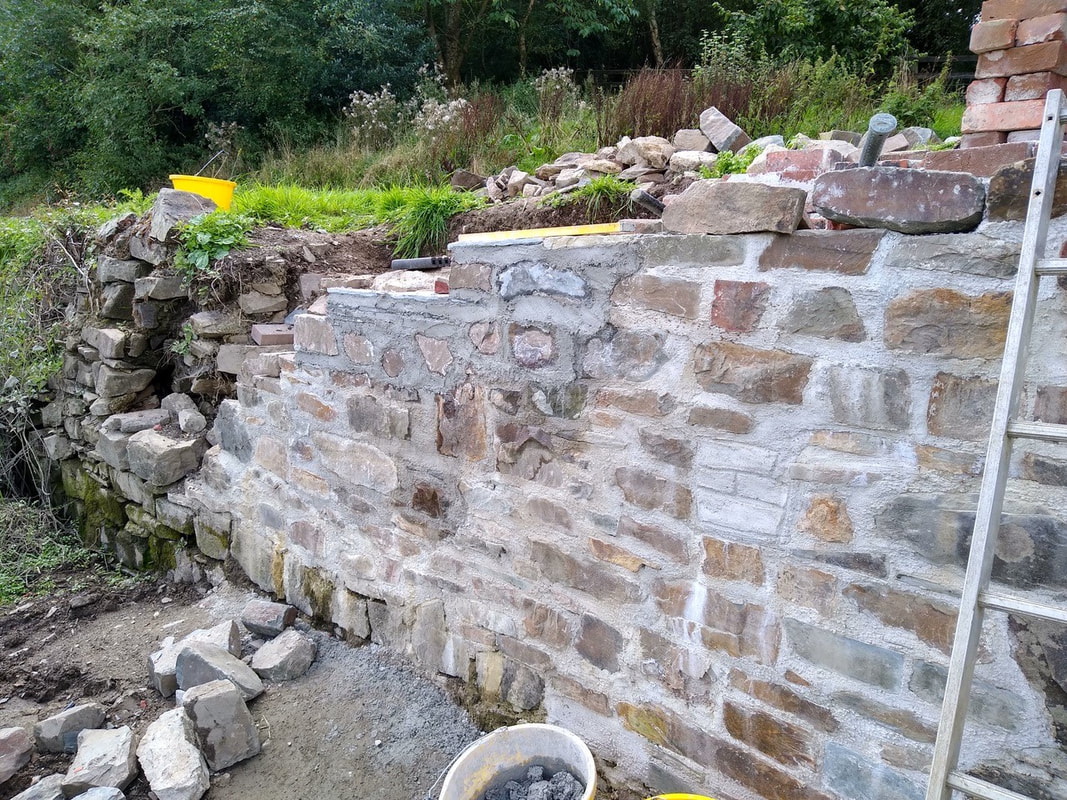September News
ROSEMOOR RESTORATION - Report by Tony Nicholls - 30th September 2020
The weather forecast was spot-on today and the early drizzle turned into sustained rain for the rest of the morning which hampered work on site. However, we have a weather-hardened team of navvies who worked on stoically in miserable conditions.
The weather forecast was spot-on today and the early drizzle turned into sustained rain for the rest of the morning which hampered work on site. However, we have a weather-hardened team of navvies who worked on stoically in miserable conditions.
The repairs and re-pointing of the west wall of the lime kiln have made a huge difference not only in terms of making the structure safer but also with regard to its general appearance. Once the new material has weathered in it should blend well with the original stonework. The scaffolding now needs to be raised to enable us to continue the restoration at a higher level.
|
Repairs to the base of the arch
We therefore turned our attention to repairing the large archway in the west wall which is in poor condition. This has been a cause of concern for some time as, if the arch were to fail, it would bring down a significant part of the structure. Fortunately, we are still unearthing some substantial building stone from our 'quarry' and this is providing an excellent foundation on which to re-build. |
We also continued to attack the huge tree stump in the tucking mill but this is proving to be a bigger challenge than we originally thought. Even with the benefit of a chain saw, we are struggling to cut through the massive root system but we soldier on...
Working arrangements may vary in the immediate future as a result of the coronavirus epidemic. Anyone wishing to volunteer should contact Project Manager, Ian Harrison (tel.01237- 475707) or Treasurer, Tony Barnes (tel. 01237-473801) for up-to-date information.
GOING UP and COMING DOWN - Alternatively 'LITTLE and LARGE'
More ramblings from Sea Lock by Adrian Wills - 30th September 2020
Yesterday Trevor and I were joined once again by Michael Elliot at Sea Lock. Continuing to clean used bricks for recycling, Michael also kept me well supplied with mortar whilst Trevor and I concentrated on repairing the section of wharf wall which we have been working on for quite some time now. The problem is that as fast as I can rebuild new stone work, a little further along Trevor is demolishing the wall with gay abandon! I’m not quite sure whose side he is on!
Having finally cleared massive tree roots, he has been ripping out ancient bramble roots which are nearly as thick and strong as the steel ropes on the cranes.
Unfortunately the stretch we are approaching has suffered a great deal of damage not only by invasive vegetation but by deliberate breaching when heavy-duty electricity power lines were installed, crossing underneath the river, our adjacent marsh and the canal sometime back in the 1970s (?). The canal was no longer operative at this time so little care was put to rebuilding the breached wall as it should have been. This is going to be a massive job for us.
More ramblings from Sea Lock by Adrian Wills - 30th September 2020
Yesterday Trevor and I were joined once again by Michael Elliot at Sea Lock. Continuing to clean used bricks for recycling, Michael also kept me well supplied with mortar whilst Trevor and I concentrated on repairing the section of wharf wall which we have been working on for quite some time now. The problem is that as fast as I can rebuild new stone work, a little further along Trevor is demolishing the wall with gay abandon! I’m not quite sure whose side he is on!
Having finally cleared massive tree roots, he has been ripping out ancient bramble roots which are nearly as thick and strong as the steel ropes on the cranes.
Unfortunately the stretch we are approaching has suffered a great deal of damage not only by invasive vegetation but by deliberate breaching when heavy-duty electricity power lines were installed, crossing underneath the river, our adjacent marsh and the canal sometime back in the 1970s (?). The canal was no longer operative at this time so little care was put to rebuilding the breached wall as it should have been. This is going to be a massive job for us.
In the meantime I have been casting more coping ‘stones’. Whilst they are actually no more than concrete blocks, I try to make them look more stone-like by deliberately making them different sizes and distressing the showing faces. The day after casting the concrete, whilst it is still very ‘green’, I remove the shuttering and begin the distressing process. First I shout abuse at the block (and if you believe that you’ll believe anything!) then I attack it with a trowel and wire brush, hacking off bits.
I could cast the blocks in situ directly on top of the wall but working on the assumption that one day when someone with millions of pounds to spare decides to replace the coping with real stone, removing my fakes will be less destructive to the wall than otherwise. Ever the optimist!
I could cast the blocks in situ directly on top of the wall but working on the assumption that one day when someone with millions of pounds to spare decides to replace the coping with real stone, removing my fakes will be less destructive to the wall than otherwise. Ever the optimist!
ROSEMOOR RESTORATION - Report by Michael Elliott - 23rd September 2020
Various volunteers came and went this week at Rosemoor, due to other commitments. Meanwhile, work continued on repointing the lime kiln wall, and tackling the large tree stump at the tucking mill. The stump is still more of an immovable object than we are an irresistible force.
Various volunteers came and went this week at Rosemoor, due to other commitments. Meanwhile, work continued on repointing the lime kiln wall, and tackling the large tree stump at the tucking mill. The stump is still more of an immovable object than we are an irresistible force.
Then at the coffee break there was an unexpected visit from Rusty, bearing a giant chocolate cake made by Lindy (and table cloth, how standards slip in his absence!) Unfortunately this did not signal a return to the team, due to his work commitments.
Later, a couple of the volunteers went off towards the weir to inspect the leak in the canal bed, battling through the new growth on the tow path (sorry, no pictures). It seems that a culvert under the canal has collapsed. It will take some planning to work out how to fix it.
WORKING PARTY AT SEA LOCK - Report by Michael Elliott - 22nd September 2020
This week Sea Lock was enjoying a very high tide. Work focussed on the area of the drainage pipe through the wharf wall, working from above until the tide had fallen enough to allow working from the muddy canal side. A bed of concrete was first laid to act as a foundation for the next section of pipe, which was then lowered by crane and mortared into place. This pipe section has a larger bore, and slipped over the end of the other pipe. It will need to be sealed to it in due course. A final section of pipe was then cut at an angle to align with the edge of the wall, ready for fitting.
This week Sea Lock was enjoying a very high tide. Work focussed on the area of the drainage pipe through the wharf wall, working from above until the tide had fallen enough to allow working from the muddy canal side. A bed of concrete was first laid to act as a foundation for the next section of pipe, which was then lowered by crane and mortared into place. This pipe section has a larger bore, and slipped over the end of the other pipe. It will need to be sealed to it in due course. A final section of pipe was then cut at an angle to align with the edge of the wall, ready for fitting.
GETTING DOWN AND DIRTY - Alternate title 'MAKING MUD PIES'
More ramblings from Sea Lock by Adrian Wills - 18th September 2020
Yesterday Trevor and I had a change from doing battle with loose masonry and never-ending roots. The early morning tides are high at the moment making where we were working, standing down inside the wharf basin, muddy and slippery so we decided to set-to removing some of the silt from the outer lock chamber once the tide had fallen. With Trevor acting as ‘banksman’ I moved the 22 Ruston Bucyrus crane into a position where I could lower the clamshell bucket into the lock chamber and begin removing accumulated silt.
More ramblings from Sea Lock by Adrian Wills - 18th September 2020
Yesterday Trevor and I had a change from doing battle with loose masonry and never-ending roots. The early morning tides are high at the moment making where we were working, standing down inside the wharf basin, muddy and slippery so we decided to set-to removing some of the silt from the outer lock chamber once the tide had fallen. With Trevor acting as ‘banksman’ I moved the 22 Ruston Bucyrus crane into a position where I could lower the clamshell bucket into the lock chamber and begin removing accumulated silt.
From my operator’s seat in the crane’s cab I cannot see where the bucket is once lowered into the chamber hence the need for a banksman whose job it is to watch the operation and direct the driver by means of hand signals as to where to go and what to do! The banksman has to position him/herself in a safe place where both he/she can see the driver clearly. Trevor, gesticulating vigorously, was on the opposite side of the lock chamber from where I was in the crane. I’m not sure that all of his signals were polite but I believe him to be a gentleman!
Later in the day we were joined by Norman who used the Fergie tractor to move a load of logs and then the Kubota tractor on a couple of other different tasks.
All in all it was a very productive day enhanced by beautiful weather.
All in all it was a very productive day enhanced by beautiful weather.
WORKING PARTY AT SEA LOCK - Report by Michael Elliott - 15th September 2020
Back at Sea Lock after a week away saw a newly cast coping stone into place, waiting to be mortared. In addition, the displaced drain and underlying tree root had been removed and the feeble pallet holding the paving slabs had collapsed on being moved. So work knuckled down to mixing mortar and clearing more soil from the drain pipe. The coping stone was duly mortared into place on the inside, with further building up of the wharf wall. This all requires prodigious quantities of mortar, given the thickness of the wall. Eventually, un-forecast rain stopped work in time for an early lunch.
Back at Sea Lock after a week away saw a newly cast coping stone into place, waiting to be mortared. In addition, the displaced drain and underlying tree root had been removed and the feeble pallet holding the paving slabs had collapsed on being moved. So work knuckled down to mixing mortar and clearing more soil from the drain pipe. The coping stone was duly mortared into place on the inside, with further building up of the wharf wall. This all requires prodigious quantities of mortar, given the thickness of the wall. Eventually, un-forecast rain stopped work in time for an early lunch.
ROSEMOOR RESTORATION - Report by Tony Nicholls - 16th September 2020
A veil of mist covered RHS Rosemoor when we arrived on site this week. Fortunately, this soon cleared and we were able to work in dry conditions for the rest of the day.
We split into two teams, one to continue with repairs to the wall of lime kiln, the other to take forward the ongoing excavation of the tucking mill.
A plentiful supply of stone enabled our masons to make good progress restoring the west wall of the lime kiln. We have now raised the re-build by about four feet and stabilised the badly damaged section. In another week or so we will need to lift the scaffold to enable us to repair the higher parts of the wall.
A veil of mist covered RHS Rosemoor when we arrived on site this week. Fortunately, this soon cleared and we were able to work in dry conditions for the rest of the day.
We split into two teams, one to continue with repairs to the wall of lime kiln, the other to take forward the ongoing excavation of the tucking mill.
A plentiful supply of stone enabled our masons to make good progress restoring the west wall of the lime kiln. We have now raised the re-build by about four feet and stabilised the badly damaged section. In another week or so we will need to lift the scaffold to enable us to repair the higher parts of the wall.
Work on the tucking mill is being hampered by the presence of a massive tree stump which has grown over the foundation of one of the walls. There are huge roots radiating from the base of the stump, all of which need to be exposed and severed before the stump can be removed. Fortunately, one of our team is a trained chain saw operator which made this process much swifter than it would have otherwise been. However, it will probably take another two to three weeks to (literally) eradicate this monster and allow further exploration of the site.
Working arrangements may vary in the immediate future as a result of the coronavirus epidemic. Anyone wishing to volunteer should contact Project Manager, Ian Harrison (tel.01237- 475707) or Treasurer, Tony Barnes (tel. 01237-473801) for up-to-date information.
'ROOT TO HELL' with apologies to Chris Rea - 'Road to Hell'
More ramblings from Sea Lock by Adrian Wills - 17th September 2020
When in my early teens I read a book, amongst others, by the renowned Sci-Fi author Jules Verne, entitled ‘Journey to the Centre of the Earth’. Great story but rubbish subsequent films. Now, many years later, I am considering writing a sequel entitled ‘Journey to the Centre of the Wall’.
Following on from work that Trevor and I were doing on the wharf-side wall at Sea Lock to rebuild a collapsed section caused by invasive vegetation, today I continued to prepare this by removing more loose masonry and soil which had filled the spaces left by washed out mortar.
Large, dead roots which we had slowly been removing, bit by bit, continued to burrow down into the wall. Every time I thought that I had reached a point at which I could safely start rebuilding, another stone became loose and another length of root could be seen disappearing down into the depths of the wall, the hole in the wall was becoming wider and deeper by the minute!
Trevor had cleared back around the drainage pipe (refer to previous reports) for several inches. The section of pipe we had removed was still intact but had lost most of its connecting lip making it difficult to reinstate with a waterproof joint. Whilst I didn’t have any spare pipe of that diameter I did have a number of sections of larger diameter which would nicely sleeve over the undisturbed pipe. I had previously managed to remove a considerable amount of silt built-up inside this pipe using a 4 metre length of plastic gutter as a long auger to extract it. The pipe is now clear and clean for at least that length. Whether water starts to flow out of it now, following heavy rainfall, is another matter!
Hopefully not too much more wall will need to be demolished before the new lengths of pipe can be reinstated and excess land-water drains away directly to the outside of the canal walls.
Somehow I don’t think my sequel will have the same impact on the literary world as Jules Verne achieved! What do you think?
More ramblings from Sea Lock by Adrian Wills - 17th September 2020
When in my early teens I read a book, amongst others, by the renowned Sci-Fi author Jules Verne, entitled ‘Journey to the Centre of the Earth’. Great story but rubbish subsequent films. Now, many years later, I am considering writing a sequel entitled ‘Journey to the Centre of the Wall’.
Following on from work that Trevor and I were doing on the wharf-side wall at Sea Lock to rebuild a collapsed section caused by invasive vegetation, today I continued to prepare this by removing more loose masonry and soil which had filled the spaces left by washed out mortar.
Large, dead roots which we had slowly been removing, bit by bit, continued to burrow down into the wall. Every time I thought that I had reached a point at which I could safely start rebuilding, another stone became loose and another length of root could be seen disappearing down into the depths of the wall, the hole in the wall was becoming wider and deeper by the minute!
Trevor had cleared back around the drainage pipe (refer to previous reports) for several inches. The section of pipe we had removed was still intact but had lost most of its connecting lip making it difficult to reinstate with a waterproof joint. Whilst I didn’t have any spare pipe of that diameter I did have a number of sections of larger diameter which would nicely sleeve over the undisturbed pipe. I had previously managed to remove a considerable amount of silt built-up inside this pipe using a 4 metre length of plastic gutter as a long auger to extract it. The pipe is now clear and clean for at least that length. Whether water starts to flow out of it now, following heavy rainfall, is another matter!
Hopefully not too much more wall will need to be demolished before the new lengths of pipe can be reinstated and excess land-water drains away directly to the outside of the canal walls.
Somehow I don’t think my sequel will have the same impact on the literary world as Jules Verne achieved! What do you think?
COMING UP AND YET GOING DOWN - Ramblings from Sea Lock by Adrian Wills - 11th September 2020
Yesterday Trevor and I concentrated on the section of wharf wall where we had previously removed a substantial dead tree and roots. Unfortunately the roots had deeply penetrated the wall creating massive movement in the masonry. We were working around the recently rediscovered land-drain which runs across the towpath and empties into the basin, or should do! The drain which had been installed long before any restoration began, had become completely overgrown and lost from sight but I do remember seeing it years ago with water running out of it and that hasn’t happened for quite a time. We soon discovered the reason why not and both thought of the same expression – we were finally getting to ‘the root of the problem’!
Yesterday Trevor and I concentrated on the section of wharf wall where we had previously removed a substantial dead tree and roots. Unfortunately the roots had deeply penetrated the wall creating massive movement in the masonry. We were working around the recently rediscovered land-drain which runs across the towpath and empties into the basin, or should do! The drain which had been installed long before any restoration began, had become completely overgrown and lost from sight but I do remember seeing it years ago with water running out of it and that hasn’t happened for quite a time. We soon discovered the reason why not and both thought of the same expression – we were finally getting to ‘the root of the problem’!
A large root which we had been tracing through the wall and removing bit by bit, had grown under the last section of the precast concrete pipe, slowly and inexorably (that’s a good word for this time of the day!) pushing it upwards until it was about 4 inches higher at the outer end than where it should have been when linked to the section behind it further into the wall. Where these 2 pipes joined but became separated, is just behind the back of the wall so any water running along the pipe would have been flowing down the inside of the wall resulting in the lime mortar between the stones leaching out and the wall eventually collapsing. This broken joint can be seen in a picture taken by Michael Elliot and shown in his Tuesday’s report on Sea Lock.
Before more reconstruction could take place we had to demolish a lot of loose, unstable masonry and a large quantity of mud which had accumulated where the mortar should have been. By the end of the day we had lifted out the last section of pipe using the Priestman Cub to raise it and created a significant hole around where the pipe should have been. The pipe will need to be reconnected properly to its neighbour and the space around carefully rebuilt before we can attack the next wobbly bit of wall which still has a length of root beneath it! In the meantime we have run out of hydraulic lime again.
Before more reconstruction could take place we had to demolish a lot of loose, unstable masonry and a large quantity of mud which had accumulated where the mortar should have been. By the end of the day we had lifted out the last section of pipe using the Priestman Cub to raise it and created a significant hole around where the pipe should have been. The pipe will need to be reconnected properly to its neighbour and the space around carefully rebuilt before we can attack the next wobbly bit of wall which still has a length of root beneath it! In the meantime we have run out of hydraulic lime again.
WORKING PARTY AT SEA LOCK - Report by Michael Elliott - 8th September 2020
Arrival at Sea Lock on Tuesday saw the weather dull but mild, perfect for hard work, starting with stacking paving slabs on a pallet that hardly seemed up to the job. Take a tip from me, if you are planning a patio, buy smaller slabs.
Arrival at Sea Lock on Tuesday saw the weather dull but mild, perfect for hard work, starting with stacking paving slabs on a pallet that hardly seemed up to the job. Take a tip from me, if you are planning a patio, buy smaller slabs.
|
More precision adjustments were then needed to the crane so the slabs can be moved to somewhere more convenient. Work on the wharf wall continued with stone, bricks and mortar, and clearing mud off the top to expose more of a pipe running through the wall. This revealed the need for more dismantling of unstable stones so building could continue. |
ROSEMOOR RESTORATION - Report by Tony Nicholls - 2nd September 2020
A dull, overcast day today but thankfully the rain held off until lunch time so we were able to accomplish a number of tasks while we were on site.
A dull, overcast day today but thankfully the rain held off until lunch time so we were able to accomplish a number of tasks while we were on site.
Our masons continued to re-build the western wall of the lime kiln. Work is progressing well and we have successfully stabilised this corner of the building. We have tried to give an indication of the point at which the base of the arch which would have projected southwards to join the external wall (whose foundations we have reconstructed in outline). We intend to take the reconstruction upwards another 3 feet or so and then extend the re-build along the western wall to secure another badly damaged section. This will entail raising the scaffolding to allow us to work at a higher level. Another member of the team re-pointed some of the stonework under the southern arch of the lime kiln where there were a number of cracks which needed infilling. The work we have carried out at this end of the structure has not only secured the fabric of the building but has greatly improved its appearance as can be seen from the photos. We hope that RHS Rosemoor will undertake the annual 'haircut' of the lime kiln in the near future as this is becoming very overgrown with shrubs and saplings.
Arch before repointing
Arch after repointing
Repaired south eastern corner of lime kiln
We also spent some time tidying up the tucking mill site as this was starting to disappear under various stone piles and did a bit of much-needed weeding. We continued our excavations in the south-eastern corner of the site and, after removing the inevitable, troublesome tree stump, exposed some more of the recently discovered foundation wall which suggests the presence of another room. We are now working in an area that had many mature trees growing in it so progress is likely to be hampered by more tree roots. Fortunately, our navvies are now hugely experienced at tackling such obstacles!
Exposed foundation of wall
Working arrangements may vary in the immediate future as a result of the coronavirus epidemic. Anyone wishing to volunteer should contact Project Manager, Ian Harrison (tel.01237- 475707) or Treasurer, Tony Barnes (tel. 01237-473801) for up-to-date information.
WORKING PARTY AT SEA LOCK - Report by Michael Elliott - 1st September 2020
The day at Sealock started autumnal but soon warmed up. The work on the wharf wall so far looks good, but there is still lots to do. Tasks for the day were to continue to clear and rebuild the wall, involving mixing mortar and moving broken brick for backfill, and to fix the small crane. Its bucket had been changed for the hook, but the hook’s lesser weight meant it would not descend on command, only go up!
There were also mud deposits removed from the canal bed by crane the previous week to move, to fill in hollows on the wharf side.

